Assessment Instructions for BSBLDR502
VerifiedAdded on 2023/02/01
|70
|12292
|91
AI Summary
This document provides assessment instructions for BSBLDR502: Lead and manage effective workplace relationships. It includes an overview of the assessment tasks, terms and conditions, and submission requirements. Learners are advised to carefully read and understand the instructions before starting the assessments.
Contribute Materials
Your contribution can guide someone’s learning journey. Share your
documents today.

Secure Best Marks with AI Grader
Need help grading? Try our AI Grader for instant feedback on your assignments.

1. Table of Contents
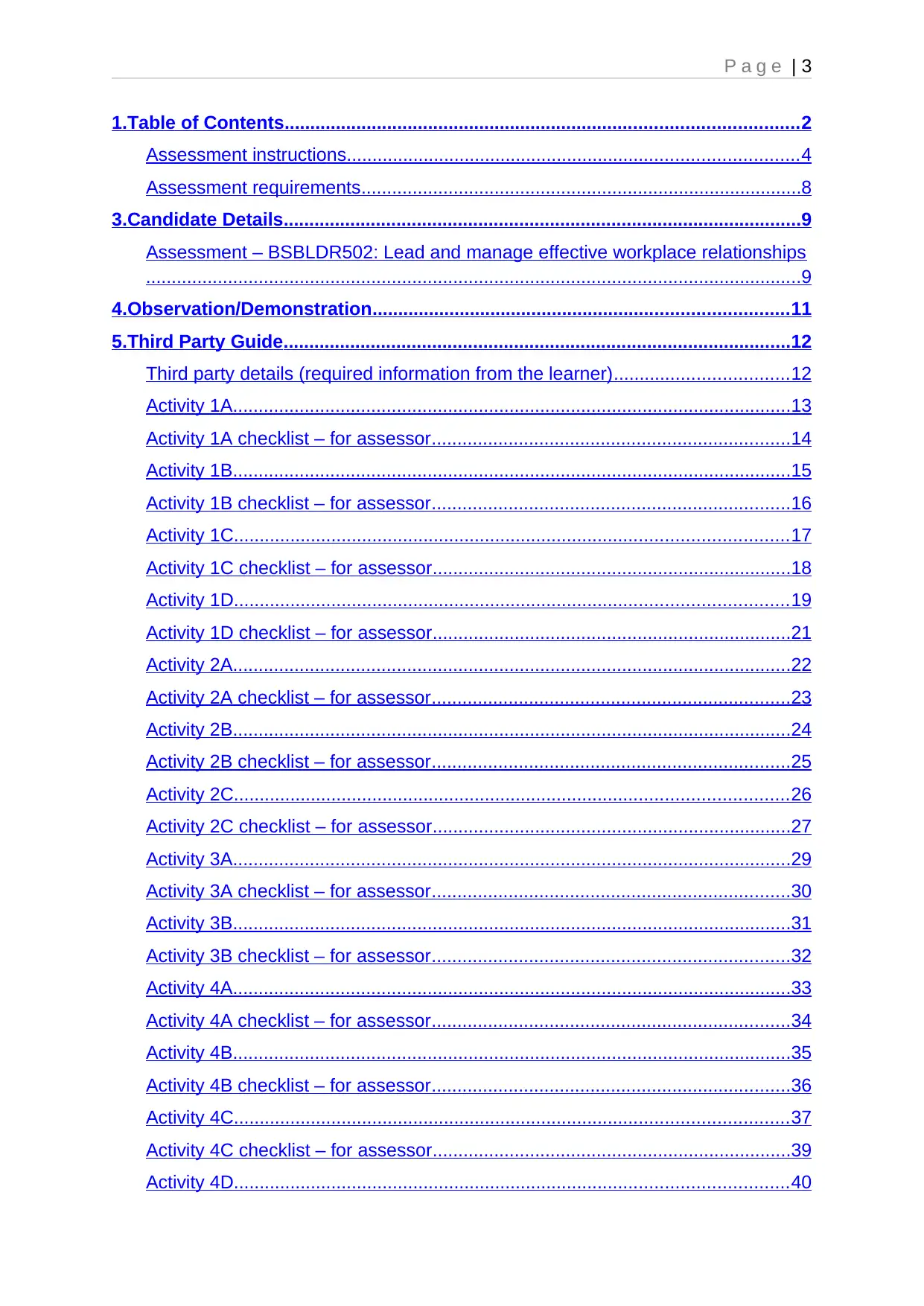
P a g e | 3
1.Table of Contents....................................................................................................2
Assessment instructions........................................................................................4
Assessment requirements......................................................................................8
3.Candidate Details.....................................................................................................9
Assessment – BSBLDR502: Lead and manage effective workplace relationships
................................................................................................................................9
4.Observation/Demonstration.................................................................................11
5.Third Party Guide...................................................................................................12
Third party details (required information from the learner)..................................12
Activity 1A.............................................................................................................13
Activity 1A checklist – for assessor......................................................................14
Activity 1B.............................................................................................................15
Activity 1B checklist – for assessor......................................................................16
Activity 1C............................................................................................................17
Activity 1C checklist – for assessor......................................................................18
Activity 1D............................................................................................................19
Activity 1D checklist – for assessor......................................................................21
Activity 2A.............................................................................................................22
Activity 2A checklist – for assessor......................................................................23
Activity 2B.............................................................................................................24
Activity 2B checklist – for assessor......................................................................25
Activity 2C............................................................................................................26
Activity 2C checklist – for assessor......................................................................27
Activity 3A.............................................................................................................29
Activity 3A checklist – for assessor......................................................................30
Activity 3B.............................................................................................................31
Activity 3B checklist – for assessor......................................................................32
Activity 4A.............................................................................................................33
Activity 4A checklist – for assessor......................................................................34
Activity 4B.............................................................................................................35
Activity 4B checklist – for assessor......................................................................36
Activity 4C............................................................................................................37
Activity 4C checklist – for assessor......................................................................39
Activity 4D............................................................................................................40
1.Table of Contents....................................................................................................2
Assessment instructions........................................................................................4
Assessment requirements......................................................................................8
3.Candidate Details.....................................................................................................9
Assessment – BSBLDR502: Lead and manage effective workplace relationships
................................................................................................................................9
4.Observation/Demonstration.................................................................................11
5.Third Party Guide...................................................................................................12
Third party details (required information from the learner)..................................12
Activity 1A.............................................................................................................13
Activity 1A checklist – for assessor......................................................................14
Activity 1B.............................................................................................................15
Activity 1B checklist – for assessor......................................................................16
Activity 1C............................................................................................................17
Activity 1C checklist – for assessor......................................................................18
Activity 1D............................................................................................................19
Activity 1D checklist – for assessor......................................................................21
Activity 2A.............................................................................................................22
Activity 2A checklist – for assessor......................................................................23
Activity 2B.............................................................................................................24
Activity 2B checklist – for assessor......................................................................25
Activity 2C............................................................................................................26
Activity 2C checklist – for assessor......................................................................27
Activity 3A.............................................................................................................29
Activity 3A checklist – for assessor......................................................................30
Activity 3B.............................................................................................................31
Activity 3B checklist – for assessor......................................................................32
Activity 4A.............................................................................................................33
Activity 4A checklist – for assessor......................................................................34
Activity 4B.............................................................................................................35
Activity 4B checklist – for assessor......................................................................36
Activity 4C............................................................................................................37
Activity 4C checklist – for assessor......................................................................39
Activity 4D............................................................................................................40
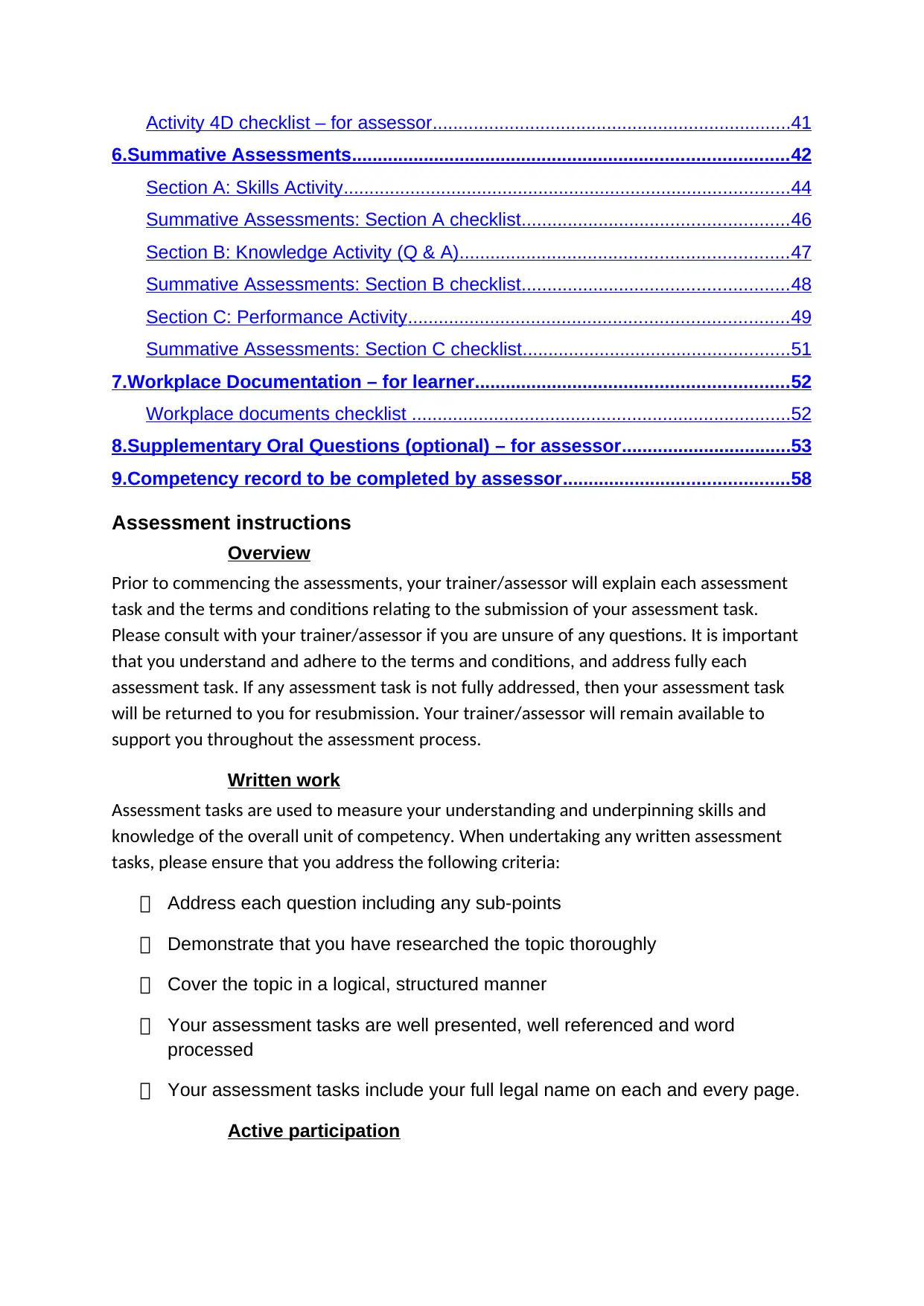
Activity 4D checklist – for assessor......................................................................41
6.Summative Assessments.....................................................................................42
Section A: Skills Activity.......................................................................................44
Summative Assessments: Section A checklist....................................................46
Section B: Knowledge Activity (Q & A)................................................................47
Summative Assessments: Section B checklist....................................................48
Section C: Performance Activity..........................................................................49
Summative Assessments: Section C checklist....................................................51
7.Workplace Documentation – for learner.............................................................52
Workplace documents checklist ..........................................................................52
8.Supplementary Oral Questions (optional) – for assessor.................................53
9.Competency record to be completed by assessor............................................58
Assessment instructions
Overview
Prior to commencing the assessments, your trainer/assessor will explain each assessment
task and the terms and conditions relating to the submission of your assessment task.
Please consult with your trainer/assessor if you are unsure of any questions. It is important
that you understand and adhere to the terms and conditions, and address fully each
assessment task. If any assessment task is not fully addressed, then your assessment task
will be returned to you for resubmission. Your trainer/assessor will remain available to
support you throughout the assessment process.
Written work
Assessment tasks are used to measure your understanding and underpinning skills and
knowledge of the overall unit of competency. When undertaking any written assessment
tasks, please ensure that you address the following criteria:
Address each question including any sub-points
Demonstrate that you have researched the topic thoroughly
Cover the topic in a logical, structured manner
Your assessment tasks are well presented, well referenced and word
processed
Your assessment tasks include your full legal name on each and every page.
Active participation
6.Summative Assessments.....................................................................................42
Section A: Skills Activity.......................................................................................44
Summative Assessments: Section A checklist....................................................46
Section B: Knowledge Activity (Q & A)................................................................47
Summative Assessments: Section B checklist....................................................48
Section C: Performance Activity..........................................................................49
Summative Assessments: Section C checklist....................................................51
7.Workplace Documentation – for learner.............................................................52
Workplace documents checklist ..........................................................................52
8.Supplementary Oral Questions (optional) – for assessor.................................53
9.Competency record to be completed by assessor............................................58
Assessment instructions
Overview
Prior to commencing the assessments, your trainer/assessor will explain each assessment
task and the terms and conditions relating to the submission of your assessment task.
Please consult with your trainer/assessor if you are unsure of any questions. It is important
that you understand and adhere to the terms and conditions, and address fully each
assessment task. If any assessment task is not fully addressed, then your assessment task
will be returned to you for resubmission. Your trainer/assessor will remain available to
support you throughout the assessment process.
Written work
Assessment tasks are used to measure your understanding and underpinning skills and
knowledge of the overall unit of competency. When undertaking any written assessment
tasks, please ensure that you address the following criteria:
Address each question including any sub-points
Demonstrate that you have researched the topic thoroughly
Cover the topic in a logical, structured manner
Your assessment tasks are well presented, well referenced and word
processed
Your assessment tasks include your full legal name on each and every page.
Active participation
Secure Best Marks with AI Grader
Need help grading? Try our AI Grader for instant feedback on your assignments.
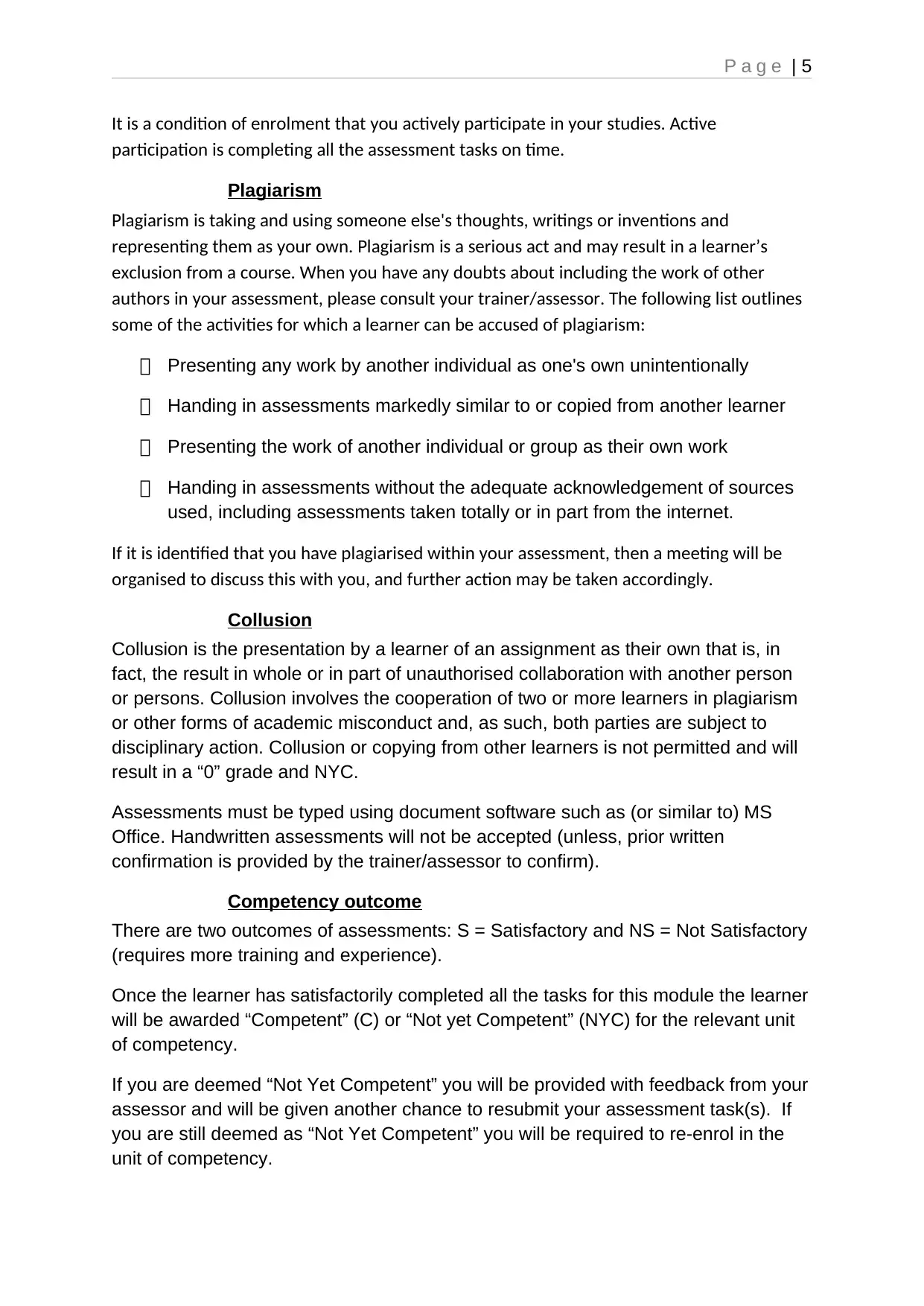
P a g e | 5
It is a condition of enrolment that you actively participate in your studies. Active
participation is completing all the assessment tasks on time.
Plagiarism
Plagiarism is taking and using someone else's thoughts, writings or inventions and
representing them as your own. Plagiarism is a serious act and may result in a learner’s
exclusion from a course. When you have any doubts about including the work of other
authors in your assessment, please consult your trainer/assessor. The following list outlines
some of the activities for which a learner can be accused of plagiarism:
Presenting any work by another individual as one's own unintentionally
Handing in assessments markedly similar to or copied from another learner
Presenting the work of another individual or group as their own work
Handing in assessments without the adequate acknowledgement of sources
used, including assessments taken totally or in part from the internet.
If it is identified that you have plagiarised within your assessment, then a meeting will be
organised to discuss this with you, and further action may be taken accordingly.
Collusion
Collusion is the presentation by a learner of an assignment as their own that is, in
fact, the result in whole or in part of unauthorised collaboration with another person
or persons. Collusion involves the cooperation of two or more learners in plagiarism
or other forms of academic misconduct and, as such, both parties are subject to
disciplinary action. Collusion or copying from other learners is not permitted and will
result in a “0” grade and NYC.
Assessments must be typed using document software such as (or similar to) MS
Office. Handwritten assessments will not be accepted (unless, prior written
confirmation is provided by the trainer/assessor to confirm).
Competency outcome
There are two outcomes of assessments: S = Satisfactory and NS = Not Satisfactory
(requires more training and experience).
Once the learner has satisfactorily completed all the tasks for this module the learner
will be awarded “Competent” (C) or “Not yet Competent” (NYC) for the relevant unit
of competency.
If you are deemed “Not Yet Competent” you will be provided with feedback from your
assessor and will be given another chance to resubmit your assessment task(s). If
you are still deemed as “Not Yet Competent” you will be required to re-enrol in the
unit of competency.
It is a condition of enrolment that you actively participate in your studies. Active
participation is completing all the assessment tasks on time.
Plagiarism
Plagiarism is taking and using someone else's thoughts, writings or inventions and
representing them as your own. Plagiarism is a serious act and may result in a learner’s
exclusion from a course. When you have any doubts about including the work of other
authors in your assessment, please consult your trainer/assessor. The following list outlines
some of the activities for which a learner can be accused of plagiarism:
Presenting any work by another individual as one's own unintentionally
Handing in assessments markedly similar to or copied from another learner
Presenting the work of another individual or group as their own work
Handing in assessments without the adequate acknowledgement of sources
used, including assessments taken totally or in part from the internet.
If it is identified that you have plagiarised within your assessment, then a meeting will be
organised to discuss this with you, and further action may be taken accordingly.
Collusion
Collusion is the presentation by a learner of an assignment as their own that is, in
fact, the result in whole or in part of unauthorised collaboration with another person
or persons. Collusion involves the cooperation of two or more learners in plagiarism
or other forms of academic misconduct and, as such, both parties are subject to
disciplinary action. Collusion or copying from other learners is not permitted and will
result in a “0” grade and NYC.
Assessments must be typed using document software such as (or similar to) MS
Office. Handwritten assessments will not be accepted (unless, prior written
confirmation is provided by the trainer/assessor to confirm).
Competency outcome
There are two outcomes of assessments: S = Satisfactory and NS = Not Satisfactory
(requires more training and experience).
Once the learner has satisfactorily completed all the tasks for this module the learner
will be awarded “Competent” (C) or “Not yet Competent” (NYC) for the relevant unit
of competency.
If you are deemed “Not Yet Competent” you will be provided with feedback from your
assessor and will be given another chance to resubmit your assessment task(s). If
you are still deemed as “Not Yet Competent” you will be required to re-enrol in the
unit of competency.
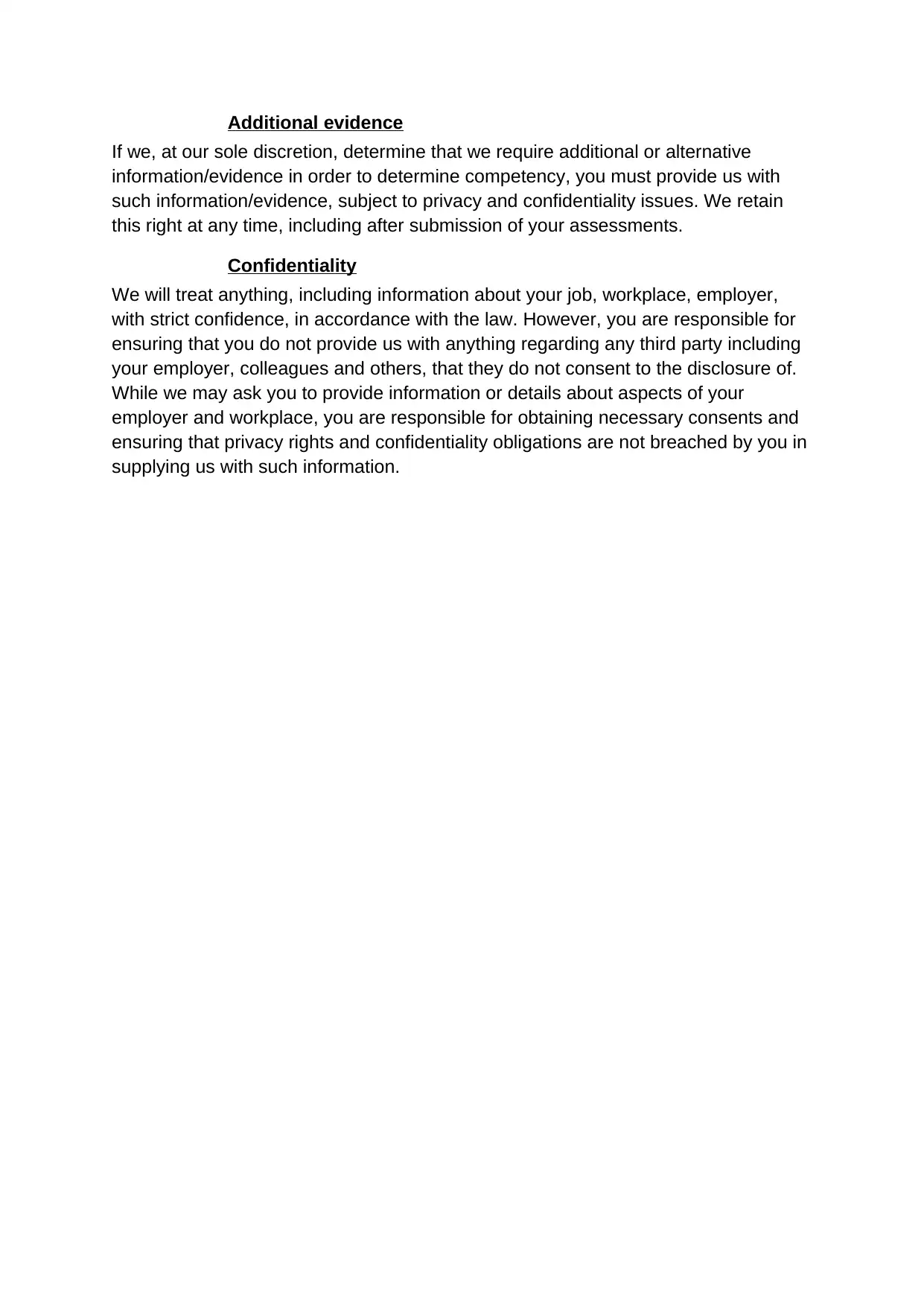
Additional evidence
If we, at our sole discretion, determine that we require additional or alternative
information/evidence in order to determine competency, you must provide us with
such information/evidence, subject to privacy and confidentiality issues. We retain
this right at any time, including after submission of your assessments.
Confidentiality
We will treat anything, including information about your job, workplace, employer,
with strict confidence, in accordance with the law. However, you are responsible for
ensuring that you do not provide us with anything regarding any third party including
your employer, colleagues and others, that they do not consent to the disclosure of.
While we may ask you to provide information or details about aspects of your
employer and workplace, you are responsible for obtaining necessary consents and
ensuring that privacy rights and confidentiality obligations are not breached by you in
supplying us with such information.
If we, at our sole discretion, determine that we require additional or alternative
information/evidence in order to determine competency, you must provide us with
such information/evidence, subject to privacy and confidentiality issues. We retain
this right at any time, including after submission of your assessments.
Confidentiality
We will treat anything, including information about your job, workplace, employer,
with strict confidence, in accordance with the law. However, you are responsible for
ensuring that you do not provide us with anything regarding any third party including
your employer, colleagues and others, that they do not consent to the disclosure of.
While we may ask you to provide information or details about aspects of your
employer and workplace, you are responsible for obtaining necessary consents and
ensuring that privacy rights and confidentiality obligations are not breached by you in
supplying us with such information.
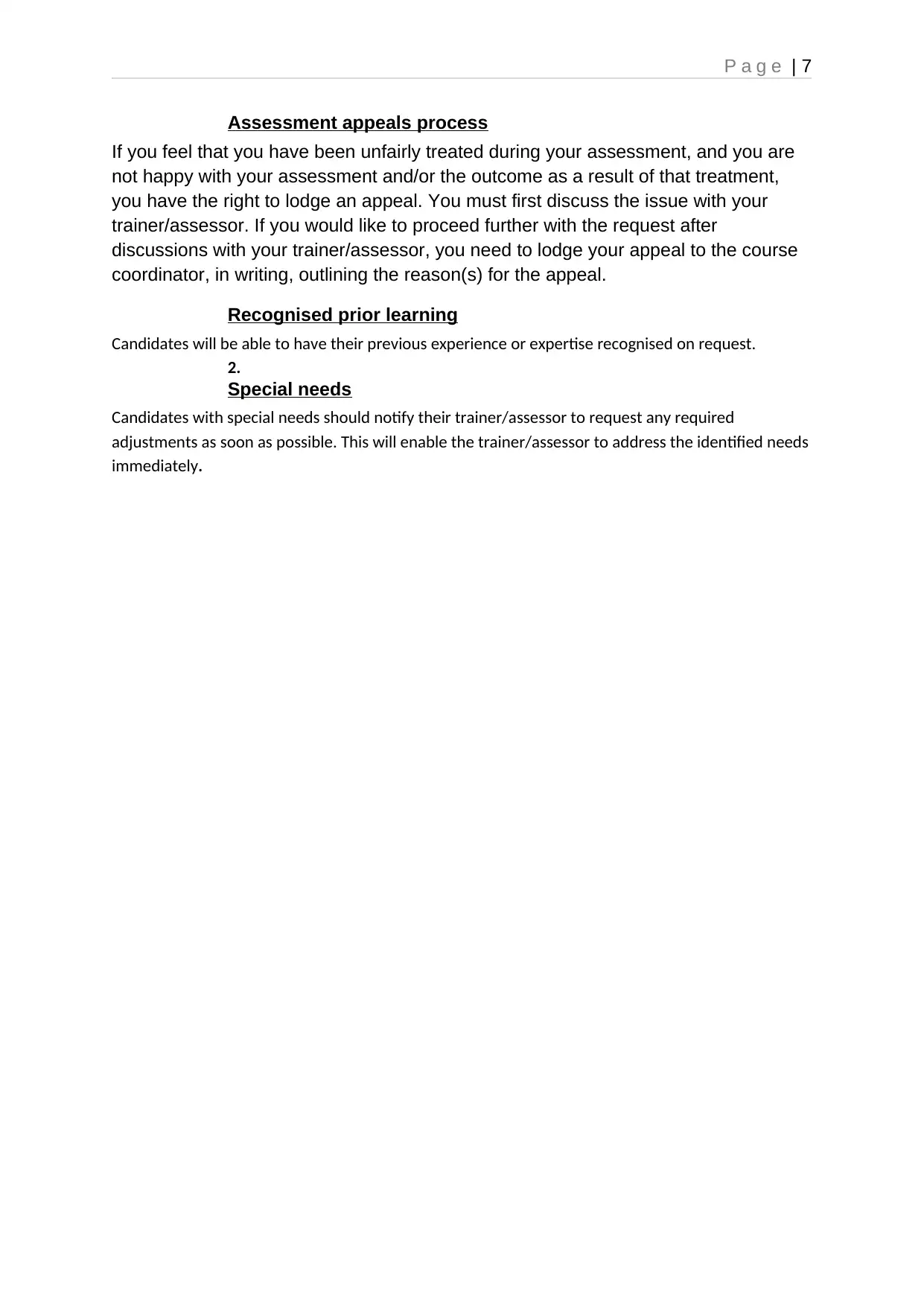
P a g e | 7
Assessment appeals process
If you feel that you have been unfairly treated during your assessment, and you are
not happy with your assessment and/or the outcome as a result of that treatment,
you have the right to lodge an appeal. You must first discuss the issue with your
trainer/assessor. If you would like to proceed further with the request after
discussions with your trainer/assessor, you need to lodge your appeal to the course
coordinator, in writing, outlining the reason(s) for the appeal.
Recognised prior learning
Candidates will be able to have their previous experience or expertise recognised on request.
2.
Special needs
Candidates with special needs should notify their trainer/assessor to request any required
adjustments as soon as possible. This will enable the trainer/assessor to address the identified needs
immediately .
Assessment appeals process
If you feel that you have been unfairly treated during your assessment, and you are
not happy with your assessment and/or the outcome as a result of that treatment,
you have the right to lodge an appeal. You must first discuss the issue with your
trainer/assessor. If you would like to proceed further with the request after
discussions with your trainer/assessor, you need to lodge your appeal to the course
coordinator, in writing, outlining the reason(s) for the appeal.
Recognised prior learning
Candidates will be able to have their previous experience or expertise recognised on request.
2.
Special needs
Candidates with special needs should notify their trainer/assessor to request any required
adjustments as soon as possible. This will enable the trainer/assessor to address the identified needs
immediately .
Paraphrase This Document
Need a fresh take? Get an instant paraphrase of this document with our AI Paraphraser
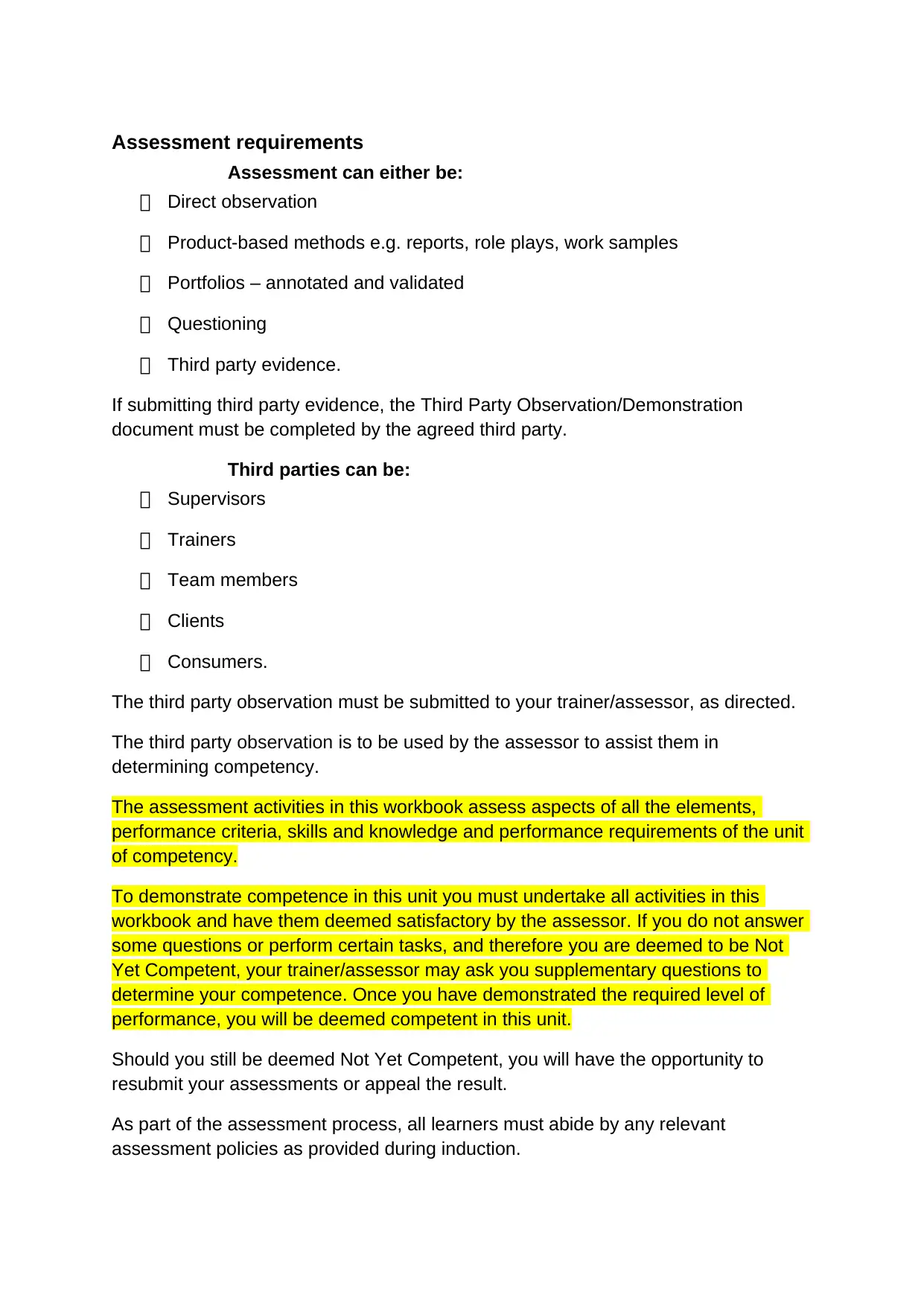
Assessment requirements
Assessment can either be:
Direct observation
Product-based methods e.g. reports, role plays, work samples
Portfolios – annotated and validated
Questioning
Third party evidence.
If submitting third party evidence, the Third Party Observation/Demonstration
document must be completed by the agreed third party.
Third parties can be:
Supervisors
Trainers
Team members
Clients
Consumers.
The third party observation must be submitted to your trainer/assessor, as directed.
The third party observation is to be used by the assessor to assist them in
determining competency.
The assessment activities in this workbook assess aspects of all the elements,
performance criteria, skills and knowledge and performance requirements of the unit
of competency.
To demonstrate competence in this unit you must undertake all activities in this
workbook and have them deemed satisfactory by the assessor. If you do not answer
some questions or perform certain tasks, and therefore you are deemed to be Not
Yet Competent, your trainer/assessor may ask you supplementary questions to
determine your competence. Once you have demonstrated the required level of
performance, you will be deemed competent in this unit.
Should you still be deemed Not Yet Competent, you will have the opportunity to
resubmit your assessments or appeal the result.
As part of the assessment process, all learners must abide by any relevant
assessment policies as provided during induction.
Assessment can either be:
Direct observation
Product-based methods e.g. reports, role plays, work samples
Portfolios – annotated and validated
Questioning
Third party evidence.
If submitting third party evidence, the Third Party Observation/Demonstration
document must be completed by the agreed third party.
Third parties can be:
Supervisors
Trainers
Team members
Clients
Consumers.
The third party observation must be submitted to your trainer/assessor, as directed.
The third party observation is to be used by the assessor to assist them in
determining competency.
The assessment activities in this workbook assess aspects of all the elements,
performance criteria, skills and knowledge and performance requirements of the unit
of competency.
To demonstrate competence in this unit you must undertake all activities in this
workbook and have them deemed satisfactory by the assessor. If you do not answer
some questions or perform certain tasks, and therefore you are deemed to be Not
Yet Competent, your trainer/assessor may ask you supplementary questions to
determine your competence. Once you have demonstrated the required level of
performance, you will be deemed competent in this unit.
Should you still be deemed Not Yet Competent, you will have the opportunity to
resubmit your assessments or appeal the result.
As part of the assessment process, all learners must abide by any relevant
assessment policies as provided during induction.
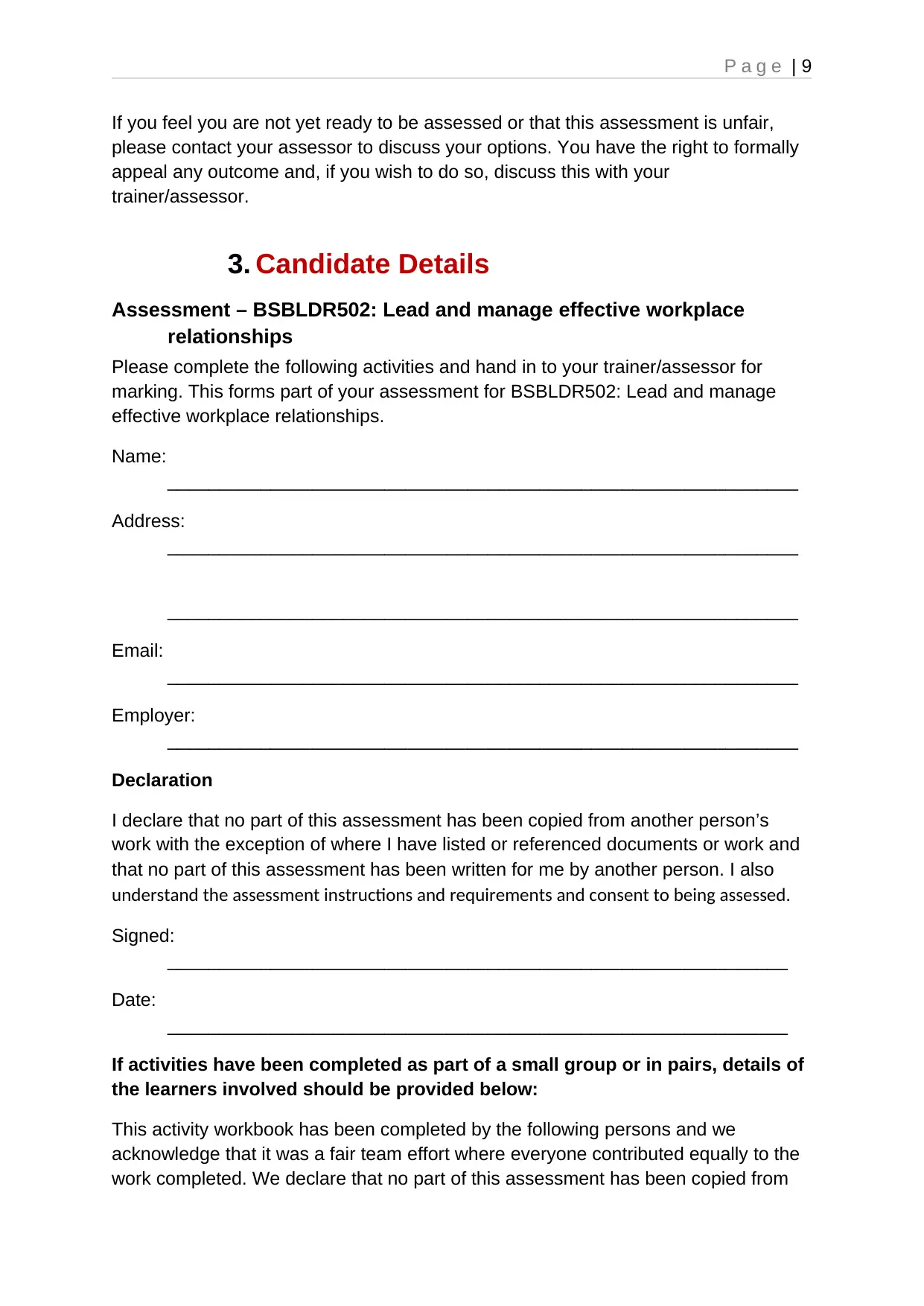
P a g e | 9
If you feel you are not yet ready to be assessed or that this assessment is unfair,
please contact your assessor to discuss your options. You have the right to formally
appeal any outcome and, if you wish to do so, discuss this with your
trainer/assessor.
3. Candidate Details
Assessment – BSBLDR502: Lead and manage effective workplace
relationships
Please complete the following activities and hand in to your trainer/assessor for
marking. This forms part of your assessment for BSBLDR502: Lead and manage
effective workplace relationships.
Name:
_____________________________________________________________
Address:
_____________________________________________________________
_____________________________________________________________
Email:
_____________________________________________________________
Employer:
_____________________________________________________________
Declaration
I declare that no part of this assessment has been copied from another person’s
work with the exception of where I have listed or referenced documents or work and
that no part of this assessment has been written for me by another person. I also
understand the assessment instructions and requirements and consent to being assessed.
Signed:
____________________________________________________________
Date:
____________________________________________________________
If activities have been completed as part of a small group or in pairs, details of
the learners involved should be provided below:
This activity workbook has been completed by the following persons and we
acknowledge that it was a fair team effort where everyone contributed equally to the
work completed. We declare that no part of this assessment has been copied from
If you feel you are not yet ready to be assessed or that this assessment is unfair,
please contact your assessor to discuss your options. You have the right to formally
appeal any outcome and, if you wish to do so, discuss this with your
trainer/assessor.
3. Candidate Details
Assessment – BSBLDR502: Lead and manage effective workplace
relationships
Please complete the following activities and hand in to your trainer/assessor for
marking. This forms part of your assessment for BSBLDR502: Lead and manage
effective workplace relationships.
Name:
_____________________________________________________________
Address:
_____________________________________________________________
_____________________________________________________________
Email:
_____________________________________________________________
Employer:
_____________________________________________________________
Declaration
I declare that no part of this assessment has been copied from another person’s
work with the exception of where I have listed or referenced documents or work and
that no part of this assessment has been written for me by another person. I also
understand the assessment instructions and requirements and consent to being assessed.
Signed:
____________________________________________________________
Date:
____________________________________________________________
If activities have been completed as part of a small group or in pairs, details of
the learners involved should be provided below:
This activity workbook has been completed by the following persons and we
acknowledge that it was a fair team effort where everyone contributed equally to the
work completed. We declare that no part of this assessment has been copied from
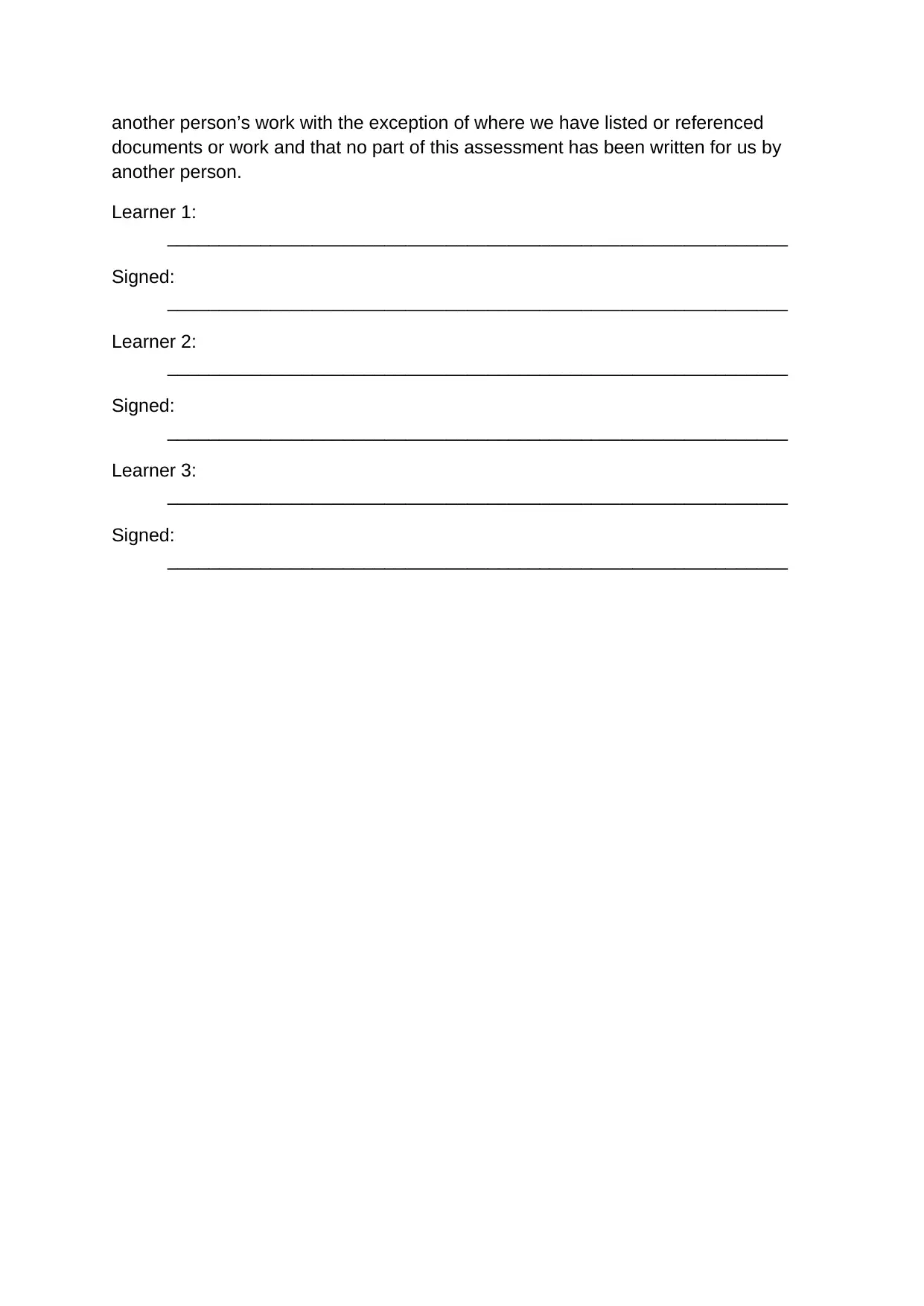
another person’s work with the exception of where we have listed or referenced
documents or work and that no part of this assessment has been written for us by
another person.
Learner 1:
____________________________________________________________
Signed:
____________________________________________________________
Learner 2:
____________________________________________________________
Signed:
____________________________________________________________
Learner 3:
____________________________________________________________
Signed:
____________________________________________________________
documents or work and that no part of this assessment has been written for us by
another person.
Learner 1:
____________________________________________________________
Signed:
____________________________________________________________
Learner 2:
____________________________________________________________
Signed:
____________________________________________________________
Learner 3:
____________________________________________________________
Signed:
____________________________________________________________
Secure Best Marks with AI Grader
Need help grading? Try our AI Grader for instant feedback on your assignments.
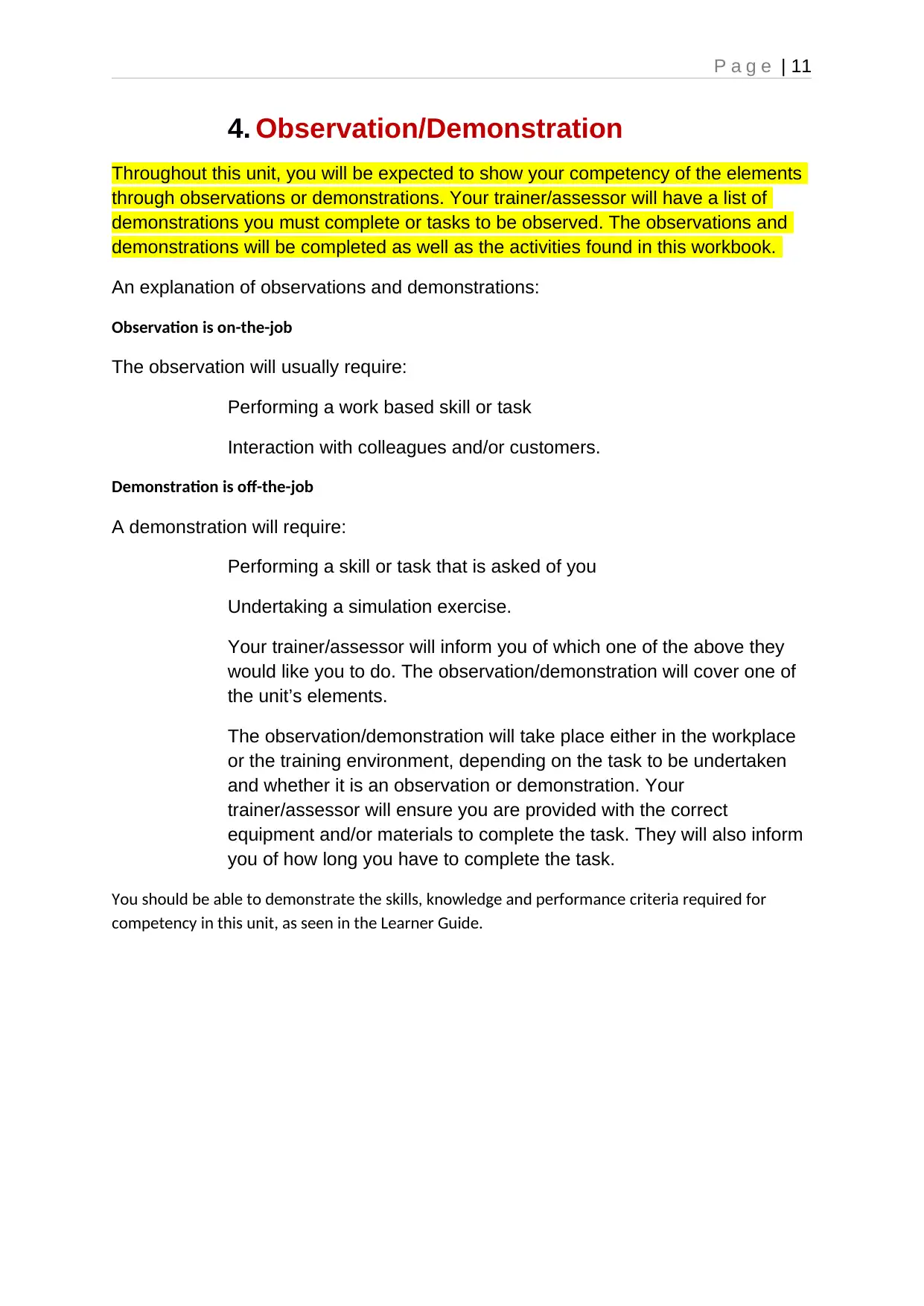
P a g e | 11
4. Observation/Demonstration
Throughout this unit, you will be expected to show your competency of the elements
through observations or demonstrations. Your trainer/assessor will have a list of
demonstrations you must complete or tasks to be observed. The observations and
demonstrations will be completed as well as the activities found in this workbook.
An explanation of observations and demonstrations:
Observation is on-the-job
The observation will usually require:
Performing a work based skill or task
Interaction with colleagues and/or customers.
Demonstration is off-the-job
A demonstration will require:
Performing a skill or task that is asked of you
Undertaking a simulation exercise.
Your trainer/assessor will inform you of which one of the above they
would like you to do. The observation/demonstration will cover one of
the unit’s elements.
The observation/demonstration will take place either in the workplace
or the training environment, depending on the task to be undertaken
and whether it is an observation or demonstration. Your
trainer/assessor will ensure you are provided with the correct
equipment and/or materials to complete the task. They will also inform
you of how long you have to complete the task.
You should be able to demonstrate the skills, knowledge and performance criteria required for
competency in this unit, as seen in the Learner Guide.
4. Observation/Demonstration
Throughout this unit, you will be expected to show your competency of the elements
through observations or demonstrations. Your trainer/assessor will have a list of
demonstrations you must complete or tasks to be observed. The observations and
demonstrations will be completed as well as the activities found in this workbook.
An explanation of observations and demonstrations:
Observation is on-the-job
The observation will usually require:
Performing a work based skill or task
Interaction with colleagues and/or customers.
Demonstration is off-the-job
A demonstration will require:
Performing a skill or task that is asked of you
Undertaking a simulation exercise.
Your trainer/assessor will inform you of which one of the above they
would like you to do. The observation/demonstration will cover one of
the unit’s elements.
The observation/demonstration will take place either in the workplace
or the training environment, depending on the task to be undertaken
and whether it is an observation or demonstration. Your
trainer/assessor will ensure you are provided with the correct
equipment and/or materials to complete the task. They will also inform
you of how long you have to complete the task.
You should be able to demonstrate the skills, knowledge and performance criteria required for
competency in this unit, as seen in the Learner Guide.
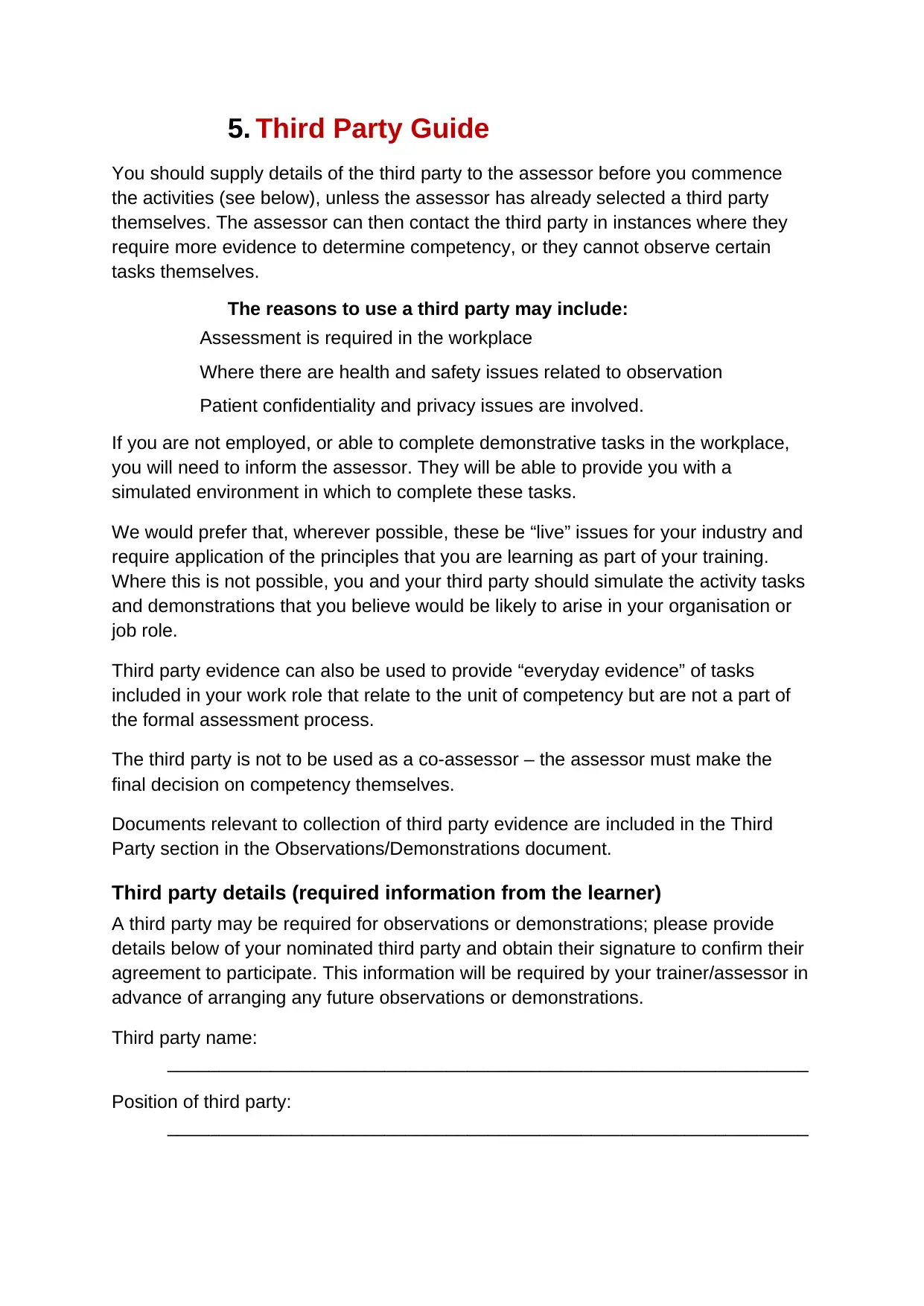
5. Third Party Guide
You should supply details of the third party to the assessor before you commence
the activities (see below), unless the assessor has already selected a third party
themselves. The assessor can then contact the third party in instances where they
require more evidence to determine competency, or they cannot observe certain
tasks themselves.
The reasons to use a third party may include:
Assessment is required in the workplace
Where there are health and safety issues related to observation
Patient confidentiality and privacy issues are involved.
If you are not employed, or able to complete demonstrative tasks in the workplace,
you will need to inform the assessor. They will be able to provide you with a
simulated environment in which to complete these tasks.
We would prefer that, wherever possible, these be “live” issues for your industry and
require application of the principles that you are learning as part of your training.
Where this is not possible, you and your third party should simulate the activity tasks
and demonstrations that you believe would be likely to arise in your organisation or
job role.
Third party evidence can also be used to provide “everyday evidence” of tasks
included in your work role that relate to the unit of competency but are not a part of
the formal assessment process.
The third party is not to be used as a co-assessor – the assessor must make the
final decision on competency themselves.
Documents relevant to collection of third party evidence are included in the Third
Party section in the Observations/Demonstrations document.
Third party details (required information from the learner)
A third party may be required for observations or demonstrations; please provide
details below of your nominated third party and obtain their signature to confirm their
agreement to participate. This information will be required by your trainer/assessor in
advance of arranging any future observations or demonstrations.
Third party name:
______________________________________________________________
Position of third party:
______________________________________________________________
You should supply details of the third party to the assessor before you commence
the activities (see below), unless the assessor has already selected a third party
themselves. The assessor can then contact the third party in instances where they
require more evidence to determine competency, or they cannot observe certain
tasks themselves.
The reasons to use a third party may include:
Assessment is required in the workplace
Where there are health and safety issues related to observation
Patient confidentiality and privacy issues are involved.
If you are not employed, or able to complete demonstrative tasks in the workplace,
you will need to inform the assessor. They will be able to provide you with a
simulated environment in which to complete these tasks.
We would prefer that, wherever possible, these be “live” issues for your industry and
require application of the principles that you are learning as part of your training.
Where this is not possible, you and your third party should simulate the activity tasks
and demonstrations that you believe would be likely to arise in your organisation or
job role.
Third party evidence can also be used to provide “everyday evidence” of tasks
included in your work role that relate to the unit of competency but are not a part of
the formal assessment process.
The third party is not to be used as a co-assessor – the assessor must make the
final decision on competency themselves.
Documents relevant to collection of third party evidence are included in the Third
Party section in the Observations/Demonstrations document.
Third party details (required information from the learner)
A third party may be required for observations or demonstrations; please provide
details below of your nominated third party and obtain their signature to confirm their
agreement to participate. This information will be required by your trainer/assessor in
advance of arranging any future observations or demonstrations.
Third party name:
______________________________________________________________
Position of third party:
______________________________________________________________
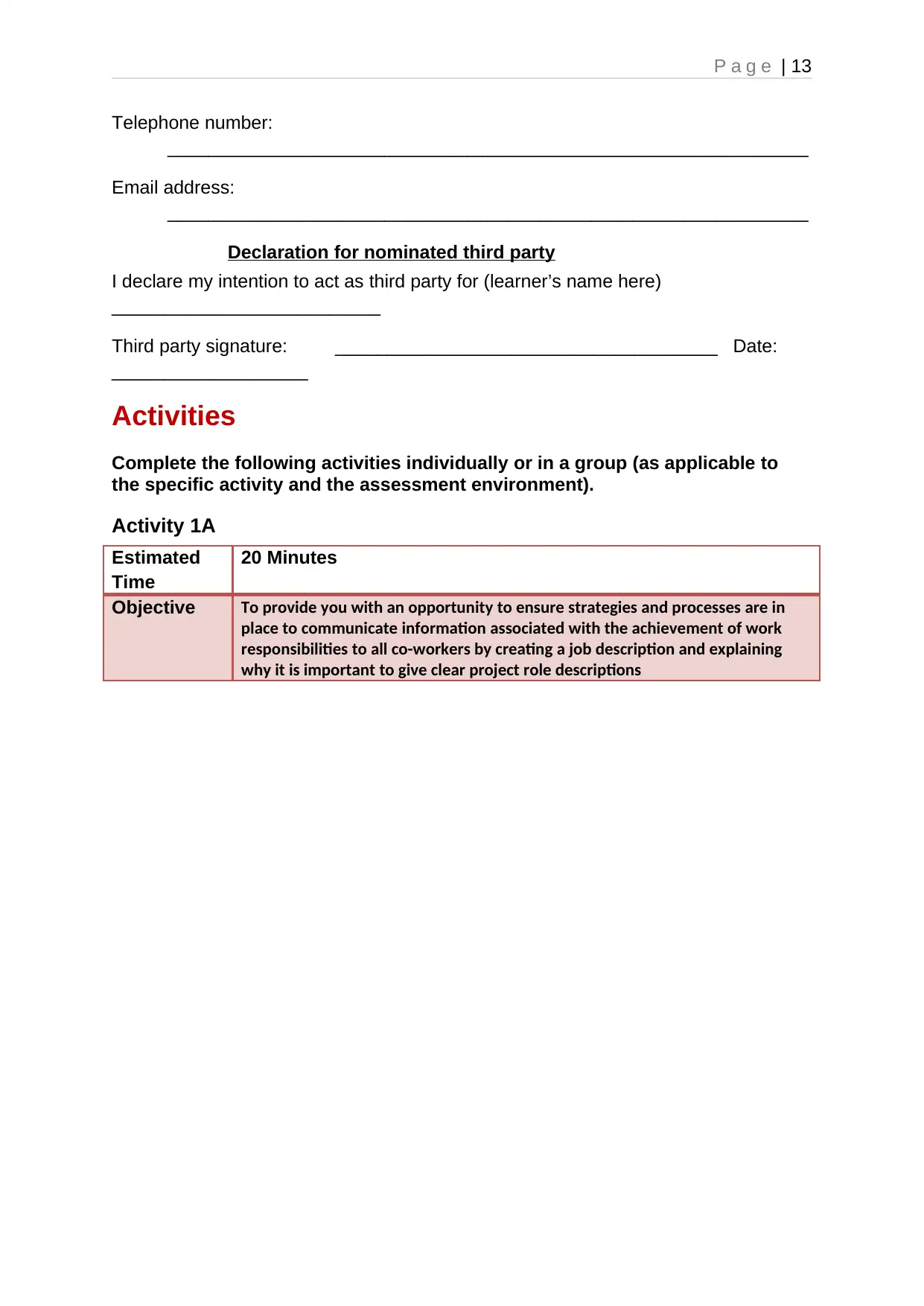
P a g e | 13
Telephone number:
______________________________________________________________
Email address:
______________________________________________________________
Declaration for nominated third party
I declare my intention to act as third party for (learner’s name here)
__________________________
Third party signature: _____________________________________ Date:
___________________
Activities
Complete the following activities individually or in a group (as applicable to
the specific activity and the assessment environment).
Activity 1A
Estimated
Time
20 Minutes
Objective To provide you with an opportunity to ensure strategies and processes are in
place to communicate information associated with the achievement of work
responsibilities to all co-workers by creating a job description and explaining
why it is important to give clear project role descriptions
Telephone number:
______________________________________________________________
Email address:
______________________________________________________________
Declaration for nominated third party
I declare my intention to act as third party for (learner’s name here)
__________________________
Third party signature: _____________________________________ Date:
___________________
Activities
Complete the following activities individually or in a group (as applicable to
the specific activity and the assessment environment).
Activity 1A
Estimated
Time
20 Minutes
Objective To provide you with an opportunity to ensure strategies and processes are in
place to communicate information associated with the achievement of work
responsibilities to all co-workers by creating a job description and explaining
why it is important to give clear project role descriptions
Paraphrase This Document
Need a fresh take? Get an instant paraphrase of this document with our AI Paraphraser
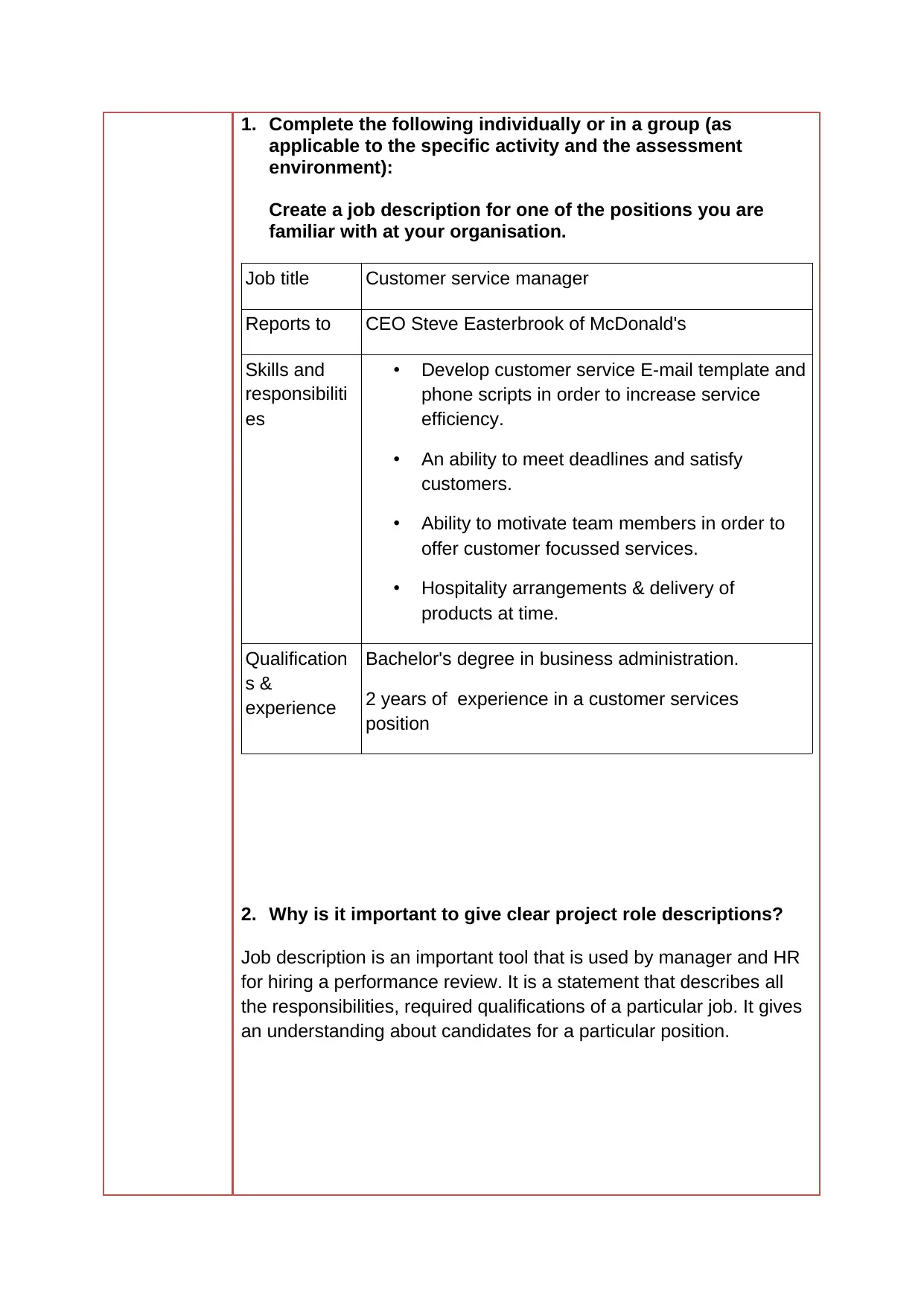
1. Complete the following individually or in a group (as
applicable to the specific activity and the assessment
environment):
Create a job description for one of the positions you are
familiar with at your organisation.
Job title Customer service manager
Reports to CEO Steve Easterbrook of McDonald's
Skills and
responsibiliti
es
• Develop customer service E-mail template and
phone scripts in order to increase service
efficiency.
• An ability to meet deadlines and satisfy
customers.
• Ability to motivate team members in order to
offer customer focussed services.
• Hospitality arrangements & delivery of
products at time.
Qualification
s &
experience
Bachelor's degree in business administration.
2 years of experience in a customer services
position
2. Why is it important to give clear project role descriptions?
Job description is an important tool that is used by manager and HR
for hiring a performance review. It is a statement that describes all
the responsibilities, required qualifications of a particular job. It gives
an understanding about candidates for a particular position.
applicable to the specific activity and the assessment
environment):
Create a job description for one of the positions you are
familiar with at your organisation.
Job title Customer service manager
Reports to CEO Steve Easterbrook of McDonald's
Skills and
responsibiliti
es
• Develop customer service E-mail template and
phone scripts in order to increase service
efficiency.
• An ability to meet deadlines and satisfy
customers.
• Ability to motivate team members in order to
offer customer focussed services.
• Hospitality arrangements & delivery of
products at time.
Qualification
s &
experience
Bachelor's degree in business administration.
2 years of experience in a customer services
position
2. Why is it important to give clear project role descriptions?
Job description is an important tool that is used by manager and HR
for hiring a performance review. It is a statement that describes all
the responsibilities, required qualifications of a particular job. It gives
an understanding about candidates for a particular position.
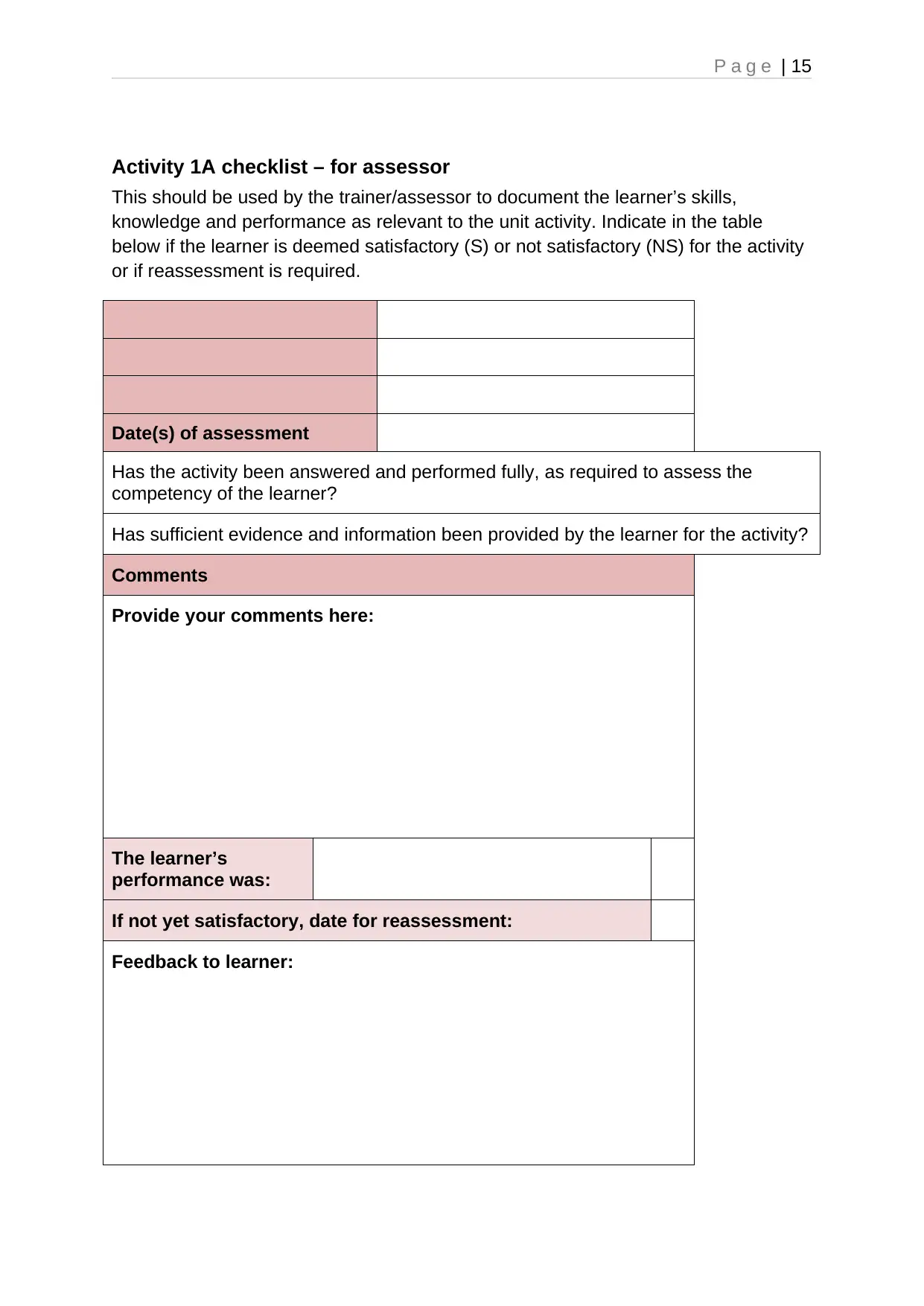
P a g e | 15
Activity 1A checklist – for assessor
This should be used by the trainer/assessor to document the learner’s skills,
knowledge and performance as relevant to the unit activity. Indicate in the table
below if the learner is deemed satisfactory (S) or not satisfactory (NS) for the activity
or if reassessment is required.
Date(s) of assessment
Has the activity been answered and performed fully, as required to assess the
competency of the learner?
Has sufficient evidence and information been provided by the learner for the activity?
Comments
Provide your comments here:
The learner’s
performance was:
If not yet satisfactory, date for reassessment:
Feedback to learner:
Activity 1A checklist – for assessor
This should be used by the trainer/assessor to document the learner’s skills,
knowledge and performance as relevant to the unit activity. Indicate in the table
below if the learner is deemed satisfactory (S) or not satisfactory (NS) for the activity
or if reassessment is required.
Date(s) of assessment
Has the activity been answered and performed fully, as required to assess the
competency of the learner?
Has sufficient evidence and information been provided by the learner for the activity?
Comments
Provide your comments here:
The learner’s
performance was:
If not yet satisfactory, date for reassessment:
Feedback to learner:
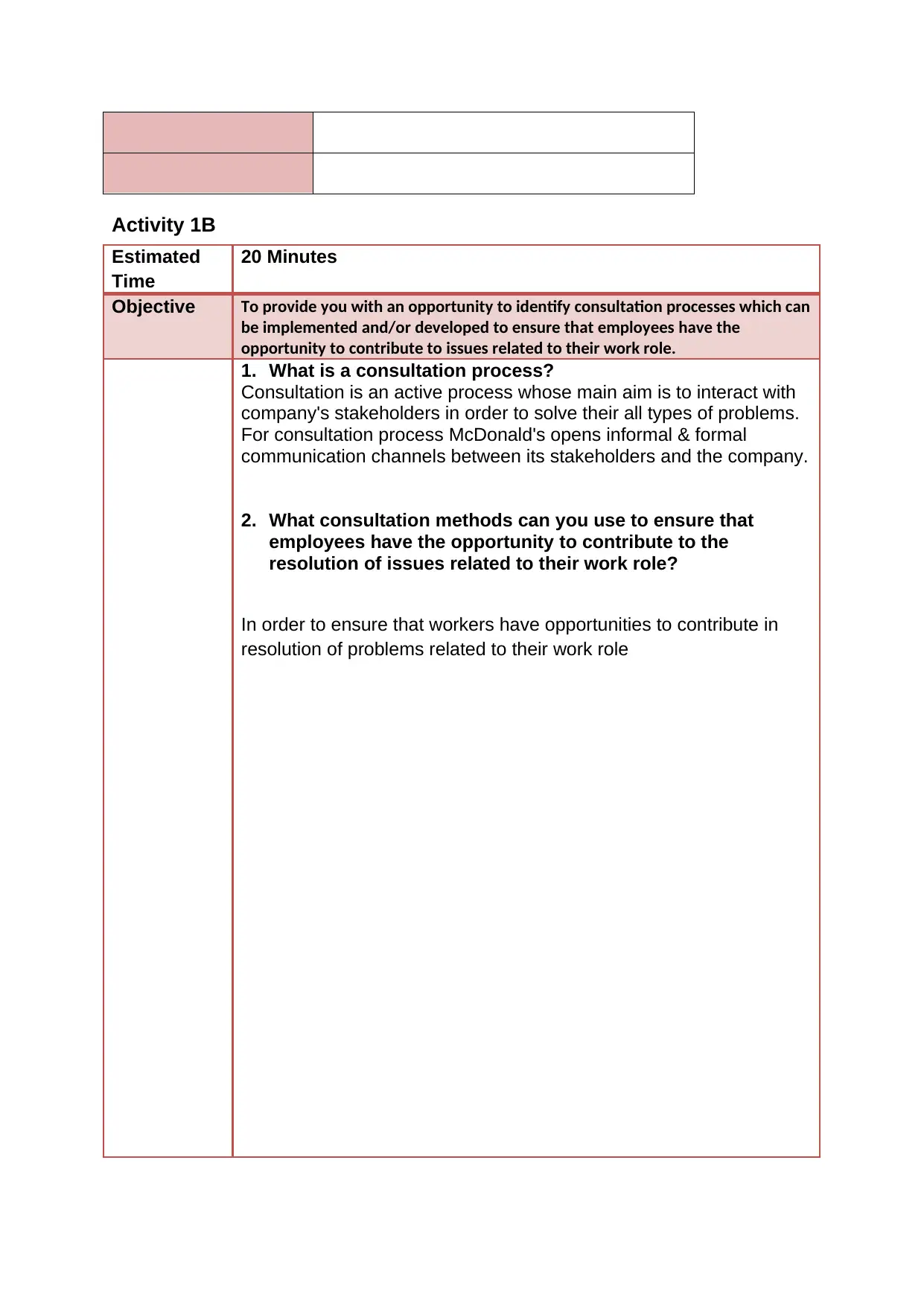
Activity 1B
Estimated
Time
20 Minutes
Objective To provide you with an opportunity to identify consultation processes which can
be implemented and/or developed to ensure that employees have the
opportunity to contribute to issues related to their work role.
1. What is a consultation process?
Consultation is an active process whose main aim is to interact with
company's stakeholders in order to solve their all types of problems.
For consultation process McDonald's opens informal & formal
communication channels between its stakeholders and the company.
2. What consultation methods can you use to ensure that
employees have the opportunity to contribute to the
resolution of issues related to their work role?
In order to ensure that workers have opportunities to contribute in
resolution of problems related to their work role
Estimated
Time
20 Minutes
Objective To provide you with an opportunity to identify consultation processes which can
be implemented and/or developed to ensure that employees have the
opportunity to contribute to issues related to their work role.
1. What is a consultation process?
Consultation is an active process whose main aim is to interact with
company's stakeholders in order to solve their all types of problems.
For consultation process McDonald's opens informal & formal
communication channels between its stakeholders and the company.
2. What consultation methods can you use to ensure that
employees have the opportunity to contribute to the
resolution of issues related to their work role?
In order to ensure that workers have opportunities to contribute in
resolution of problems related to their work role
Secure Best Marks with AI Grader
Need help grading? Try our AI Grader for instant feedback on your assignments.
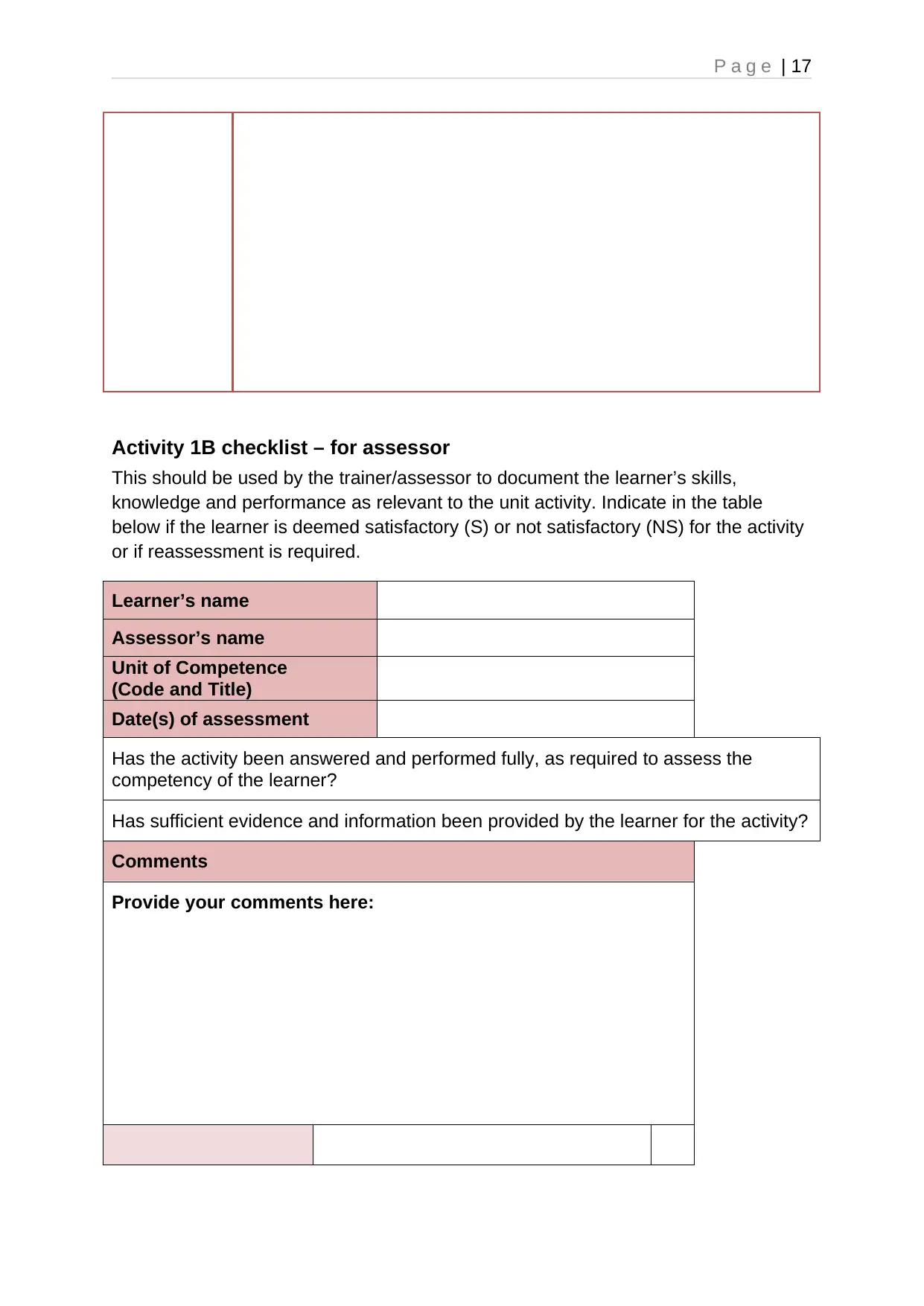
P a g e | 17
Activity 1B checklist – for assessor
This should be used by the trainer/assessor to document the learner’s skills,
knowledge and performance as relevant to the unit activity. Indicate in the table
below if the learner is deemed satisfactory (S) or not satisfactory (NS) for the activity
or if reassessment is required.
Learner’s name
Assessor’s name
Unit of Competence
(Code and Title)
Date(s) of assessment
Has the activity been answered and performed fully, as required to assess the
competency of the learner?
Has sufficient evidence and information been provided by the learner for the activity?
Comments
Provide your comments here:
Activity 1B checklist – for assessor
This should be used by the trainer/assessor to document the learner’s skills,
knowledge and performance as relevant to the unit activity. Indicate in the table
below if the learner is deemed satisfactory (S) or not satisfactory (NS) for the activity
or if reassessment is required.
Learner’s name
Assessor’s name
Unit of Competence
(Code and Title)
Date(s) of assessment
Has the activity been answered and performed fully, as required to assess the
competency of the learner?
Has sufficient evidence and information been provided by the learner for the activity?
Comments
Provide your comments here:
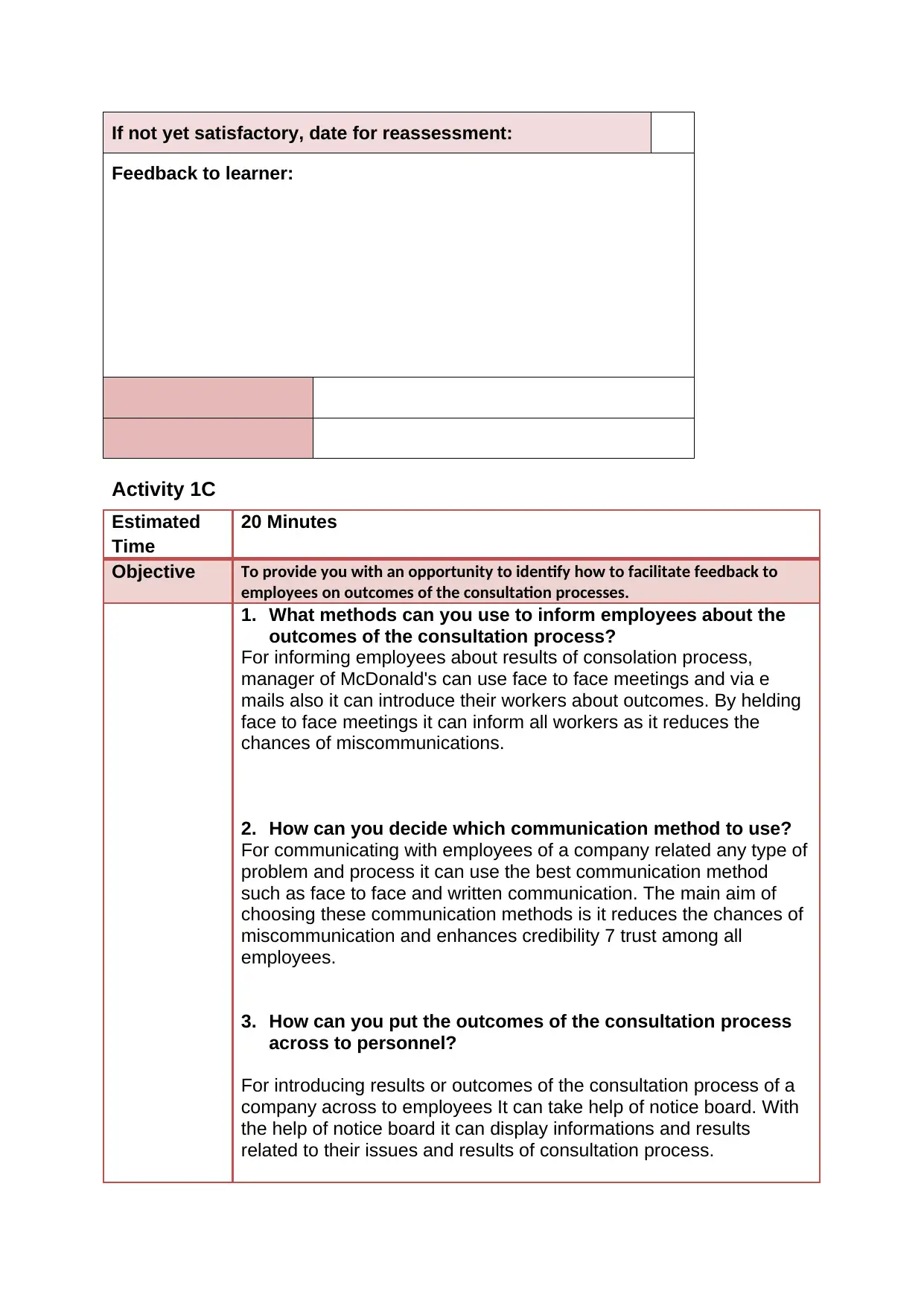
If not yet satisfactory, date for reassessment:
Feedback to learner:
Activity 1C
Estimated
Time
20 Minutes
Objective To provide you with an opportunity to identify how to facilitate feedback to
employees on outcomes of the consultation processes.
1. What methods can you use to inform employees about the
outcomes of the consultation process?
For informing employees about results of consolation process,
manager of McDonald's can use face to face meetings and via e
mails also it can introduce their workers about outcomes. By helding
face to face meetings it can inform all workers as it reduces the
chances of miscommunications.
2. How can you decide which communication method to use?
For communicating with employees of a company related any type of
problem and process it can use the best communication method
such as face to face and written communication. The main aim of
choosing these communication methods is it reduces the chances of
miscommunication and enhances credibility 7 trust among all
employees.
3. How can you put the outcomes of the consultation process
across to personnel?
For introducing results or outcomes of the consultation process of a
company across to employees It can take help of notice board. With
the help of notice board it can display informations and results
related to their issues and results of consultation process.
Feedback to learner:
Activity 1C
Estimated
Time
20 Minutes
Objective To provide you with an opportunity to identify how to facilitate feedback to
employees on outcomes of the consultation processes.
1. What methods can you use to inform employees about the
outcomes of the consultation process?
For informing employees about results of consolation process,
manager of McDonald's can use face to face meetings and via e
mails also it can introduce their workers about outcomes. By helding
face to face meetings it can inform all workers as it reduces the
chances of miscommunications.
2. How can you decide which communication method to use?
For communicating with employees of a company related any type of
problem and process it can use the best communication method
such as face to face and written communication. The main aim of
choosing these communication methods is it reduces the chances of
miscommunication and enhances credibility 7 trust among all
employees.
3. How can you put the outcomes of the consultation process
across to personnel?
For introducing results or outcomes of the consultation process of a
company across to employees It can take help of notice board. With
the help of notice board it can display informations and results
related to their issues and results of consultation process.
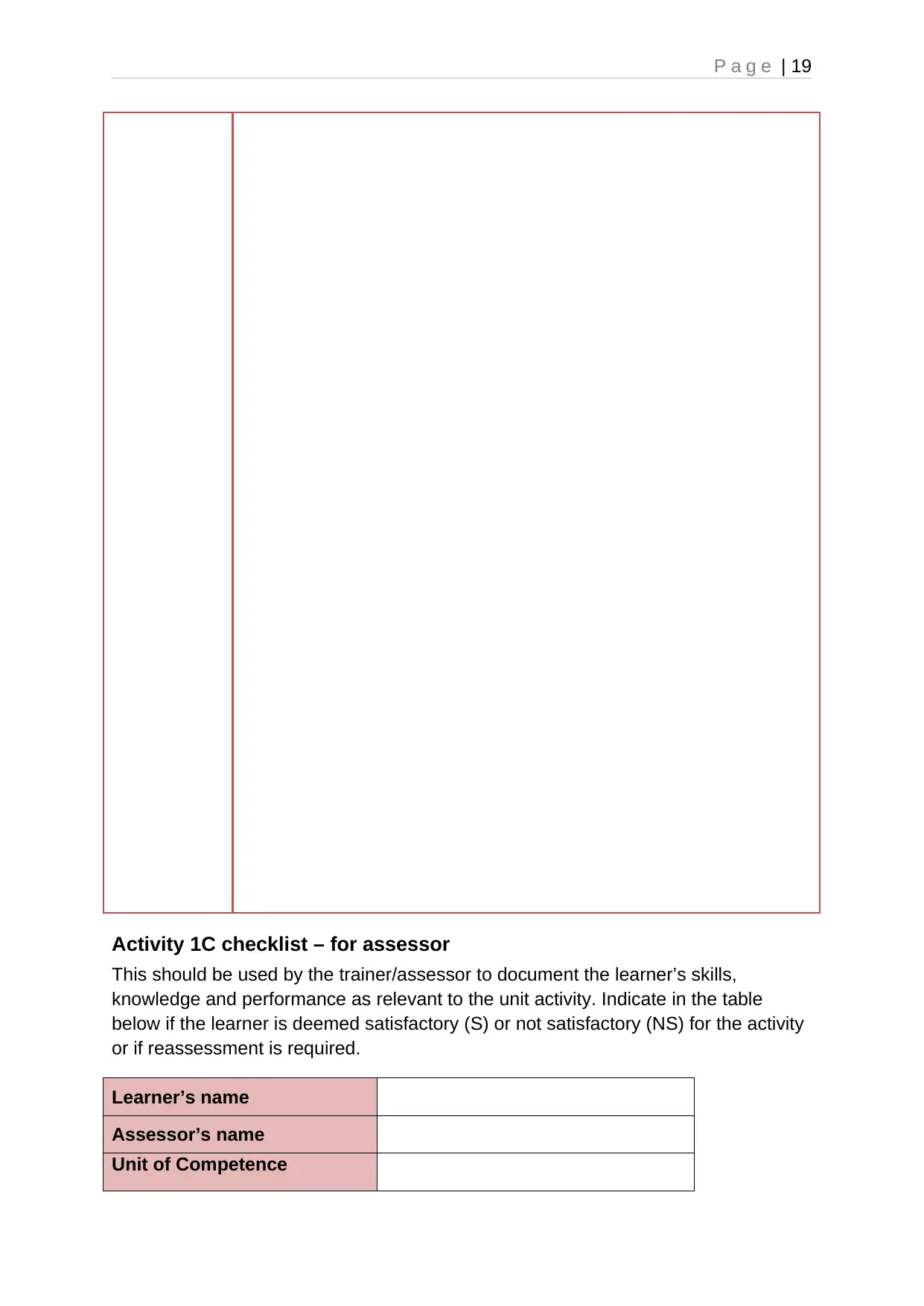
P a g e | 19
Activity 1C checklist – for assessor
This should be used by the trainer/assessor to document the learner’s skills,
knowledge and performance as relevant to the unit activity. Indicate in the table
below if the learner is deemed satisfactory (S) or not satisfactory (NS) for the activity
or if reassessment is required.
Learner’s name
Assessor’s name
Unit of Competence
Activity 1C checklist – for assessor
This should be used by the trainer/assessor to document the learner’s skills,
knowledge and performance as relevant to the unit activity. Indicate in the table
below if the learner is deemed satisfactory (S) or not satisfactory (NS) for the activity
or if reassessment is required.
Learner’s name
Assessor’s name
Unit of Competence
Paraphrase This Document
Need a fresh take? Get an instant paraphrase of this document with our AI Paraphraser
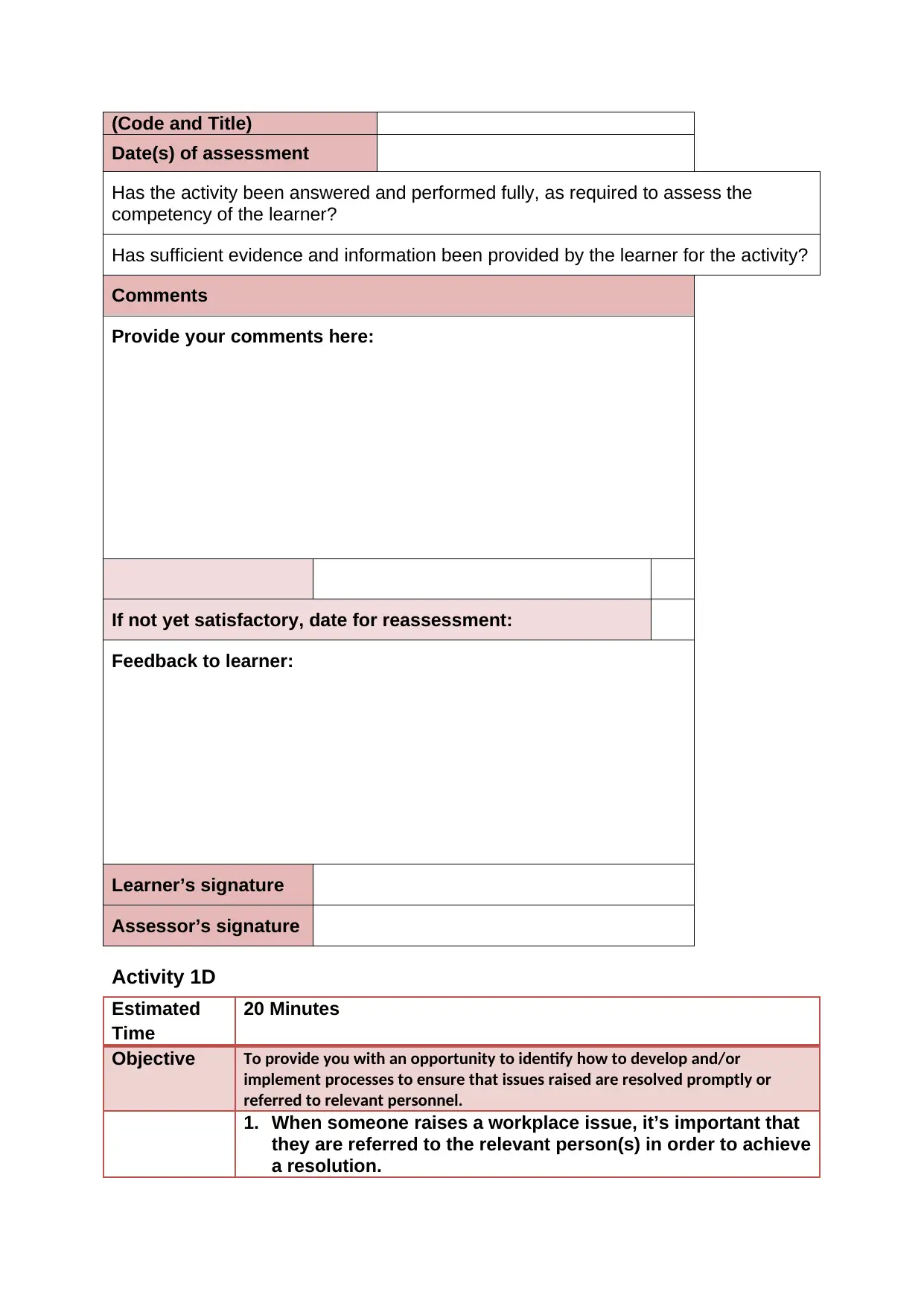
(Code and Title)
Date(s) of assessment
Has the activity been answered and performed fully, as required to assess the
competency of the learner?
Has sufficient evidence and information been provided by the learner for the activity?
Comments
Provide your comments here:
If not yet satisfactory, date for reassessment:
Feedback to learner:
Learner’s signature
Assessor’s signature
Activity 1D
Estimated
Time
20 Minutes
Objective To provide you with an opportunity to identify how to develop and/or
implement processes to ensure that issues raised are resolved promptly or
referred to relevant personnel.
1. When someone raises a workplace issue, it’s important that
they are referred to the relevant person(s) in order to achieve
a resolution.
Date(s) of assessment
Has the activity been answered and performed fully, as required to assess the
competency of the learner?
Has sufficient evidence and information been provided by the learner for the activity?
Comments
Provide your comments here:
If not yet satisfactory, date for reassessment:
Feedback to learner:
Learner’s signature
Assessor’s signature
Activity 1D
Estimated
Time
20 Minutes
Objective To provide you with an opportunity to identify how to develop and/or
implement processes to ensure that issues raised are resolved promptly or
referred to relevant personnel.
1. When someone raises a workplace issue, it’s important that
they are referred to the relevant person(s) in order to achieve
a resolution.
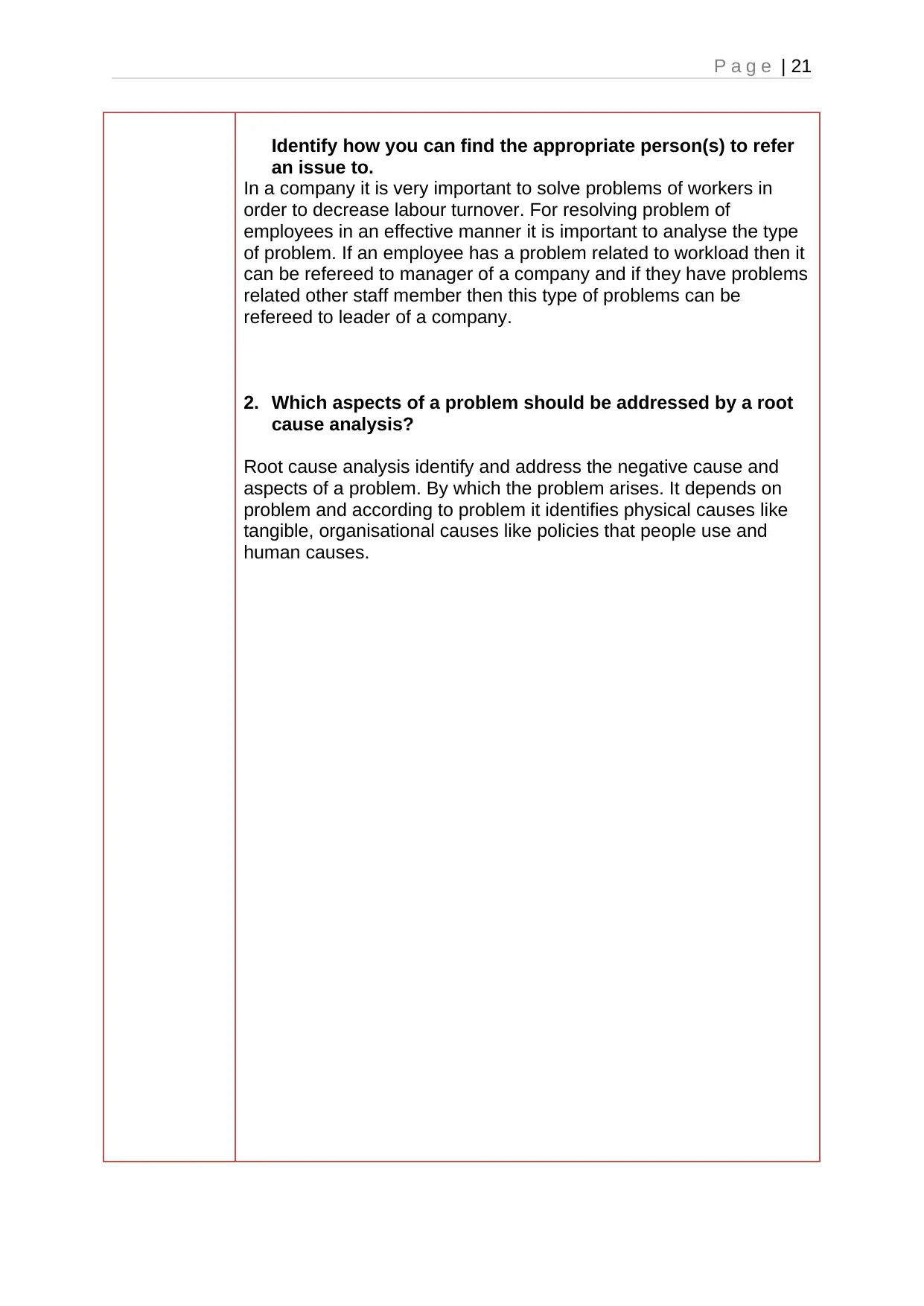
P a g e | 21
Identify how you can find the appropriate person(s) to refer
an issue to.
In a company it is very important to solve problems of workers in
order to decrease labour turnover. For resolving problem of
employees in an effective manner it is important to analyse the type
of problem. If an employee has a problem related to workload then it
can be refereed to manager of a company and if they have problems
related other staff member then this type of problems can be
refereed to leader of a company.
2. Which aspects of a problem should be addressed by a root
cause analysis?
Root cause analysis identify and address the negative cause and
aspects of a problem. By which the problem arises. It depends on
problem and according to problem it identifies physical causes like
tangible, organisational causes like policies that people use and
human causes.
Identify how you can find the appropriate person(s) to refer
an issue to.
In a company it is very important to solve problems of workers in
order to decrease labour turnover. For resolving problem of
employees in an effective manner it is important to analyse the type
of problem. If an employee has a problem related to workload then it
can be refereed to manager of a company and if they have problems
related other staff member then this type of problems can be
refereed to leader of a company.
2. Which aspects of a problem should be addressed by a root
cause analysis?
Root cause analysis identify and address the negative cause and
aspects of a problem. By which the problem arises. It depends on
problem and according to problem it identifies physical causes like
tangible, organisational causes like policies that people use and
human causes.
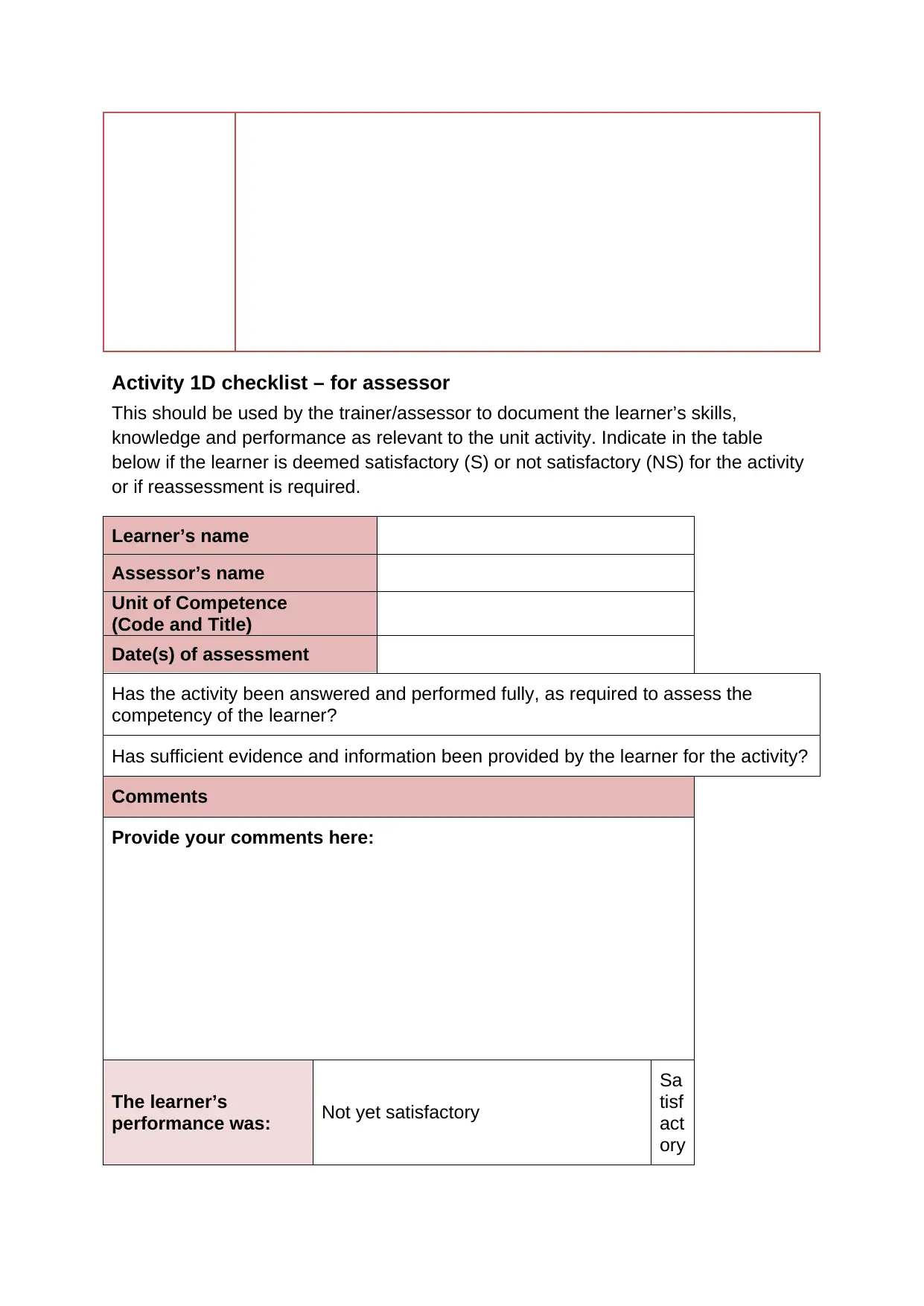
Activity 1D checklist – for assessor
This should be used by the trainer/assessor to document the learner’s skills,
knowledge and performance as relevant to the unit activity. Indicate in the table
below if the learner is deemed satisfactory (S) or not satisfactory (NS) for the activity
or if reassessment is required.
Learner’s name
Assessor’s name
Unit of Competence
(Code and Title)
Date(s) of assessment
Has the activity been answered and performed fully, as required to assess the
competency of the learner?
Has sufficient evidence and information been provided by the learner for the activity?
Comments
Provide your comments here:
The learner’s
performance was: Not yet satisfactory
Sa
tisf
act
ory
This should be used by the trainer/assessor to document the learner’s skills,
knowledge and performance as relevant to the unit activity. Indicate in the table
below if the learner is deemed satisfactory (S) or not satisfactory (NS) for the activity
or if reassessment is required.
Learner’s name
Assessor’s name
Unit of Competence
(Code and Title)
Date(s) of assessment
Has the activity been answered and performed fully, as required to assess the
competency of the learner?
Has sufficient evidence and information been provided by the learner for the activity?
Comments
Provide your comments here:
The learner’s
performance was: Not yet satisfactory
Sa
tisf
act
ory
Secure Best Marks with AI Grader
Need help grading? Try our AI Grader for instant feedback on your assignments.
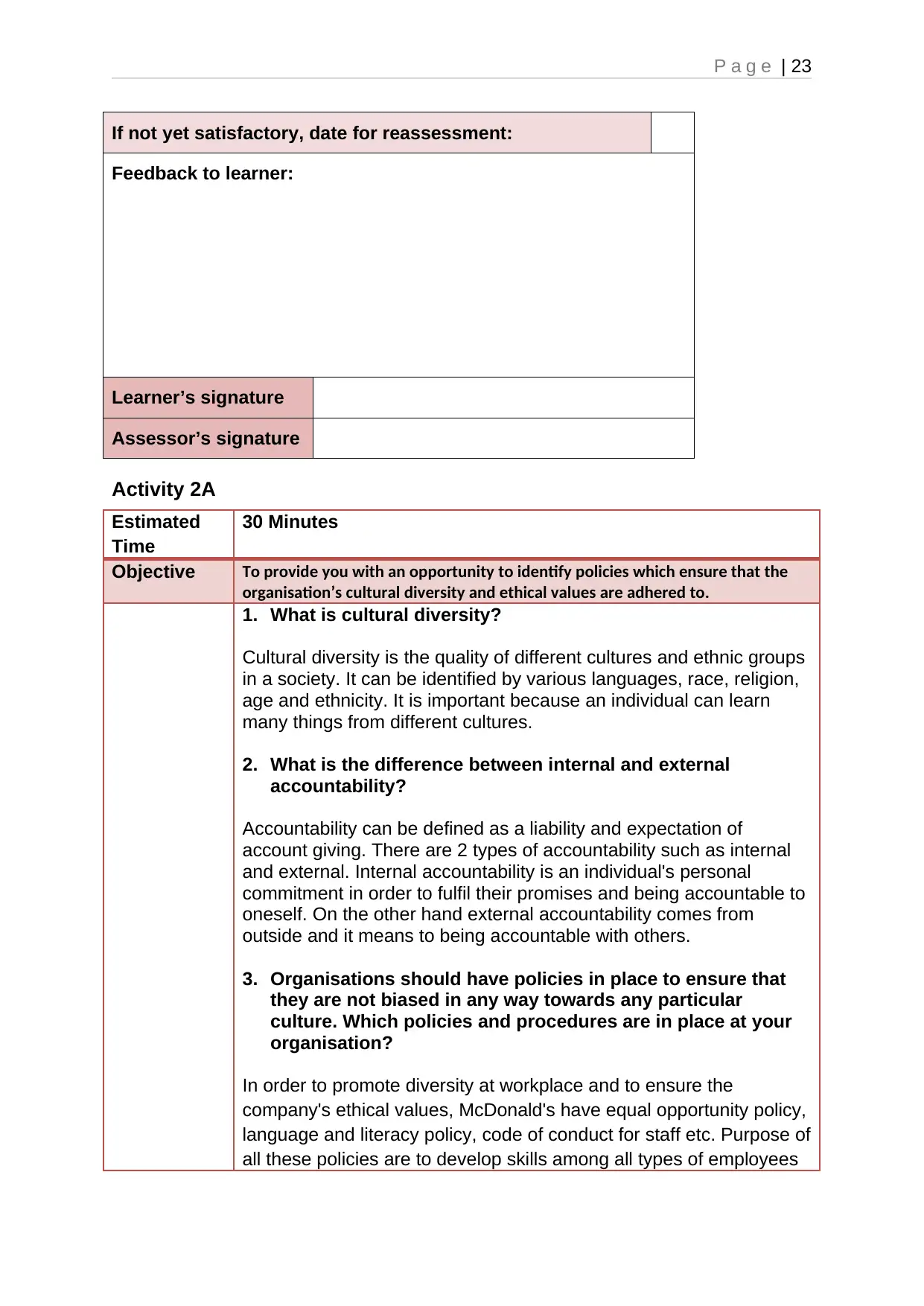
P a g e | 23
If not yet satisfactory, date for reassessment:
Feedback to learner:
Learner’s signature
Assessor’s signature
Activity 2A
Estimated
Time
30 Minutes
Objective To provide you with an opportunity to identify policies which ensure that the
organisation’s cultural diversity and ethical values are adhered to.
1. What is cultural diversity?
Cultural diversity is the quality of different cultures and ethnic groups
in a society. It can be identified by various languages, race, religion,
age and ethnicity. It is important because an individual can learn
many things from different cultures.
2. What is the difference between internal and external
accountability?
Accountability can be defined as a liability and expectation of
account giving. There are 2 types of accountability such as internal
and external. Internal accountability is an individual's personal
commitment in order to fulfil their promises and being accountable to
oneself. On the other hand external accountability comes from
outside and it means to being accountable with others.
3. Organisations should have policies in place to ensure that
they are not biased in any way towards any particular
culture. Which policies and procedures are in place at your
organisation?
In order to promote diversity at workplace and to ensure the
company's ethical values, McDonald's have equal opportunity policy,
language and literacy policy, code of conduct for staff etc. Purpose of
all these policies are to develop skills among all types of employees
If not yet satisfactory, date for reassessment:
Feedback to learner:
Learner’s signature
Assessor’s signature
Activity 2A
Estimated
Time
30 Minutes
Objective To provide you with an opportunity to identify policies which ensure that the
organisation’s cultural diversity and ethical values are adhered to.
1. What is cultural diversity?
Cultural diversity is the quality of different cultures and ethnic groups
in a society. It can be identified by various languages, race, religion,
age and ethnicity. It is important because an individual can learn
many things from different cultures.
2. What is the difference between internal and external
accountability?
Accountability can be defined as a liability and expectation of
account giving. There are 2 types of accountability such as internal
and external. Internal accountability is an individual's personal
commitment in order to fulfil their promises and being accountable to
oneself. On the other hand external accountability comes from
outside and it means to being accountable with others.
3. Organisations should have policies in place to ensure that
they are not biased in any way towards any particular
culture. Which policies and procedures are in place at your
organisation?
In order to promote diversity at workplace and to ensure the
company's ethical values, McDonald's have equal opportunity policy,
language and literacy policy, code of conduct for staff etc. Purpose of
all these policies are to develop skills among all types of employees
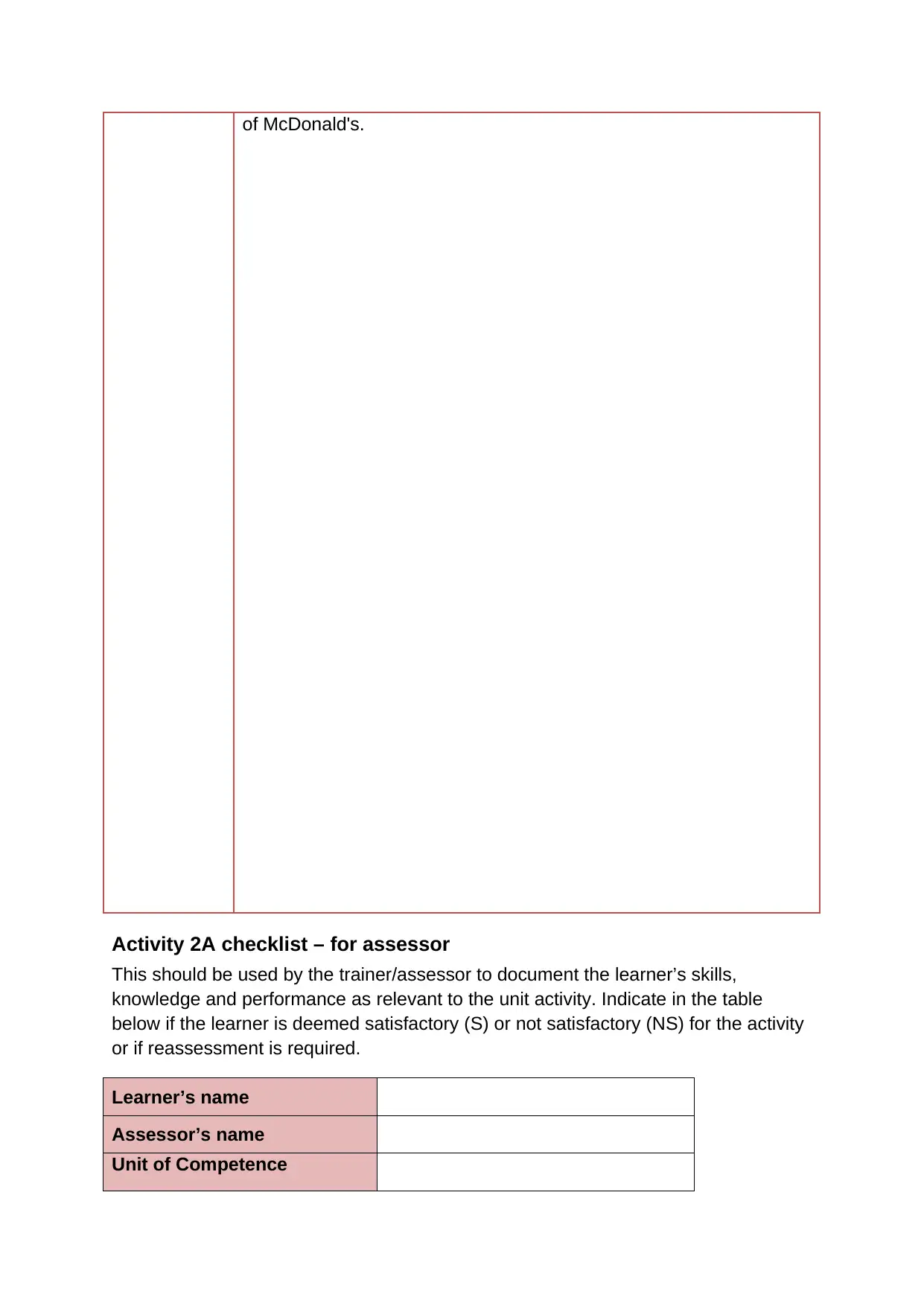
of McDonald's.
Activity 2A checklist – for assessor
This should be used by the trainer/assessor to document the learner’s skills,
knowledge and performance as relevant to the unit activity. Indicate in the table
below if the learner is deemed satisfactory (S) or not satisfactory (NS) for the activity
or if reassessment is required.
Learner’s name
Assessor’s name
Unit of Competence
Activity 2A checklist – for assessor
This should be used by the trainer/assessor to document the learner’s skills,
knowledge and performance as relevant to the unit activity. Indicate in the table
below if the learner is deemed satisfactory (S) or not satisfactory (NS) for the activity
or if reassessment is required.
Learner’s name
Assessor’s name
Unit of Competence
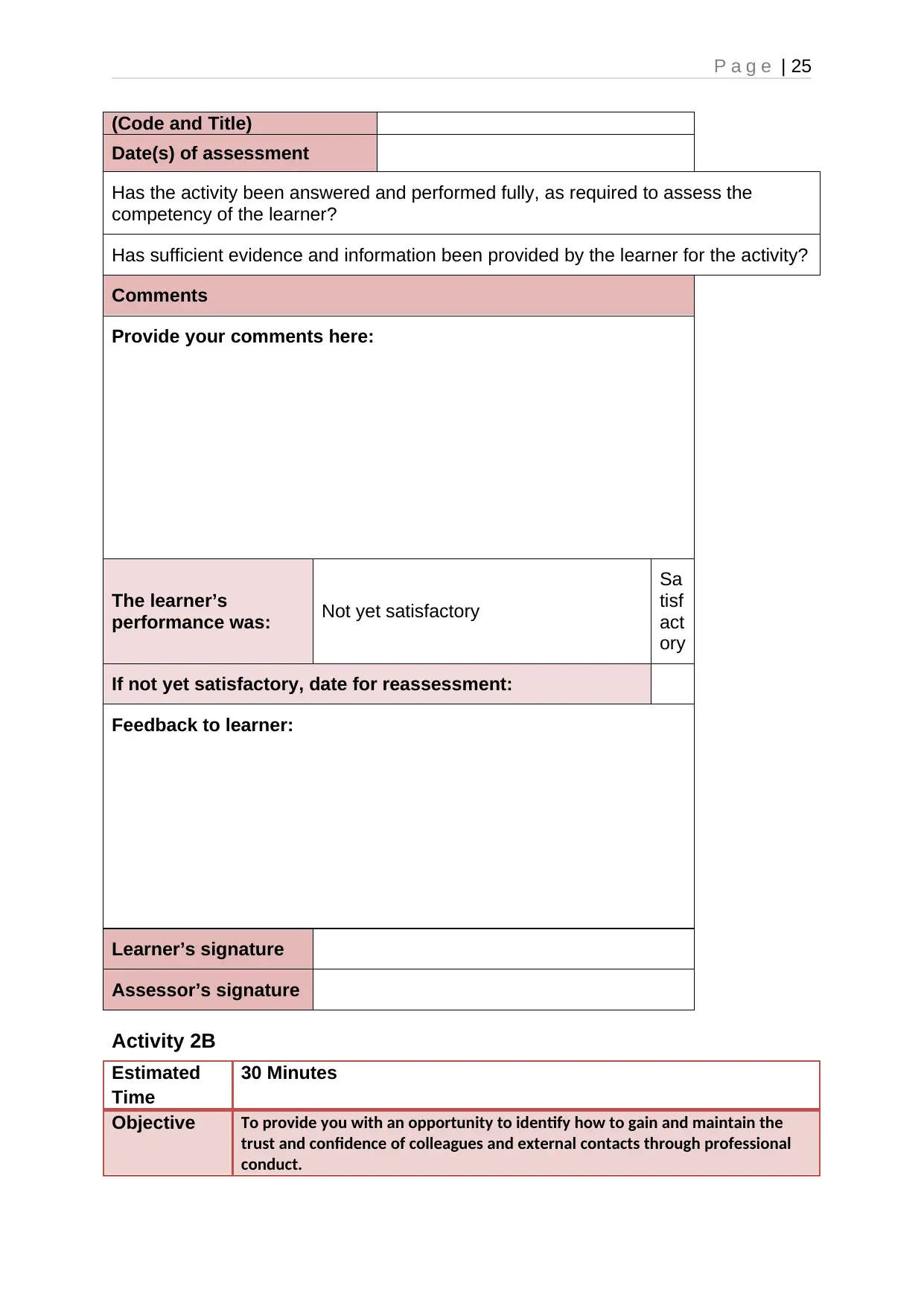
P a g e | 25
(Code and Title)
Date(s) of assessment
Has the activity been answered and performed fully, as required to assess the
competency of the learner?
Has sufficient evidence and information been provided by the learner for the activity?
Comments
Provide your comments here:
The learner’s
performance was: Not yet satisfactory
Sa
tisf
act
ory
If not yet satisfactory, date for reassessment:
Feedback to learner:
Learner’s signature
Assessor’s signature
Activity 2B
Estimated
Time
30 Minutes
Objective To provide you with an opportunity to identify how to gain and maintain the
trust and confidence of colleagues and external contacts through professional
conduct.
(Code and Title)
Date(s) of assessment
Has the activity been answered and performed fully, as required to assess the
competency of the learner?
Has sufficient evidence and information been provided by the learner for the activity?
Comments
Provide your comments here:
The learner’s
performance was: Not yet satisfactory
Sa
tisf
act
ory
If not yet satisfactory, date for reassessment:
Feedback to learner:
Learner’s signature
Assessor’s signature
Activity 2B
Estimated
Time
30 Minutes
Objective To provide you with an opportunity to identify how to gain and maintain the
trust and confidence of colleagues and external contacts through professional
conduct.
Paraphrase This Document
Need a fresh take? Get an instant paraphrase of this document with our AI Paraphraser
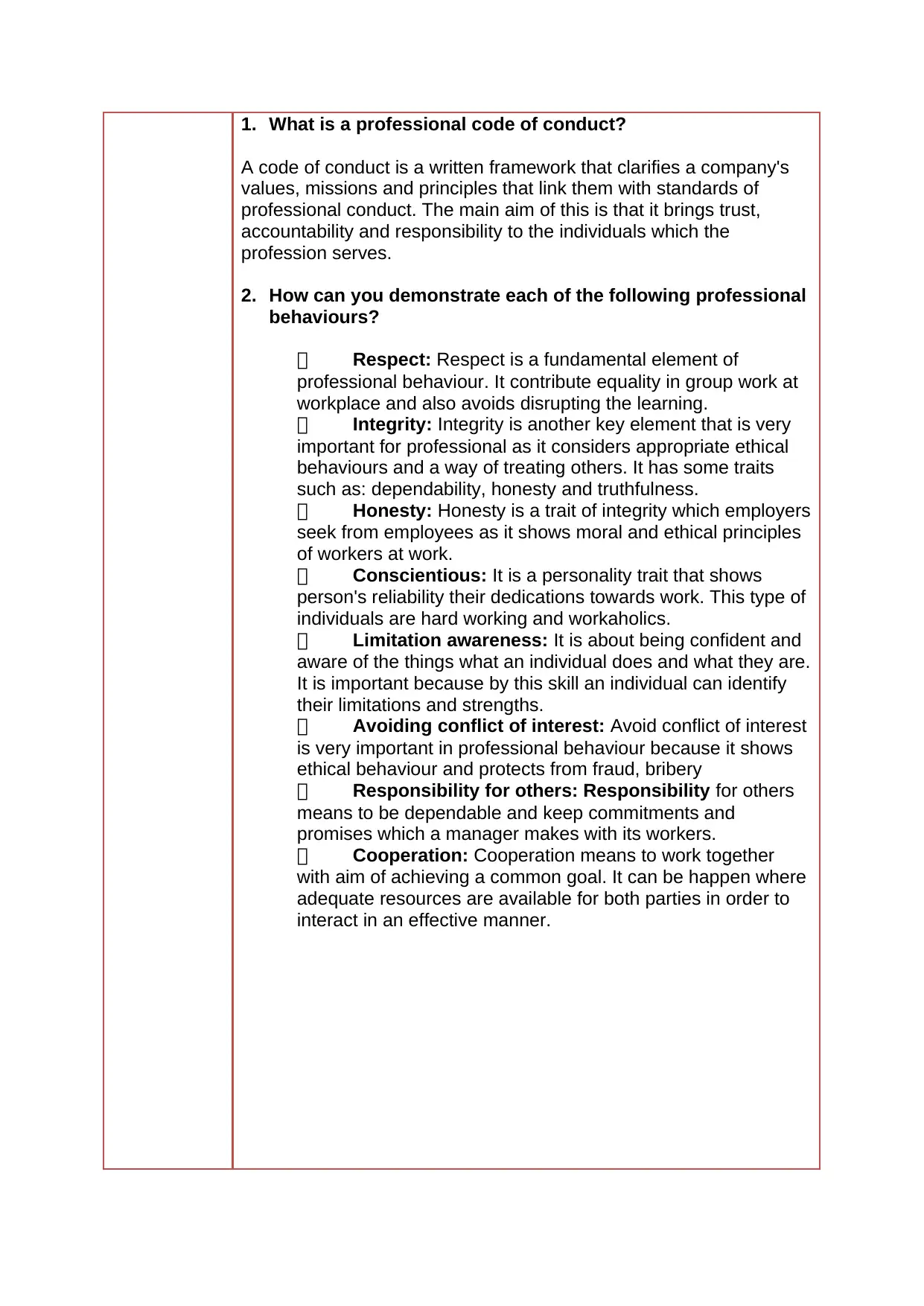
1. What is a professional code of conduct?
A code of conduct is a written framework that clarifies a company's
values, missions and principles that link them with standards of
professional conduct. The main aim of this is that it brings trust,
accountability and responsibility to the individuals which the
profession serves.
2. How can you demonstrate each of the following professional
behaviours?
Respect: Respect is a fundamental element of
professional behaviour. It contribute equality in group work at
workplace and also avoids disrupting the learning.
Integrity: Integrity is another key element that is very
important for professional as it considers appropriate ethical
behaviours and a way of treating others. It has some traits
such as: dependability, honesty and truthfulness.
Honesty: Honesty is a trait of integrity which employers
seek from employees as it shows moral and ethical principles
of workers at work.
Conscientious: It is a personality trait that shows
person's reliability their dedications towards work. This type of
individuals are hard working and workaholics.
Limitation awareness: It is about being confident and
aware of the things what an individual does and what they are.
It is important because by this skill an individual can identify
their limitations and strengths.
Avoiding conflict of interest: Avoid conflict of interest
is very important in professional behaviour because it shows
ethical behaviour and protects from fraud, bribery
Responsibility for others: Responsibility for others
means to be dependable and keep commitments and
promises which a manager makes with its workers.
Cooperation: Cooperation means to work together
with aim of achieving a common goal. It can be happen where
adequate resources are available for both parties in order to
interact in an effective manner.
A code of conduct is a written framework that clarifies a company's
values, missions and principles that link them with standards of
professional conduct. The main aim of this is that it brings trust,
accountability and responsibility to the individuals which the
profession serves.
2. How can you demonstrate each of the following professional
behaviours?
Respect: Respect is a fundamental element of
professional behaviour. It contribute equality in group work at
workplace and also avoids disrupting the learning.
Integrity: Integrity is another key element that is very
important for professional as it considers appropriate ethical
behaviours and a way of treating others. It has some traits
such as: dependability, honesty and truthfulness.
Honesty: Honesty is a trait of integrity which employers
seek from employees as it shows moral and ethical principles
of workers at work.
Conscientious: It is a personality trait that shows
person's reliability their dedications towards work. This type of
individuals are hard working and workaholics.
Limitation awareness: It is about being confident and
aware of the things what an individual does and what they are.
It is important because by this skill an individual can identify
their limitations and strengths.
Avoiding conflict of interest: Avoid conflict of interest
is very important in professional behaviour because it shows
ethical behaviour and protects from fraud, bribery
Responsibility for others: Responsibility for others
means to be dependable and keep commitments and
promises which a manager makes with its workers.
Cooperation: Cooperation means to work together
with aim of achieving a common goal. It can be happen where
adequate resources are available for both parties in order to
interact in an effective manner.
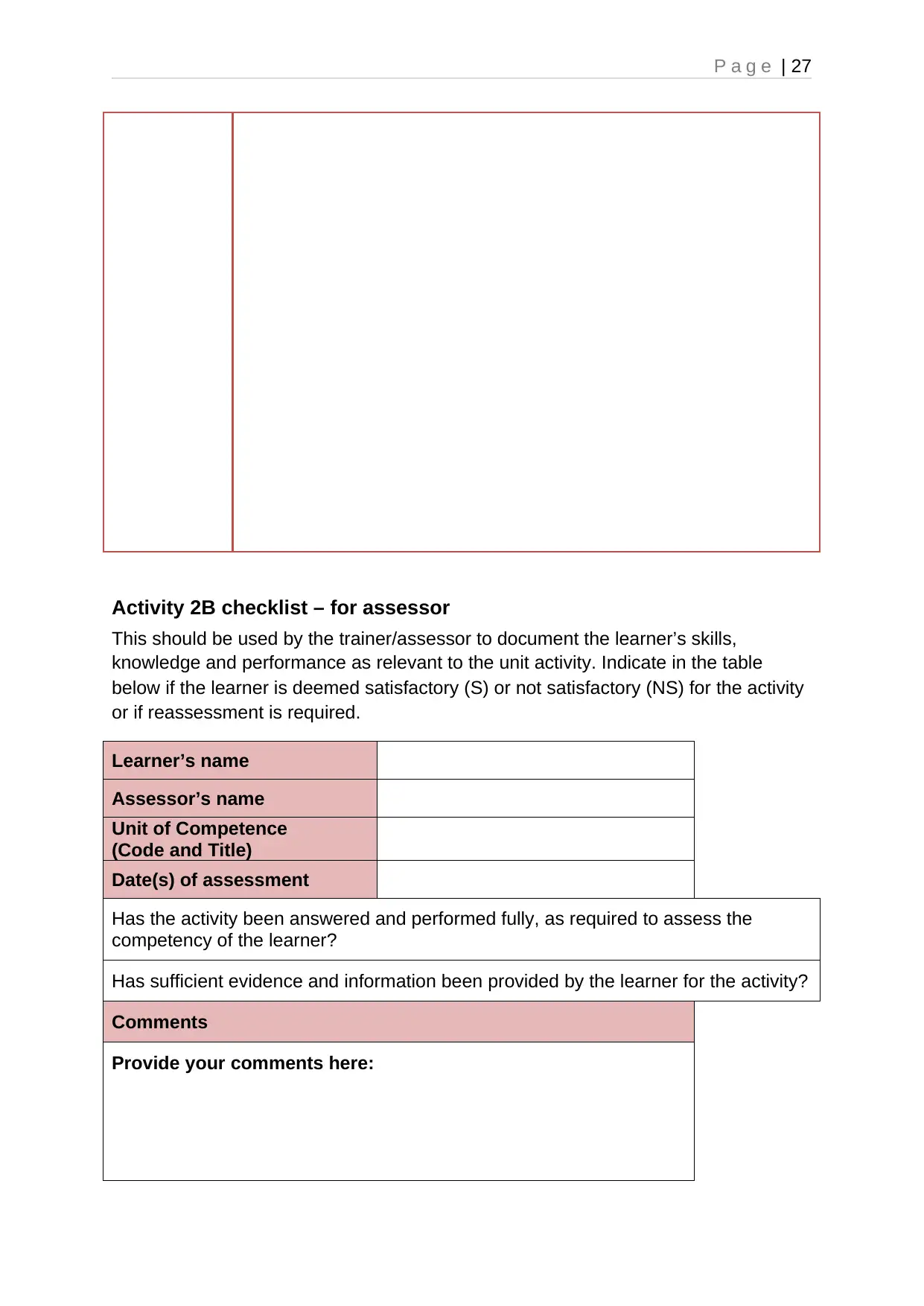
P a g e | 27
Activity 2B checklist – for assessor
This should be used by the trainer/assessor to document the learner’s skills,
knowledge and performance as relevant to the unit activity. Indicate in the table
below if the learner is deemed satisfactory (S) or not satisfactory (NS) for the activity
or if reassessment is required.
Learner’s name
Assessor’s name
Unit of Competence
(Code and Title)
Date(s) of assessment
Has the activity been answered and performed fully, as required to assess the
competency of the learner?
Has sufficient evidence and information been provided by the learner for the activity?
Comments
Provide your comments here:
Activity 2B checklist – for assessor
This should be used by the trainer/assessor to document the learner’s skills,
knowledge and performance as relevant to the unit activity. Indicate in the table
below if the learner is deemed satisfactory (S) or not satisfactory (NS) for the activity
or if reassessment is required.
Learner’s name
Assessor’s name
Unit of Competence
(Code and Title)
Date(s) of assessment
Has the activity been answered and performed fully, as required to assess the
competency of the learner?
Has sufficient evidence and information been provided by the learner for the activity?
Comments
Provide your comments here:
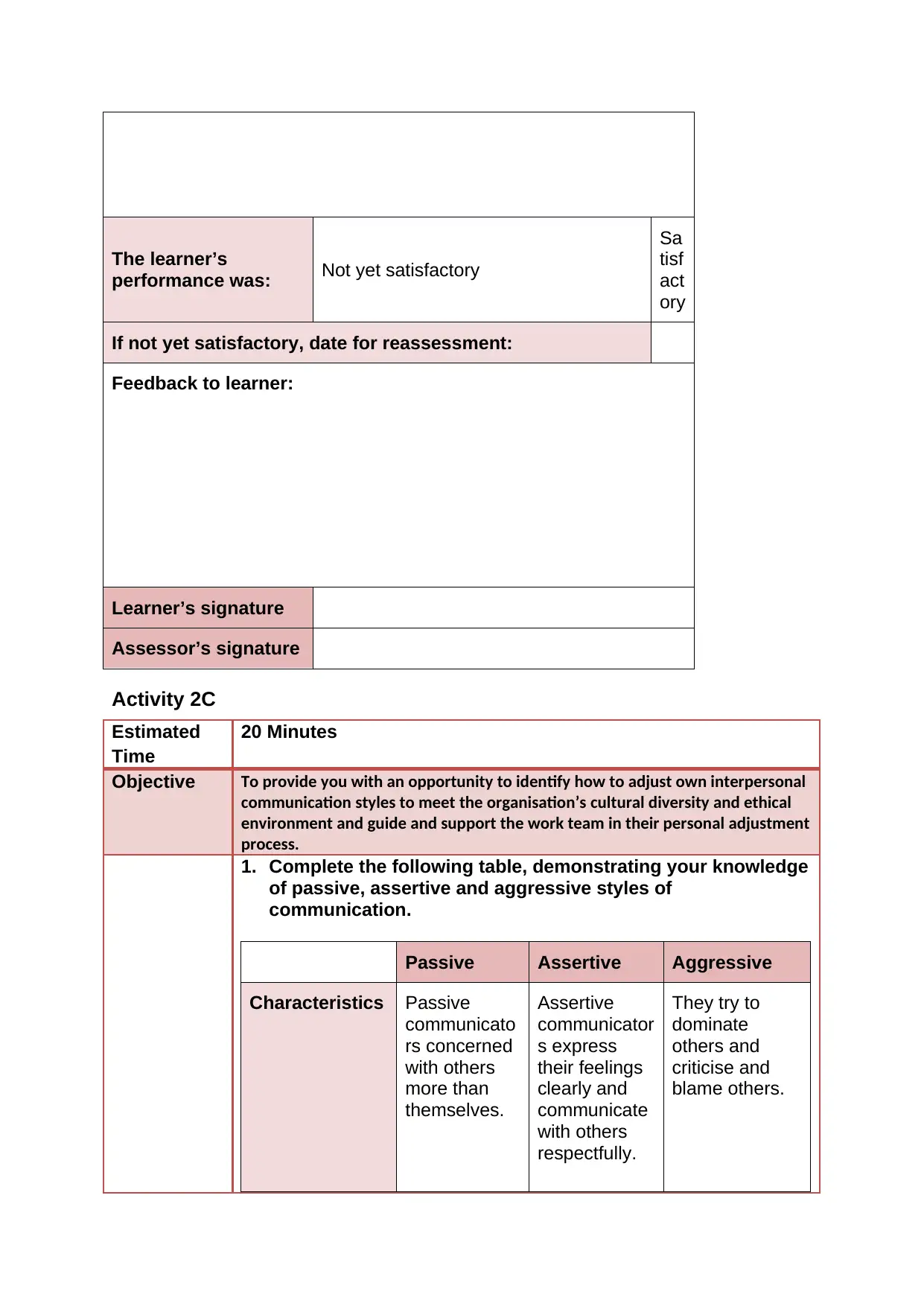
The learner’s
performance was: Not yet satisfactory
Sa
tisf
act
ory
If not yet satisfactory, date for reassessment:
Feedback to learner:
Learner’s signature
Assessor’s signature
Activity 2C
Estimated
Time
20 Minutes
Objective To provide you with an opportunity to identify how to adjust own interpersonal
communication styles to meet the organisation’s cultural diversity and ethical
environment and guide and support the work team in their personal adjustment
process.
1. Complete the following table, demonstrating your knowledge
of passive, assertive and aggressive styles of
communication.
Passive Assertive Aggressive
Characteristics Passive
communicato
rs concerned
with others
more than
themselves.
Assertive
communicator
s express
their feelings
clearly and
communicate
with others
respectfully.
They try to
dominate
others and
criticise and
blame others.
performance was: Not yet satisfactory
Sa
tisf
act
ory
If not yet satisfactory, date for reassessment:
Feedback to learner:
Learner’s signature
Assessor’s signature
Activity 2C
Estimated
Time
20 Minutes
Objective To provide you with an opportunity to identify how to adjust own interpersonal
communication styles to meet the organisation’s cultural diversity and ethical
environment and guide and support the work team in their personal adjustment
process.
1. Complete the following table, demonstrating your knowledge
of passive, assertive and aggressive styles of
communication.
Passive Assertive Aggressive
Characteristics Passive
communicato
rs concerned
with others
more than
themselves.
Assertive
communicator
s express
their feelings
clearly and
communicate
with others
respectfully.
They try to
dominate
others and
criticise and
blame others.
Secure Best Marks with AI Grader
Need help grading? Try our AI Grader for instant feedback on your assignments.
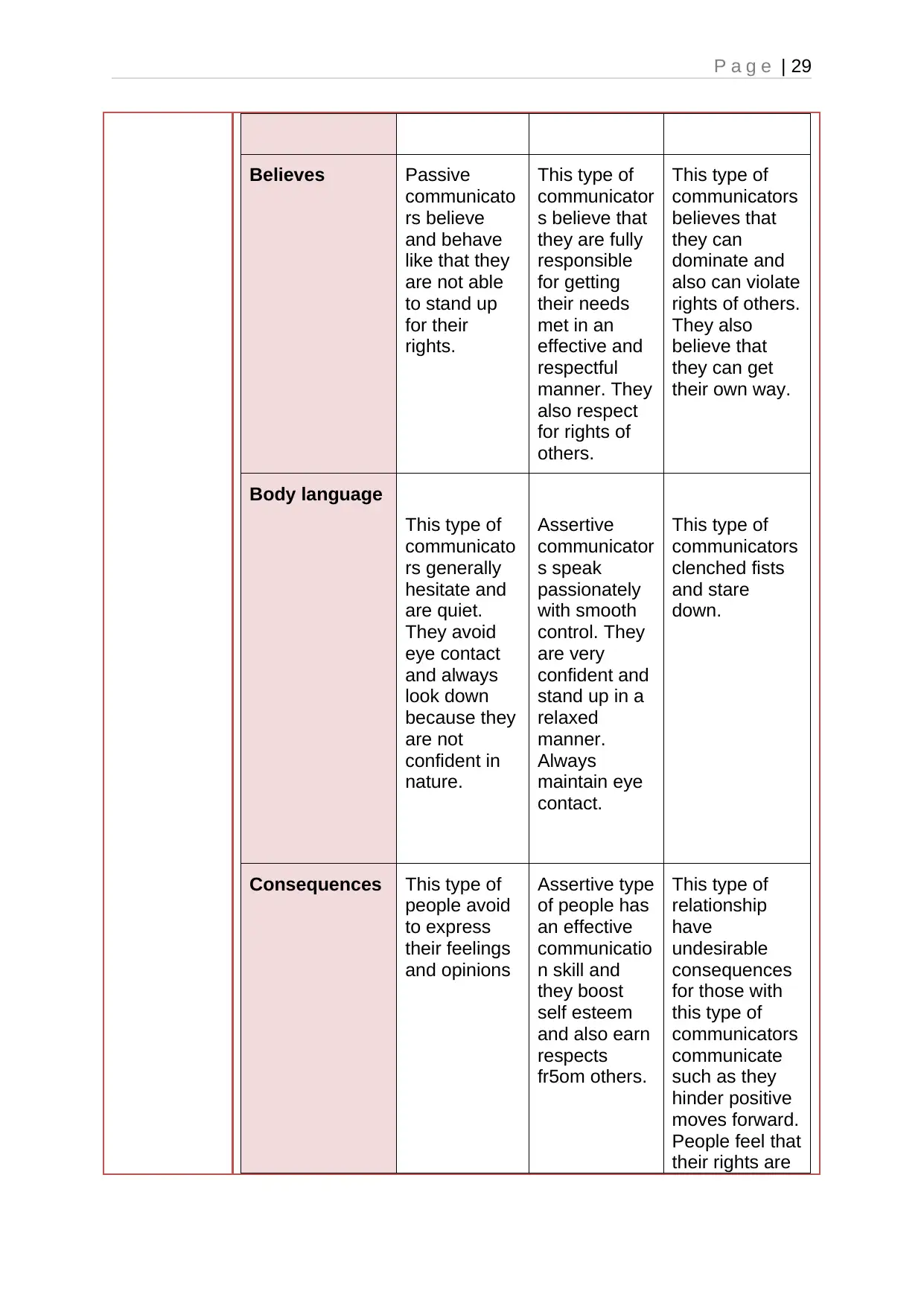
P a g e | 29
Believes Passive
communicato
rs believe
and behave
like that they
are not able
to stand up
for their
rights.
This type of
communicator
s believe that
they are fully
responsible
for getting
their needs
met in an
effective and
respectful
manner. They
also respect
for rights of
others.
This type of
communicators
believes that
they can
dominate and
also can violate
rights of others.
They also
believe that
they can get
their own way.
Body language
This type of
communicato
rs generally
hesitate and
are quiet.
They avoid
eye contact
and always
look down
because they
are not
confident in
nature.
Assertive
communicator
s speak
passionately
with smooth
control. They
are very
confident and
stand up in a
relaxed
manner.
Always
maintain eye
contact.
This type of
communicators
clenched fists
and stare
down.
Consequences This type of
people avoid
to express
their feelings
and opinions
Assertive type
of people has
an effective
communicatio
n skill and
they boost
self esteem
and also earn
respects
fr5om others.
This type of
relationship
have
undesirable
consequences
for those with
this type of
communicators
communicate
such as they
hinder positive
moves forward.
People feel that
their rights are
Believes Passive
communicato
rs believe
and behave
like that they
are not able
to stand up
for their
rights.
This type of
communicator
s believe that
they are fully
responsible
for getting
their needs
met in an
effective and
respectful
manner. They
also respect
for rights of
others.
This type of
communicators
believes that
they can
dominate and
also can violate
rights of others.
They also
believe that
they can get
their own way.
Body language
This type of
communicato
rs generally
hesitate and
are quiet.
They avoid
eye contact
and always
look down
because they
are not
confident in
nature.
Assertive
communicator
s speak
passionately
with smooth
control. They
are very
confident and
stand up in a
relaxed
manner.
Always
maintain eye
contact.
This type of
communicators
clenched fists
and stare
down.
Consequences This type of
people avoid
to express
their feelings
and opinions
Assertive type
of people has
an effective
communicatio
n skill and
they boost
self esteem
and also earn
respects
fr5om others.
This type of
relationship
have
undesirable
consequences
for those with
this type of
communicators
communicate
such as they
hinder positive
moves forward.
People feel that
their rights are
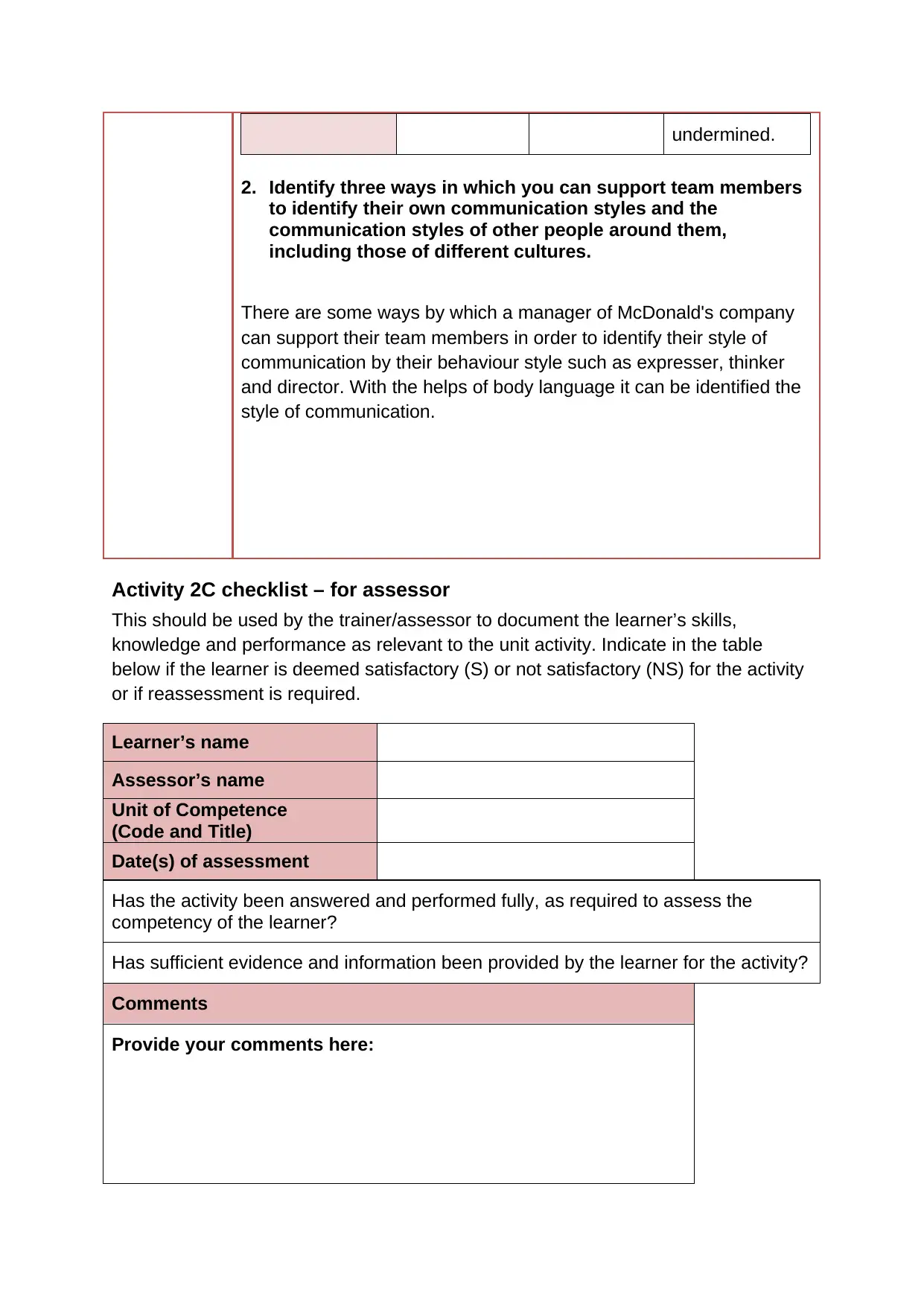
undermined.
2. Identify three ways in which you can support team members
to identify their own communication styles and the
communication styles of other people around them,
including those of different cultures.
There are some ways by which a manager of McDonald's company
can support their team members in order to identify their style of
communication by their behaviour style such as expresser, thinker
and director. With the helps of body language it can be identified the
style of communication.
Activity 2C checklist – for assessor
This should be used by the trainer/assessor to document the learner’s skills,
knowledge and performance as relevant to the unit activity. Indicate in the table
below if the learner is deemed satisfactory (S) or not satisfactory (NS) for the activity
or if reassessment is required.
Learner’s name
Assessor’s name
Unit of Competence
(Code and Title)
Date(s) of assessment
Has the activity been answered and performed fully, as required to assess the
competency of the learner?
Has sufficient evidence and information been provided by the learner for the activity?
Comments
Provide your comments here:
2. Identify three ways in which you can support team members
to identify their own communication styles and the
communication styles of other people around them,
including those of different cultures.
There are some ways by which a manager of McDonald's company
can support their team members in order to identify their style of
communication by their behaviour style such as expresser, thinker
and director. With the helps of body language it can be identified the
style of communication.
Activity 2C checklist – for assessor
This should be used by the trainer/assessor to document the learner’s skills,
knowledge and performance as relevant to the unit activity. Indicate in the table
below if the learner is deemed satisfactory (S) or not satisfactory (NS) for the activity
or if reassessment is required.
Learner’s name
Assessor’s name
Unit of Competence
(Code and Title)
Date(s) of assessment
Has the activity been answered and performed fully, as required to assess the
competency of the learner?
Has sufficient evidence and information been provided by the learner for the activity?
Comments
Provide your comments here:
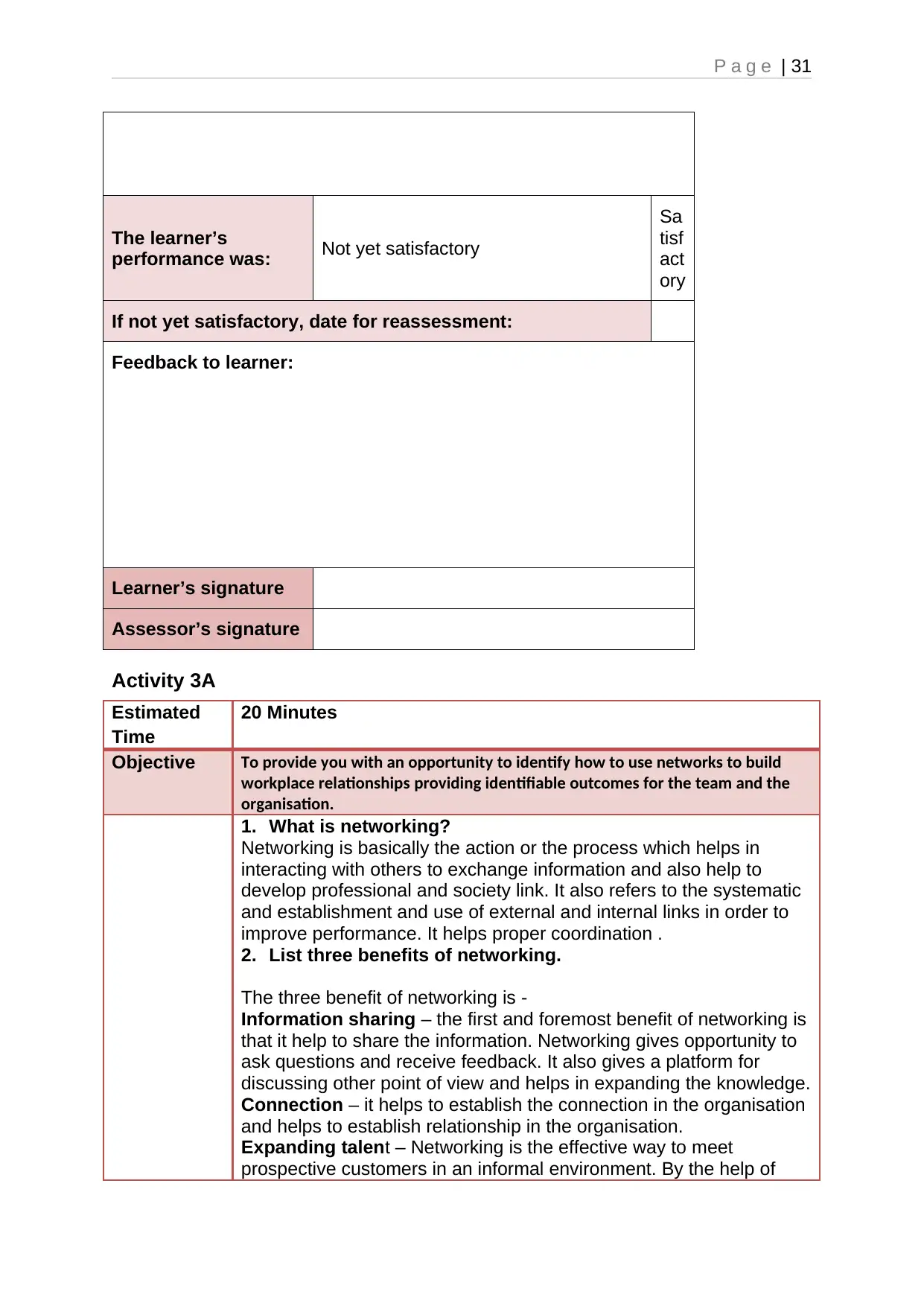
P a g e | 31
The learner’s
performance was: Not yet satisfactory
Sa
tisf
act
ory
If not yet satisfactory, date for reassessment:
Feedback to learner:
Learner’s signature
Assessor’s signature
Activity 3A
Estimated
Time
20 Minutes
Objective To provide you with an opportunity to identify how to use networks to build
workplace relationships providing identifiable outcomes for the team and the
organisation.
1. What is networking?
Networking is basically the action or the process which helps in
interacting with others to exchange information and also help to
develop professional and society link. It also refers to the systematic
and establishment and use of external and internal links in order to
improve performance. It helps proper coordination .
2. List three benefits of networking.
The three benefit of networking is -
Information sharing – the first and foremost benefit of networking is
that it help to share the information. Networking gives opportunity to
ask questions and receive feedback. It also gives a platform for
discussing other point of view and helps in expanding the knowledge.
Connection – it helps to establish the connection in the organisation
and helps to establish relationship in the organisation.
Expanding talent – Networking is the effective way to meet
prospective customers in an informal environment. By the help of
The learner’s
performance was: Not yet satisfactory
Sa
tisf
act
ory
If not yet satisfactory, date for reassessment:
Feedback to learner:
Learner’s signature
Assessor’s signature
Activity 3A
Estimated
Time
20 Minutes
Objective To provide you with an opportunity to identify how to use networks to build
workplace relationships providing identifiable outcomes for the team and the
organisation.
1. What is networking?
Networking is basically the action or the process which helps in
interacting with others to exchange information and also help to
develop professional and society link. It also refers to the systematic
and establishment and use of external and internal links in order to
improve performance. It helps proper coordination .
2. List three benefits of networking.
The three benefit of networking is -
Information sharing – the first and foremost benefit of networking is
that it help to share the information. Networking gives opportunity to
ask questions and receive feedback. It also gives a platform for
discussing other point of view and helps in expanding the knowledge.
Connection – it helps to establish the connection in the organisation
and helps to establish relationship in the organisation.
Expanding talent – Networking is the effective way to meet
prospective customers in an informal environment. By the help of
Paraphrase This Document
Need a fresh take? Get an instant paraphrase of this document with our AI Paraphraser
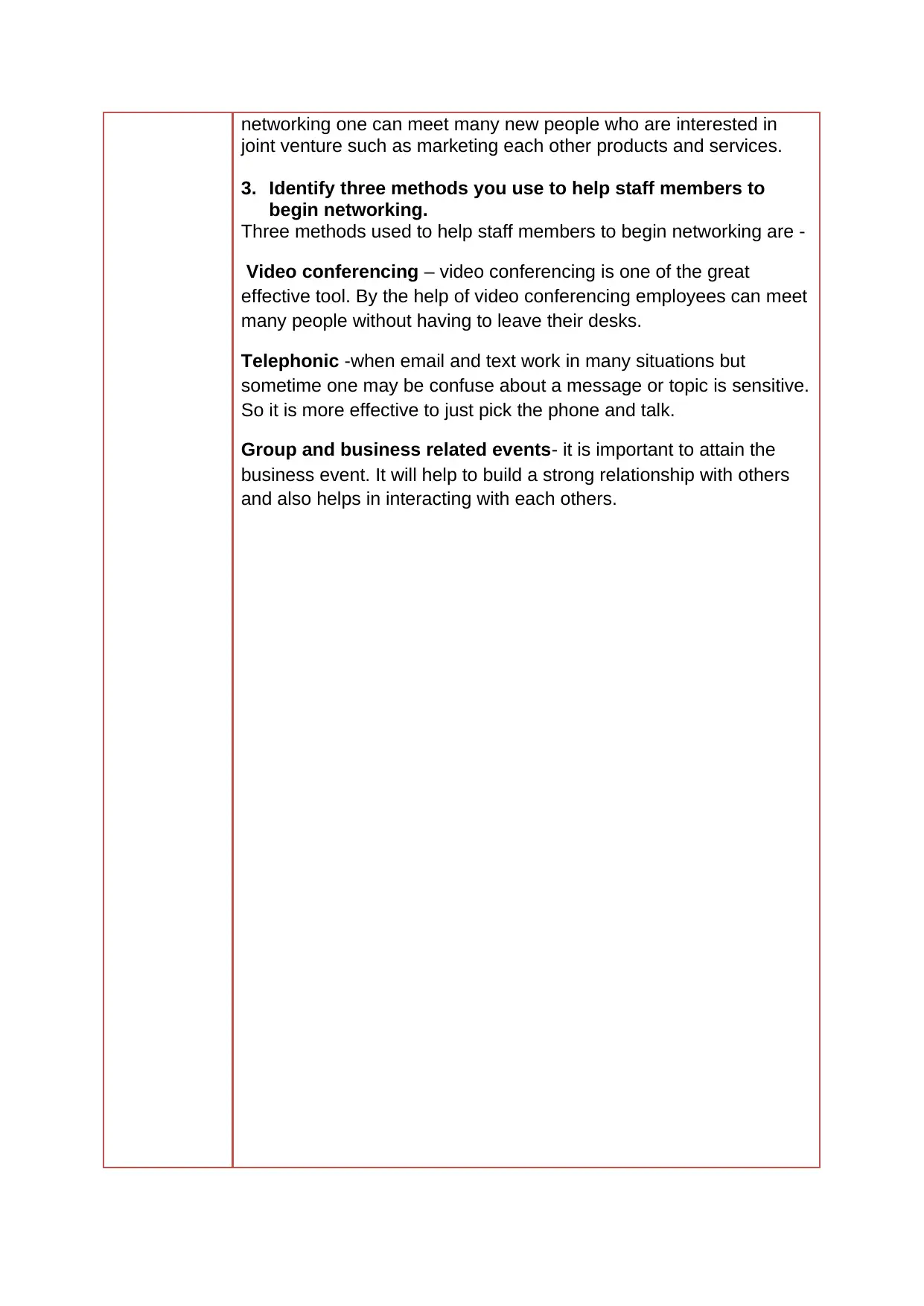
networking one can meet many new people who are interested in
joint venture such as marketing each other products and services.
3. Identify three methods you use to help staff members to
begin networking.
Three methods used to help staff members to begin networking are -
Video conferencing – video conferencing is one of the great
effective tool. By the help of video conferencing employees can meet
many people without having to leave their desks.
Telephonic -when email and text work in many situations but
sometime one may be confuse about a message or topic is sensitive.
So it is more effective to just pick the phone and talk.
Group and business related events- it is important to attain the
business event. It will help to build a strong relationship with others
and also helps in interacting with each others.
joint venture such as marketing each other products and services.
3. Identify three methods you use to help staff members to
begin networking.
Three methods used to help staff members to begin networking are -
Video conferencing – video conferencing is one of the great
effective tool. By the help of video conferencing employees can meet
many people without having to leave their desks.
Telephonic -when email and text work in many situations but
sometime one may be confuse about a message or topic is sensitive.
So it is more effective to just pick the phone and talk.
Group and business related events- it is important to attain the
business event. It will help to build a strong relationship with others
and also helps in interacting with each others.
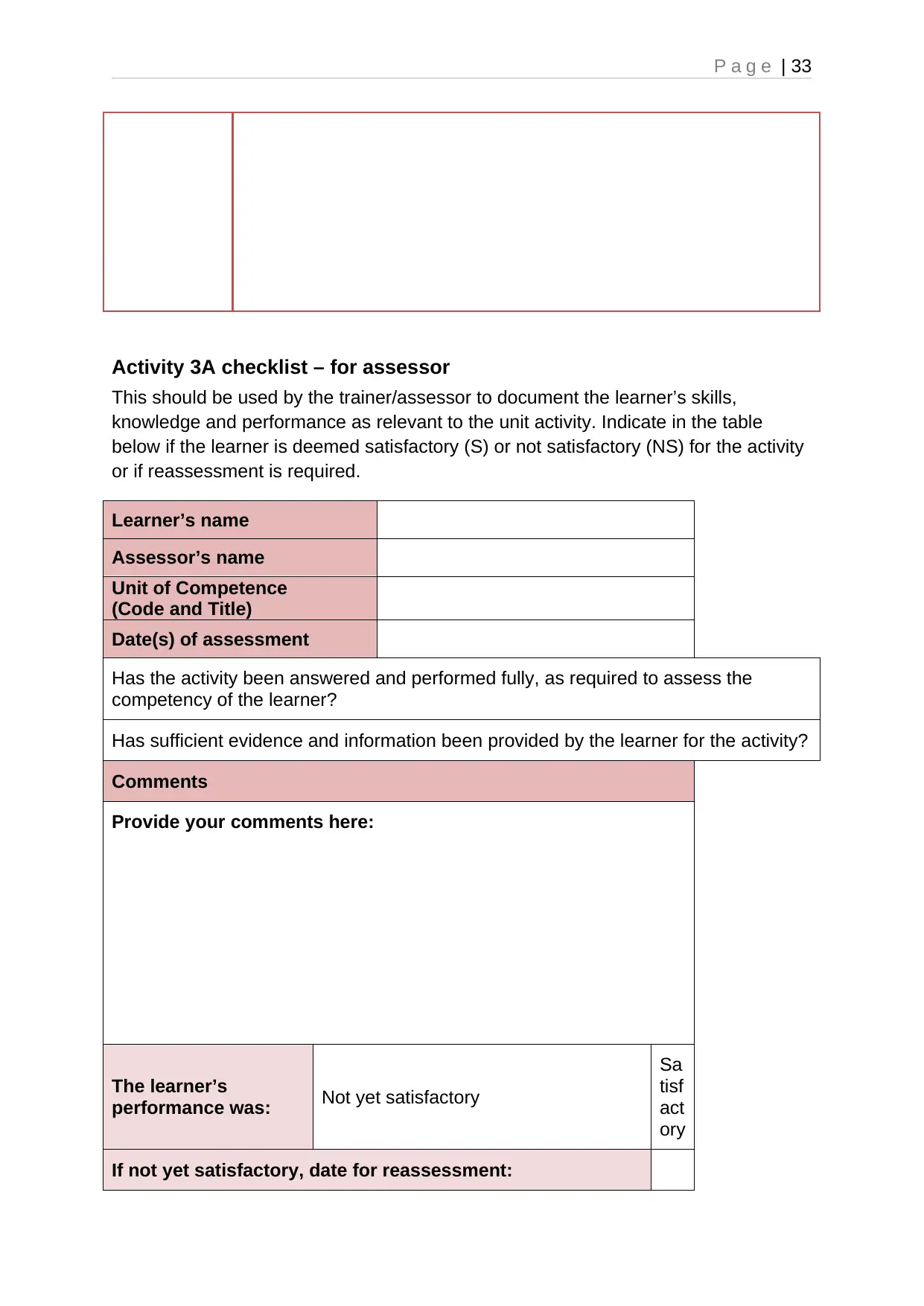
P a g e | 33
Activity 3A checklist – for assessor
This should be used by the trainer/assessor to document the learner’s skills,
knowledge and performance as relevant to the unit activity. Indicate in the table
below if the learner is deemed satisfactory (S) or not satisfactory (NS) for the activity
or if reassessment is required.
Learner’s name
Assessor’s name
Unit of Competence
(Code and Title)
Date(s) of assessment
Has the activity been answered and performed fully, as required to assess the
competency of the learner?
Has sufficient evidence and information been provided by the learner for the activity?
Comments
Provide your comments here:
The learner’s
performance was: Not yet satisfactory
Sa
tisf
act
ory
If not yet satisfactory, date for reassessment:
Activity 3A checklist – for assessor
This should be used by the trainer/assessor to document the learner’s skills,
knowledge and performance as relevant to the unit activity. Indicate in the table
below if the learner is deemed satisfactory (S) or not satisfactory (NS) for the activity
or if reassessment is required.
Learner’s name
Assessor’s name
Unit of Competence
(Code and Title)
Date(s) of assessment
Has the activity been answered and performed fully, as required to assess the
competency of the learner?
Has sufficient evidence and information been provided by the learner for the activity?
Comments
Provide your comments here:
The learner’s
performance was: Not yet satisfactory
Sa
tisf
act
ory
If not yet satisfactory, date for reassessment:
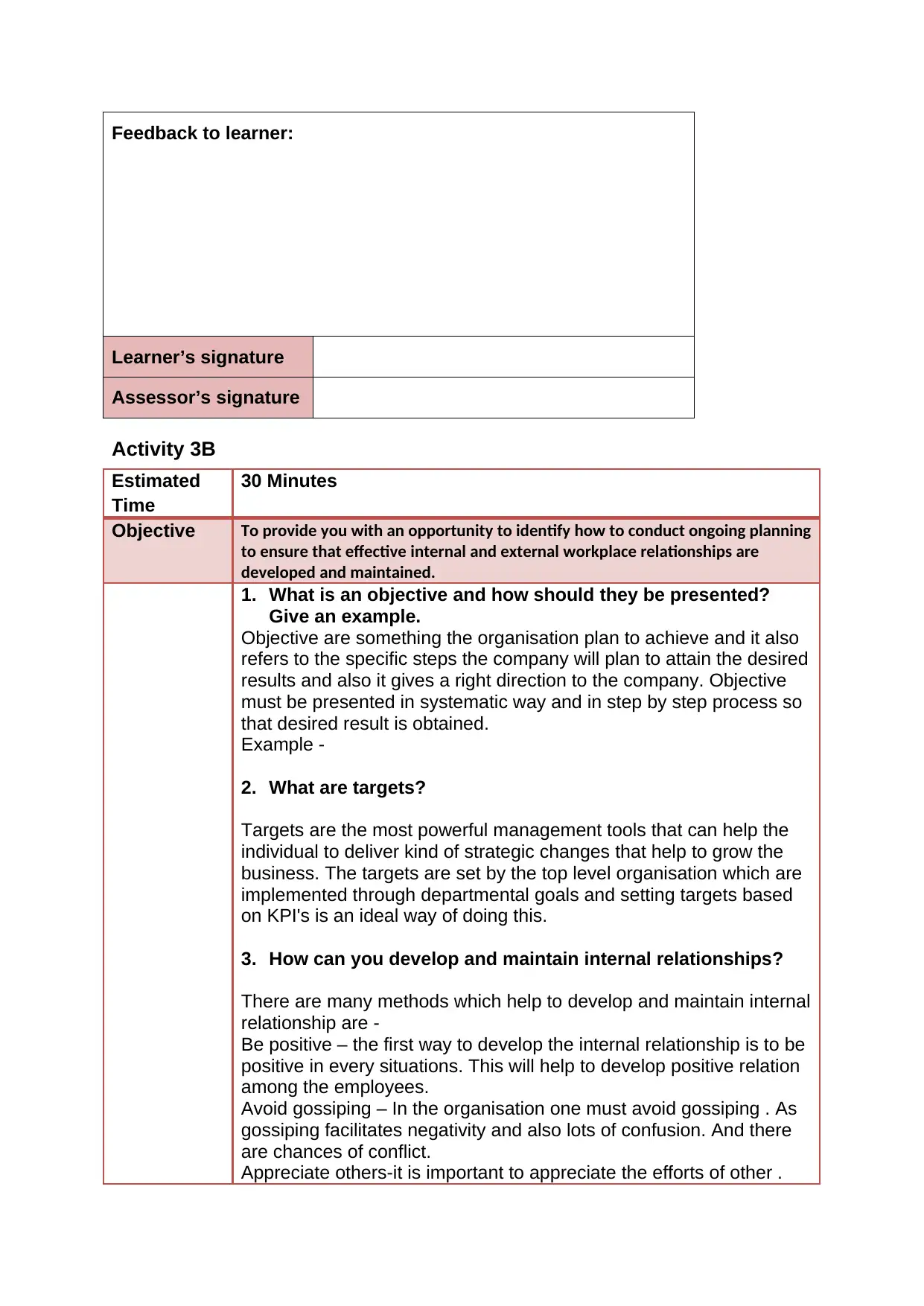
Feedback to learner:
Learner’s signature
Assessor’s signature
Activity 3B
Estimated
Time
30 Minutes
Objective To provide you with an opportunity to identify how to conduct ongoing planning
to ensure that effective internal and external workplace relationships are
developed and maintained.
1. What is an objective and how should they be presented?
Give an example.
Objective are something the organisation plan to achieve and it also
refers to the specific steps the company will plan to attain the desired
results and also it gives a right direction to the company. Objective
must be presented in systematic way and in step by step process so
that desired result is obtained.
Example -
2. What are targets?
Targets are the most powerful management tools that can help the
individual to deliver kind of strategic changes that help to grow the
business. The targets are set by the top level organisation which are
implemented through departmental goals and setting targets based
on KPI's is an ideal way of doing this.
3. How can you develop and maintain internal relationships?
There are many methods which help to develop and maintain internal
relationship are -
Be positive – the first way to develop the internal relationship is to be
positive in every situations. This will help to develop positive relation
among the employees.
Avoid gossiping – In the organisation one must avoid gossiping . As
gossiping facilitates negativity and also lots of confusion. And there
are chances of conflict.
Appreciate others-it is important to appreciate the efforts of other .
Learner’s signature
Assessor’s signature
Activity 3B
Estimated
Time
30 Minutes
Objective To provide you with an opportunity to identify how to conduct ongoing planning
to ensure that effective internal and external workplace relationships are
developed and maintained.
1. What is an objective and how should they be presented?
Give an example.
Objective are something the organisation plan to achieve and it also
refers to the specific steps the company will plan to attain the desired
results and also it gives a right direction to the company. Objective
must be presented in systematic way and in step by step process so
that desired result is obtained.
Example -
2. What are targets?
Targets are the most powerful management tools that can help the
individual to deliver kind of strategic changes that help to grow the
business. The targets are set by the top level organisation which are
implemented through departmental goals and setting targets based
on KPI's is an ideal way of doing this.
3. How can you develop and maintain internal relationships?
There are many methods which help to develop and maintain internal
relationship are -
Be positive – the first way to develop the internal relationship is to be
positive in every situations. This will help to develop positive relation
among the employees.
Avoid gossiping – In the organisation one must avoid gossiping . As
gossiping facilitates negativity and also lots of confusion. And there
are chances of conflict.
Appreciate others-it is important to appreciate the efforts of other .
Secure Best Marks with AI Grader
Need help grading? Try our AI Grader for instant feedback on your assignments.
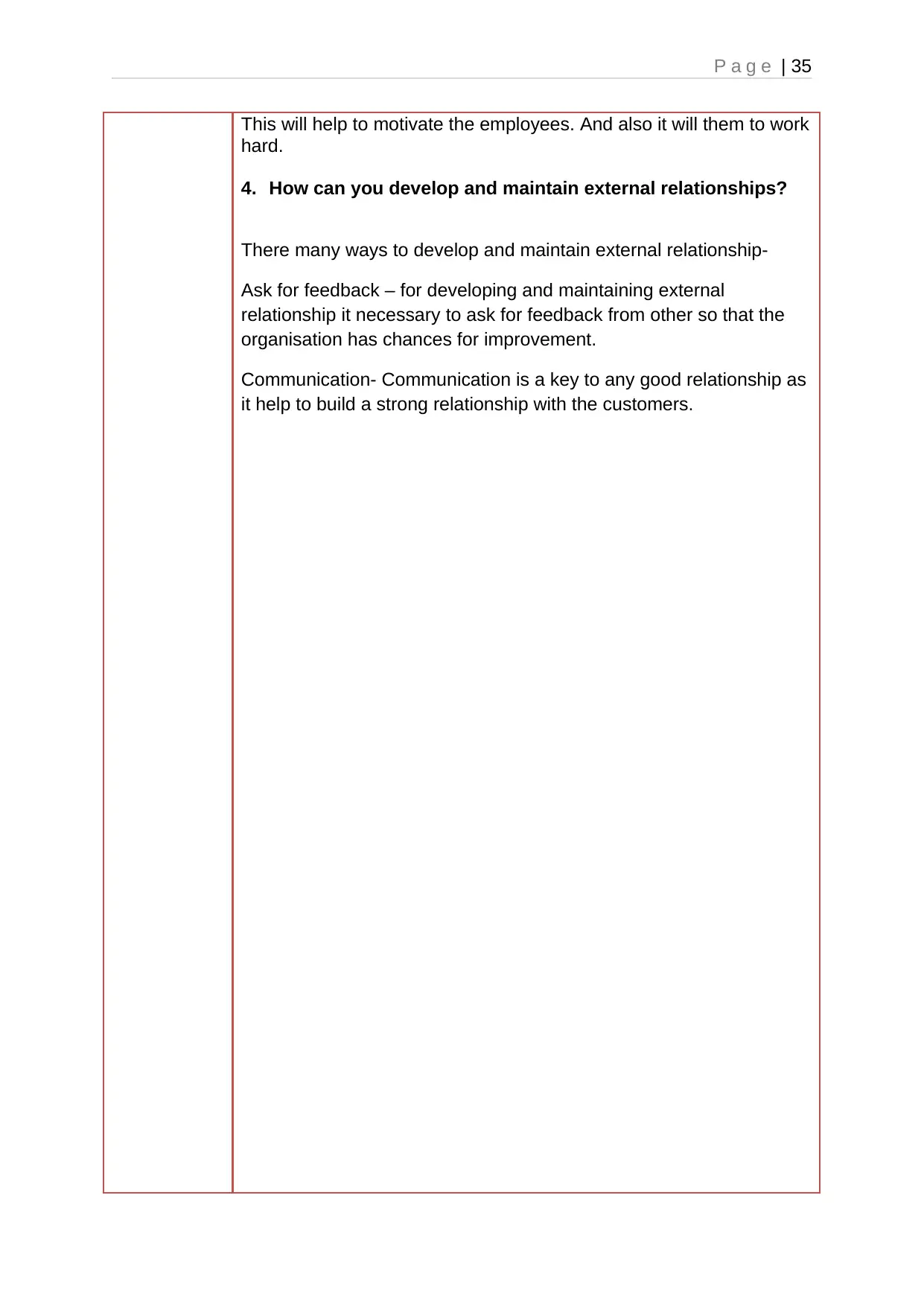
P a g e | 35
This will help to motivate the employees. And also it will them to work
hard.
4. How can you develop and maintain external relationships?
There many ways to develop and maintain external relationship-
Ask for feedback – for developing and maintaining external
relationship it necessary to ask for feedback from other so that the
organisation has chances for improvement.
Communication- Communication is a key to any good relationship as
it help to build a strong relationship with the customers.
This will help to motivate the employees. And also it will them to work
hard.
4. How can you develop and maintain external relationships?
There many ways to develop and maintain external relationship-
Ask for feedback – for developing and maintaining external
relationship it necessary to ask for feedback from other so that the
organisation has chances for improvement.
Communication- Communication is a key to any good relationship as
it help to build a strong relationship with the customers.
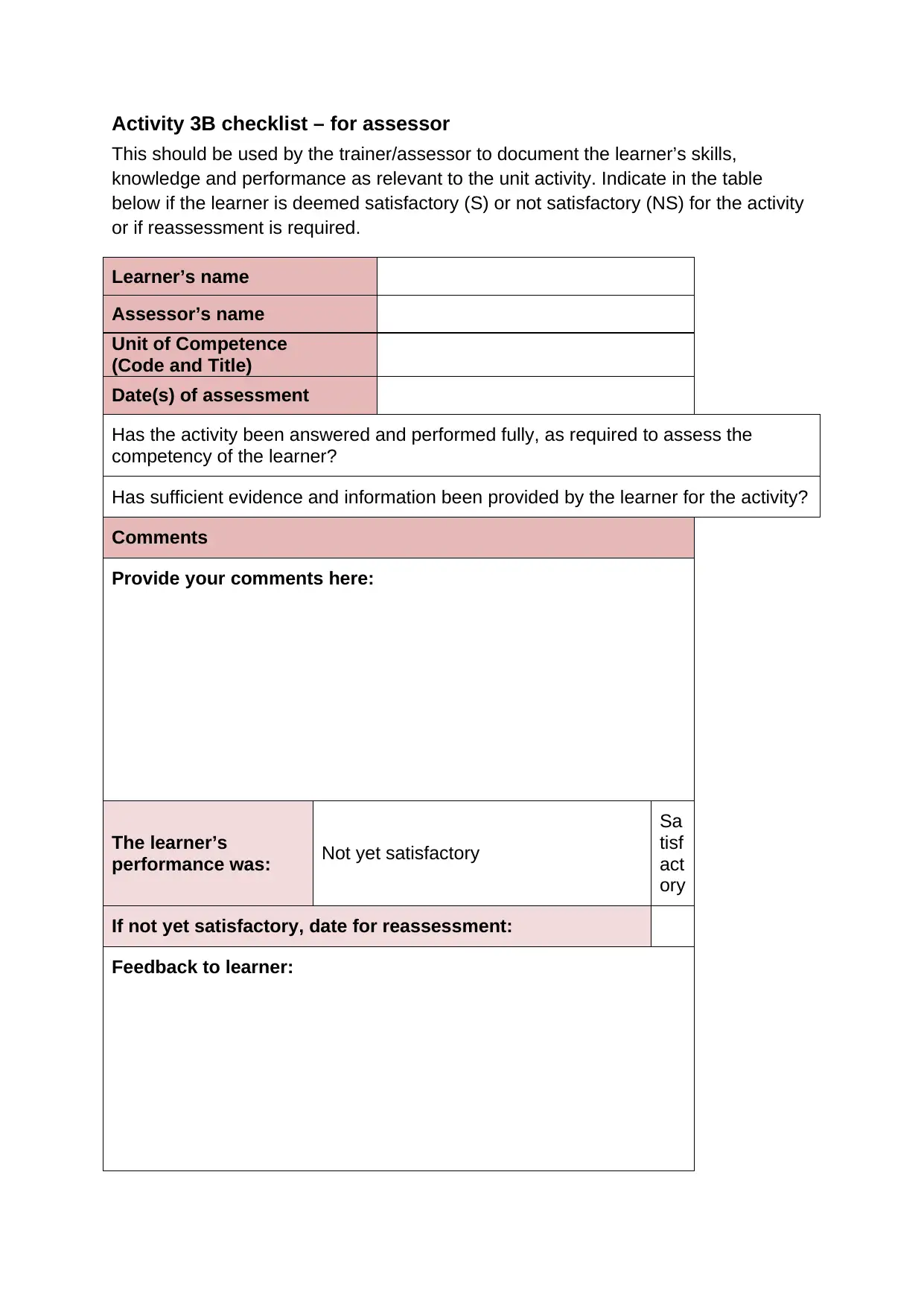
Activity 3B checklist – for assessor
This should be used by the trainer/assessor to document the learner’s skills,
knowledge and performance as relevant to the unit activity. Indicate in the table
below if the learner is deemed satisfactory (S) or not satisfactory (NS) for the activity
or if reassessment is required.
Learner’s name
Assessor’s name
Unit of Competence
(Code and Title)
Date(s) of assessment
Has the activity been answered and performed fully, as required to assess the
competency of the learner?
Has sufficient evidence and information been provided by the learner for the activity?
Comments
Provide your comments here:
The learner’s
performance was: Not yet satisfactory
Sa
tisf
act
ory
If not yet satisfactory, date for reassessment:
Feedback to learner:
This should be used by the trainer/assessor to document the learner’s skills,
knowledge and performance as relevant to the unit activity. Indicate in the table
below if the learner is deemed satisfactory (S) or not satisfactory (NS) for the activity
or if reassessment is required.
Learner’s name
Assessor’s name
Unit of Competence
(Code and Title)
Date(s) of assessment
Has the activity been answered and performed fully, as required to assess the
competency of the learner?
Has sufficient evidence and information been provided by the learner for the activity?
Comments
Provide your comments here:
The learner’s
performance was: Not yet satisfactory
Sa
tisf
act
ory
If not yet satisfactory, date for reassessment:
Feedback to learner:
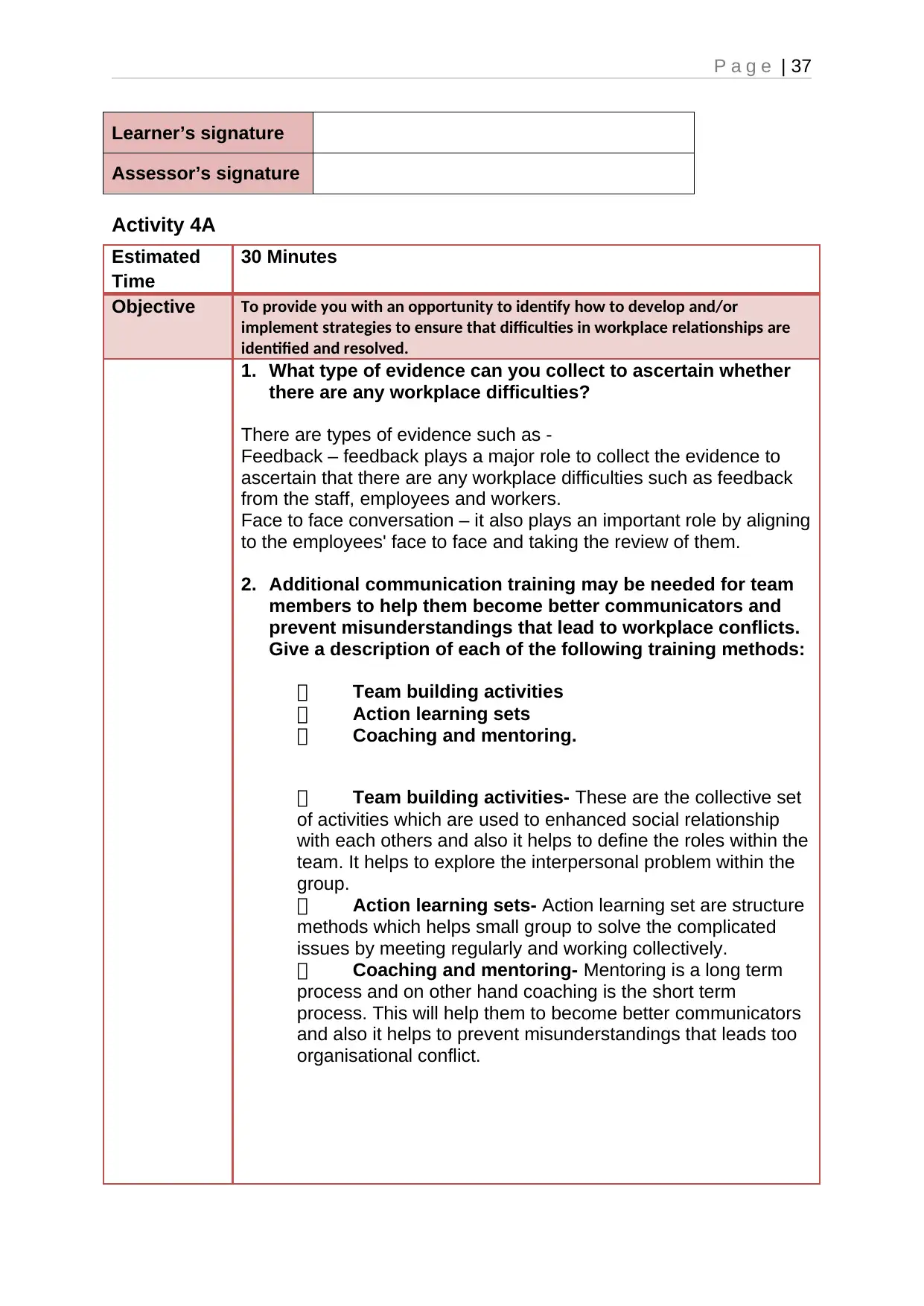
P a g e | 37
Learner’s signature
Assessor’s signature
Activity 4A
Estimated
Time
30 Minutes
Objective To provide you with an opportunity to identify how to develop and/or
implement strategies to ensure that difficulties in workplace relationships are
identified and resolved.
1. What type of evidence can you collect to ascertain whether
there are any workplace difficulties?
There are types of evidence such as -
Feedback – feedback plays a major role to collect the evidence to
ascertain that there are any workplace difficulties such as feedback
from the staff, employees and workers.
Face to face conversation – it also plays an important role by aligning
to the employees' face to face and taking the review of them.
2. Additional communication training may be needed for team
members to help them become better communicators and
prevent misunderstandings that lead to workplace conflicts.
Give a description of each of the following training methods:
Team building activities
Action learning sets
Coaching and mentoring.
Team building activities- These are the collective set
of activities which are used to enhanced social relationship
with each others and also it helps to define the roles within the
team. It helps to explore the interpersonal problem within the
group.
Action learning sets- Action learning set are structure
methods which helps small group to solve the complicated
issues by meeting regularly and working collectively.
Coaching and mentoring- Mentoring is a long term
process and on other hand coaching is the short term
process. This will help them to become better communicators
and also it helps to prevent misunderstandings that leads too
organisational conflict.
Learner’s signature
Assessor’s signature
Activity 4A
Estimated
Time
30 Minutes
Objective To provide you with an opportunity to identify how to develop and/or
implement strategies to ensure that difficulties in workplace relationships are
identified and resolved.
1. What type of evidence can you collect to ascertain whether
there are any workplace difficulties?
There are types of evidence such as -
Feedback – feedback plays a major role to collect the evidence to
ascertain that there are any workplace difficulties such as feedback
from the staff, employees and workers.
Face to face conversation – it also plays an important role by aligning
to the employees' face to face and taking the review of them.
2. Additional communication training may be needed for team
members to help them become better communicators and
prevent misunderstandings that lead to workplace conflicts.
Give a description of each of the following training methods:
Team building activities
Action learning sets
Coaching and mentoring.
Team building activities- These are the collective set
of activities which are used to enhanced social relationship
with each others and also it helps to define the roles within the
team. It helps to explore the interpersonal problem within the
group.
Action learning sets- Action learning set are structure
methods which helps small group to solve the complicated
issues by meeting regularly and working collectively.
Coaching and mentoring- Mentoring is a long term
process and on other hand coaching is the short term
process. This will help them to become better communicators
and also it helps to prevent misunderstandings that leads too
organisational conflict.
Paraphrase This Document
Need a fresh take? Get an instant paraphrase of this document with our AI Paraphraser
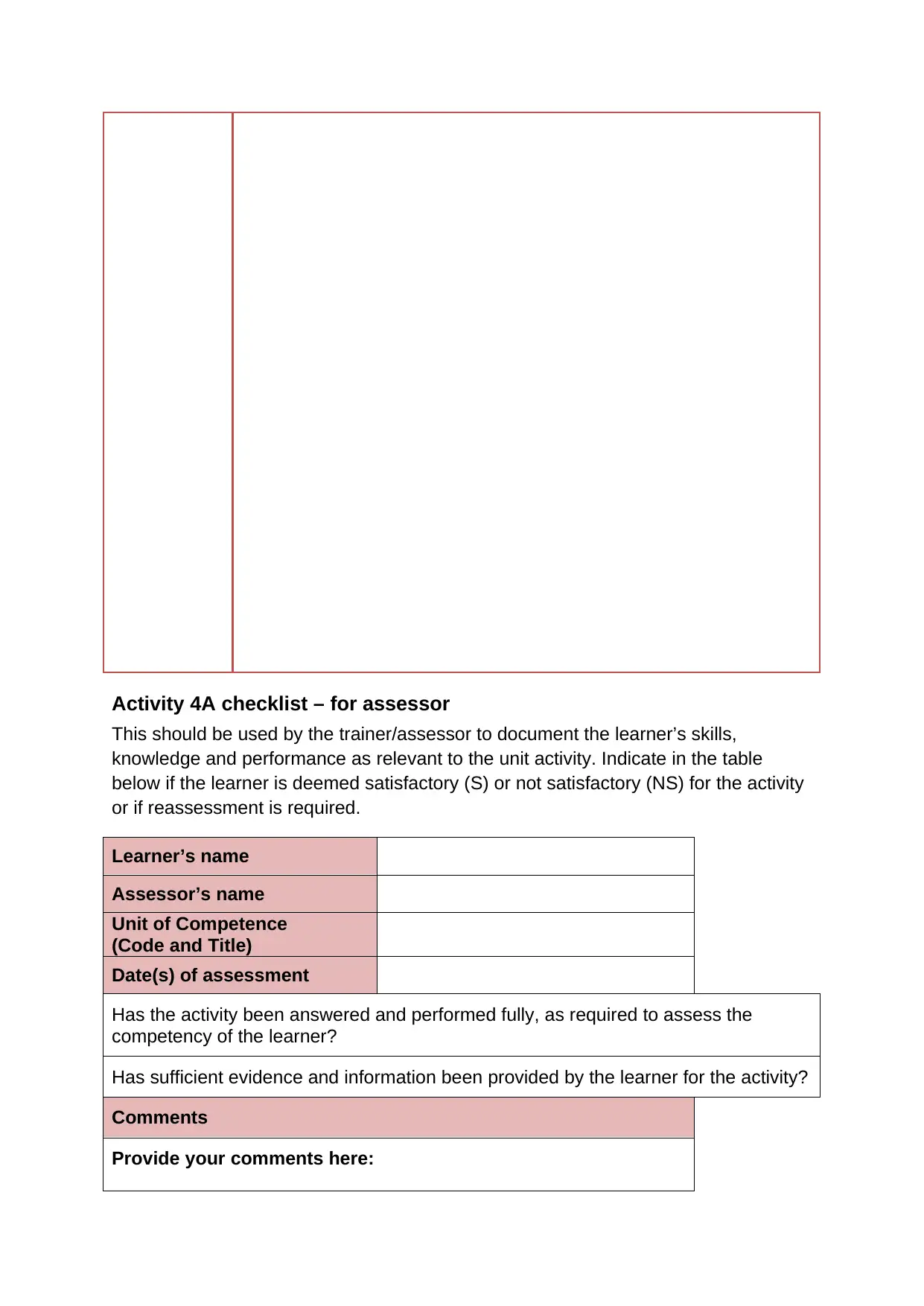
Activity 4A checklist – for assessor
This should be used by the trainer/assessor to document the learner’s skills,
knowledge and performance as relevant to the unit activity. Indicate in the table
below if the learner is deemed satisfactory (S) or not satisfactory (NS) for the activity
or if reassessment is required.
Learner’s name
Assessor’s name
Unit of Competence
(Code and Title)
Date(s) of assessment
Has the activity been answered and performed fully, as required to assess the
competency of the learner?
Has sufficient evidence and information been provided by the learner for the activity?
Comments
Provide your comments here:
This should be used by the trainer/assessor to document the learner’s skills,
knowledge and performance as relevant to the unit activity. Indicate in the table
below if the learner is deemed satisfactory (S) or not satisfactory (NS) for the activity
or if reassessment is required.
Learner’s name
Assessor’s name
Unit of Competence
(Code and Title)
Date(s) of assessment
Has the activity been answered and performed fully, as required to assess the
competency of the learner?
Has sufficient evidence and information been provided by the learner for the activity?
Comments
Provide your comments here:
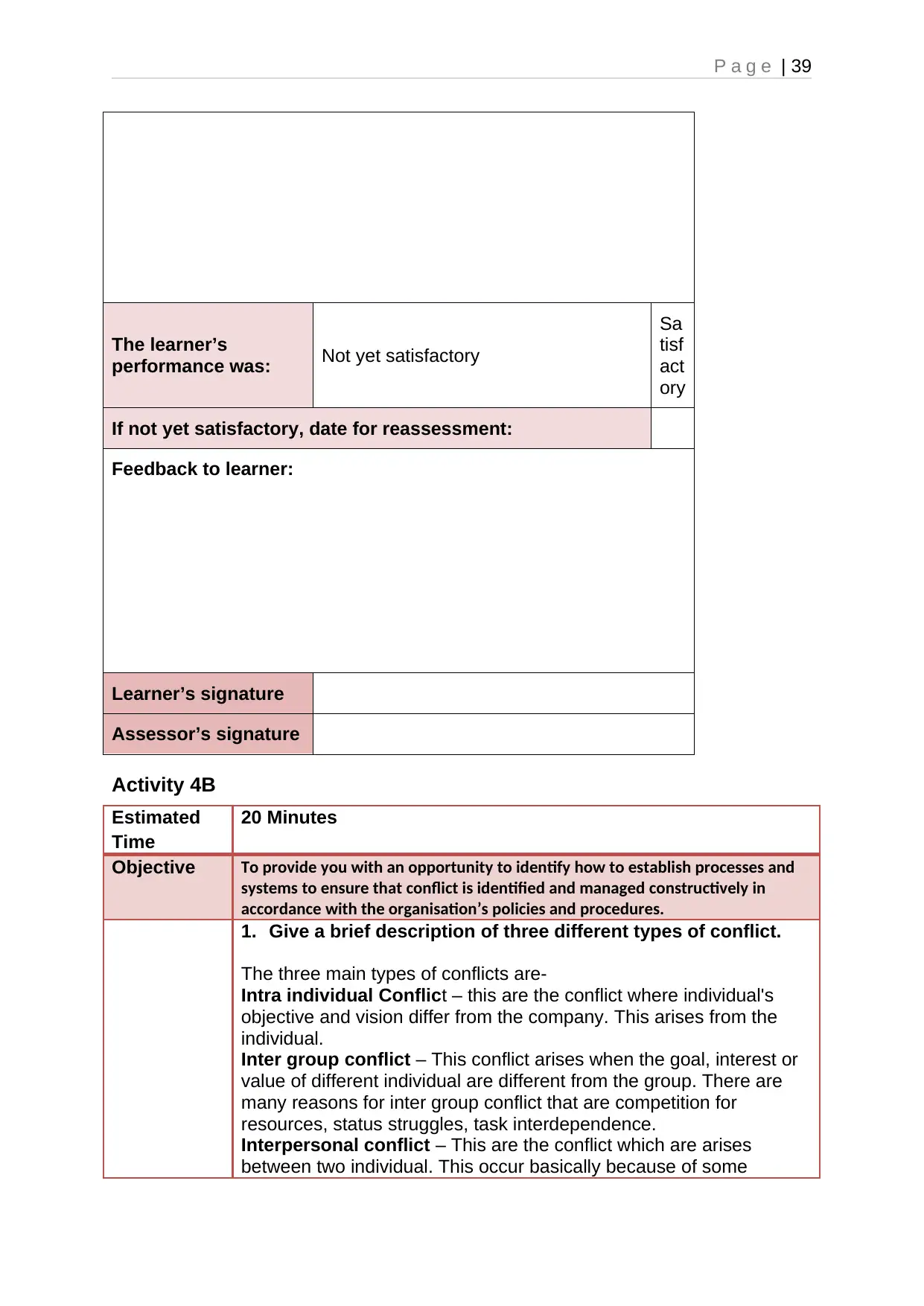
P a g e | 39
The learner’s
performance was: Not yet satisfactory
Sa
tisf
act
ory
If not yet satisfactory, date for reassessment:
Feedback to learner:
Learner’s signature
Assessor’s signature
Activity 4B
Estimated
Time
20 Minutes
Objective To provide you with an opportunity to identify how to establish processes and
systems to ensure that conflict is identified and managed constructively in
accordance with the organisation’s policies and procedures.
1. Give a brief description of three different types of conflict.
The three main types of conflicts are-
Intra individual Conflict – this are the conflict where individual's
objective and vision differ from the company. This arises from the
individual.
Inter group conflict – This conflict arises when the goal, interest or
value of different individual are different from the group. There are
many reasons for inter group conflict that are competition for
resources, status struggles, task interdependence.
Interpersonal conflict – This are the conflict which are arises
between two individual. This occur basically because of some
The learner’s
performance was: Not yet satisfactory
Sa
tisf
act
ory
If not yet satisfactory, date for reassessment:
Feedback to learner:
Learner’s signature
Assessor’s signature
Activity 4B
Estimated
Time
20 Minutes
Objective To provide you with an opportunity to identify how to establish processes and
systems to ensure that conflict is identified and managed constructively in
accordance with the organisation’s policies and procedures.
1. Give a brief description of three different types of conflict.
The three main types of conflicts are-
Intra individual Conflict – this are the conflict where individual's
objective and vision differ from the company. This arises from the
individual.
Inter group conflict – This conflict arises when the goal, interest or
value of different individual are different from the group. There are
many reasons for inter group conflict that are competition for
resources, status struggles, task interdependence.
Interpersonal conflict – This are the conflict which are arises
between two individual. This occur basically because of some
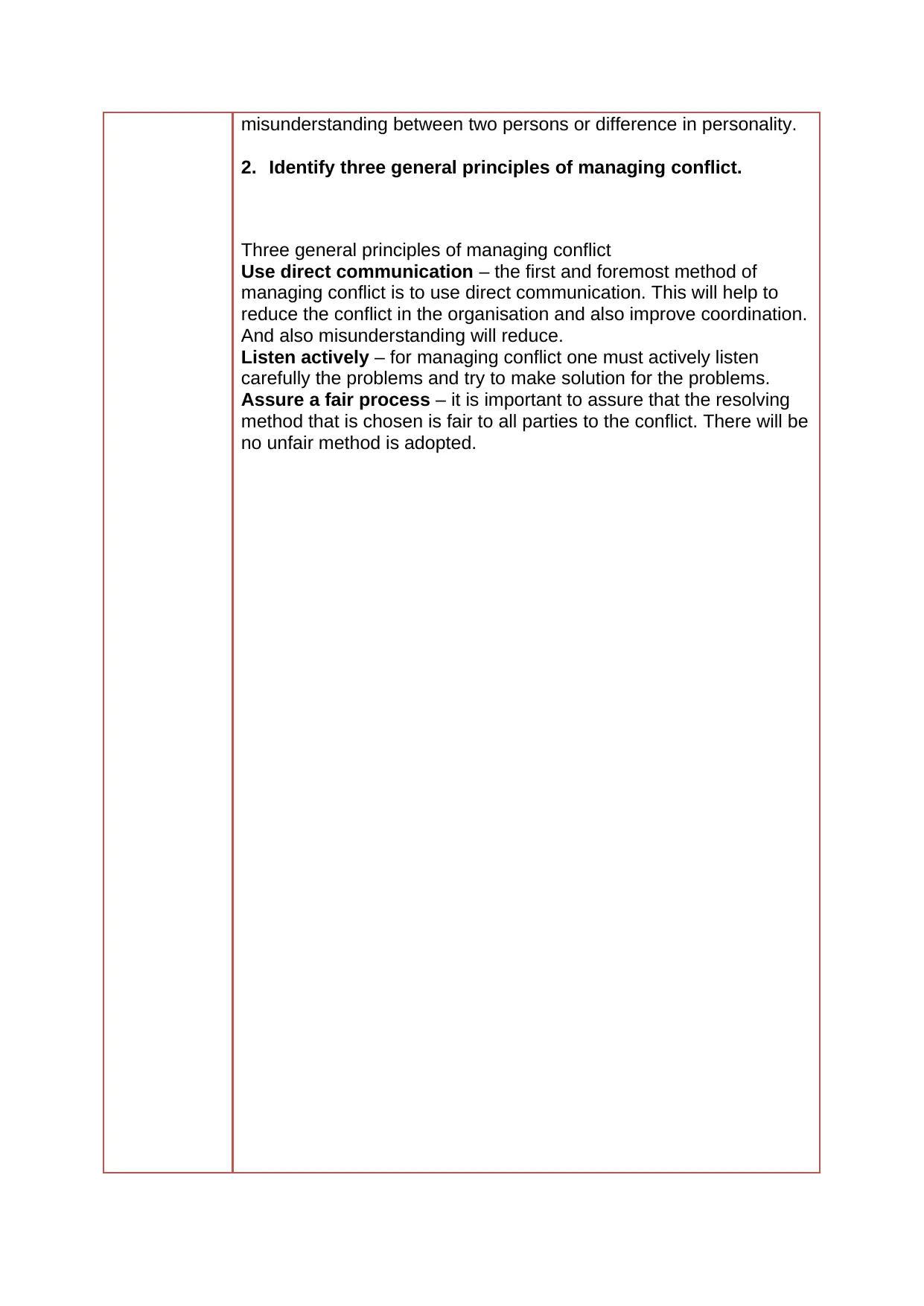
misunderstanding between two persons or difference in personality.
2. Identify three general principles of managing conflict.
Three general principles of managing conflict
Use direct communication – the first and foremost method of
managing conflict is to use direct communication. This will help to
reduce the conflict in the organisation and also improve coordination.
And also misunderstanding will reduce.
Listen actively – for managing conflict one must actively listen
carefully the problems and try to make solution for the problems.
Assure a fair process – it is important to assure that the resolving
method that is chosen is fair to all parties to the conflict. There will be
no unfair method is adopted.
2. Identify three general principles of managing conflict.
Three general principles of managing conflict
Use direct communication – the first and foremost method of
managing conflict is to use direct communication. This will help to
reduce the conflict in the organisation and also improve coordination.
And also misunderstanding will reduce.
Listen actively – for managing conflict one must actively listen
carefully the problems and try to make solution for the problems.
Assure a fair process – it is important to assure that the resolving
method that is chosen is fair to all parties to the conflict. There will be
no unfair method is adopted.
Secure Best Marks with AI Grader
Need help grading? Try our AI Grader for instant feedback on your assignments.
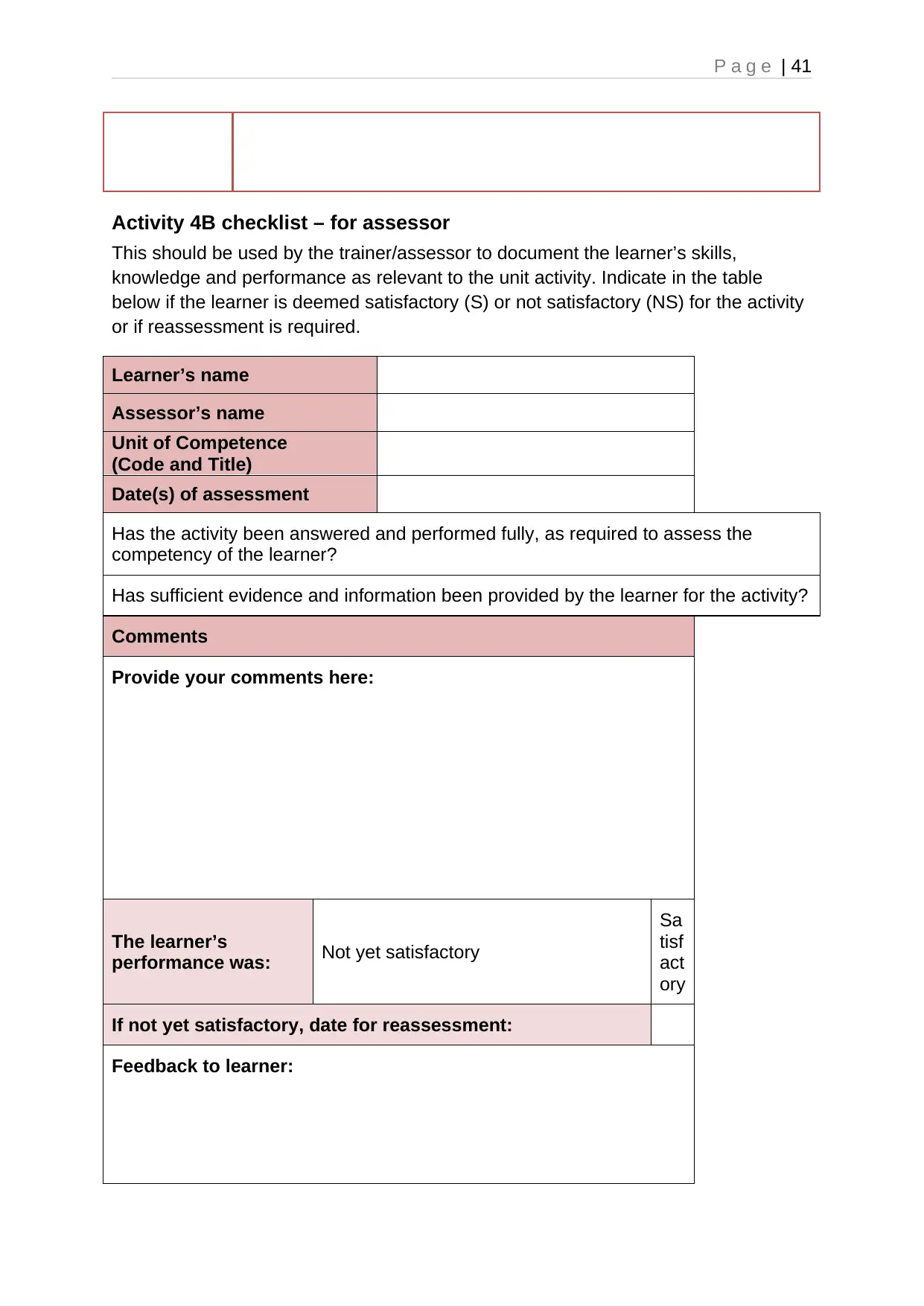
P a g e | 41
Activity 4B checklist – for assessor
This should be used by the trainer/assessor to document the learner’s skills,
knowledge and performance as relevant to the unit activity. Indicate in the table
below if the learner is deemed satisfactory (S) or not satisfactory (NS) for the activity
or if reassessment is required.
Learner’s name
Assessor’s name
Unit of Competence
(Code and Title)
Date(s) of assessment
Has the activity been answered and performed fully, as required to assess the
competency of the learner?
Has sufficient evidence and information been provided by the learner for the activity?
Comments
Provide your comments here:
The learner’s
performance was: Not yet satisfactory
Sa
tisf
act
ory
If not yet satisfactory, date for reassessment:
Feedback to learner:
Activity 4B checklist – for assessor
This should be used by the trainer/assessor to document the learner’s skills,
knowledge and performance as relevant to the unit activity. Indicate in the table
below if the learner is deemed satisfactory (S) or not satisfactory (NS) for the activity
or if reassessment is required.
Learner’s name
Assessor’s name
Unit of Competence
(Code and Title)
Date(s) of assessment
Has the activity been answered and performed fully, as required to assess the
competency of the learner?
Has sufficient evidence and information been provided by the learner for the activity?
Comments
Provide your comments here:
The learner’s
performance was: Not yet satisfactory
Sa
tisf
act
ory
If not yet satisfactory, date for reassessment:
Feedback to learner:
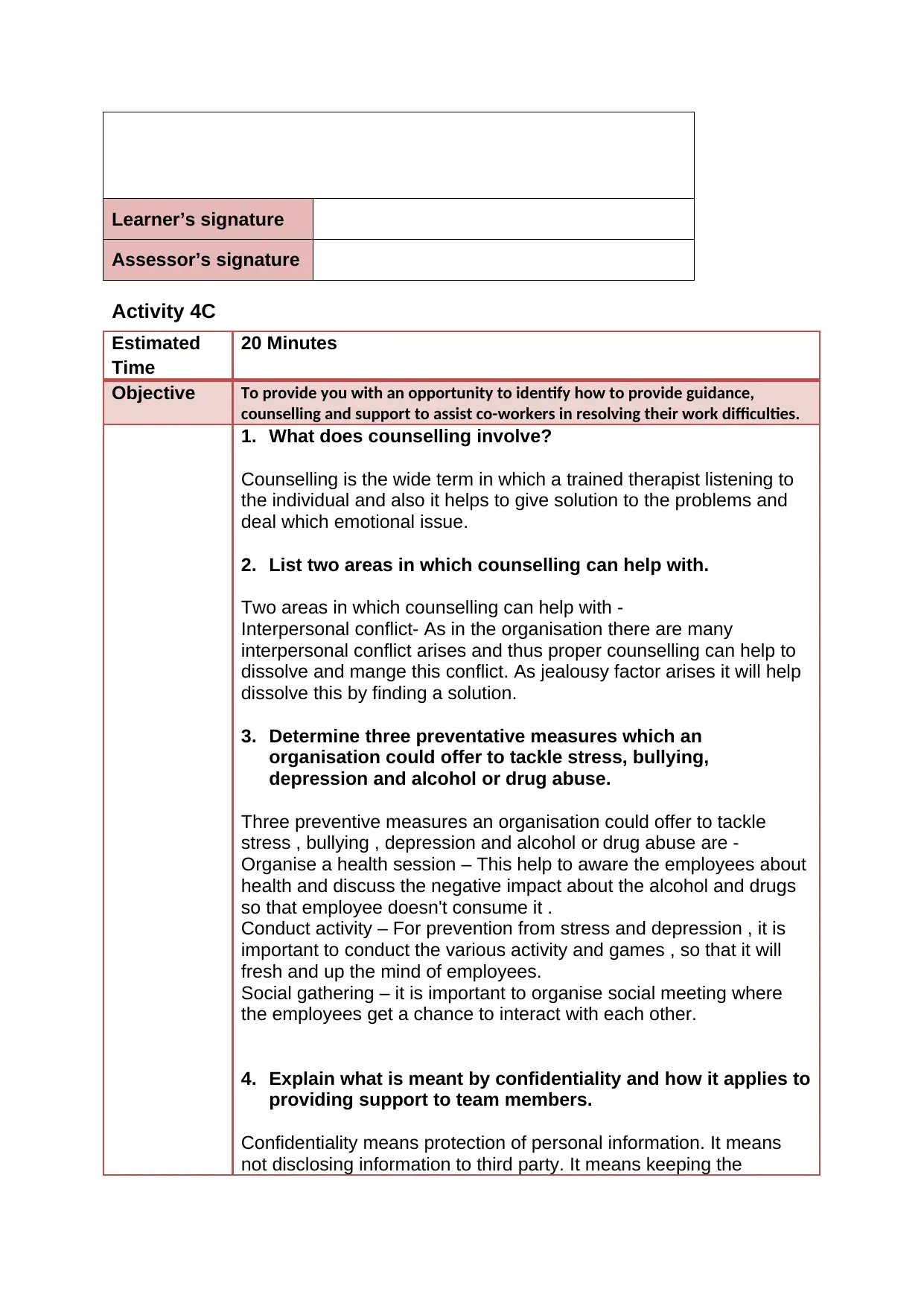
Learner’s signature
Assessor’s signature
Activity 4C
Estimated
Time
20 Minutes
Objective To provide you with an opportunity to identify how to provide guidance,
counselling and support to assist co-workers in resolving their work difficulties.
1. What does counselling involve?
Counselling is the wide term in which a trained therapist listening to
the individual and also it helps to give solution to the problems and
deal which emotional issue.
2. List two areas in which counselling can help with.
Two areas in which counselling can help with -
Interpersonal conflict- As in the organisation there are many
interpersonal conflict arises and thus proper counselling can help to
dissolve and mange this conflict. As jealousy factor arises it will help
dissolve this by finding a solution.
3. Determine three preventative measures which an
organisation could offer to tackle stress, bullying,
depression and alcohol or drug abuse.
Three preventive measures an organisation could offer to tackle
stress , bullying , depression and alcohol or drug abuse are -
Organise a health session – This help to aware the employees about
health and discuss the negative impact about the alcohol and drugs
so that employee doesn't consume it .
Conduct activity – For prevention from stress and depression , it is
important to conduct the various activity and games , so that it will
fresh and up the mind of employees.
Social gathering – it is important to organise social meeting where
the employees get a chance to interact with each other.
4. Explain what is meant by confidentiality and how it applies to
providing support to team members.
Confidentiality means protection of personal information. It means
not disclosing information to third party. It means keeping the
Assessor’s signature
Activity 4C
Estimated
Time
20 Minutes
Objective To provide you with an opportunity to identify how to provide guidance,
counselling and support to assist co-workers in resolving their work difficulties.
1. What does counselling involve?
Counselling is the wide term in which a trained therapist listening to
the individual and also it helps to give solution to the problems and
deal which emotional issue.
2. List two areas in which counselling can help with.
Two areas in which counselling can help with -
Interpersonal conflict- As in the organisation there are many
interpersonal conflict arises and thus proper counselling can help to
dissolve and mange this conflict. As jealousy factor arises it will help
dissolve this by finding a solution.
3. Determine three preventative measures which an
organisation could offer to tackle stress, bullying,
depression and alcohol or drug abuse.
Three preventive measures an organisation could offer to tackle
stress , bullying , depression and alcohol or drug abuse are -
Organise a health session – This help to aware the employees about
health and discuss the negative impact about the alcohol and drugs
so that employee doesn't consume it .
Conduct activity – For prevention from stress and depression , it is
important to conduct the various activity and games , so that it will
fresh and up the mind of employees.
Social gathering – it is important to organise social meeting where
the employees get a chance to interact with each other.
4. Explain what is meant by confidentiality and how it applies to
providing support to team members.
Confidentiality means protection of personal information. It means
not disclosing information to third party. It means keeping the
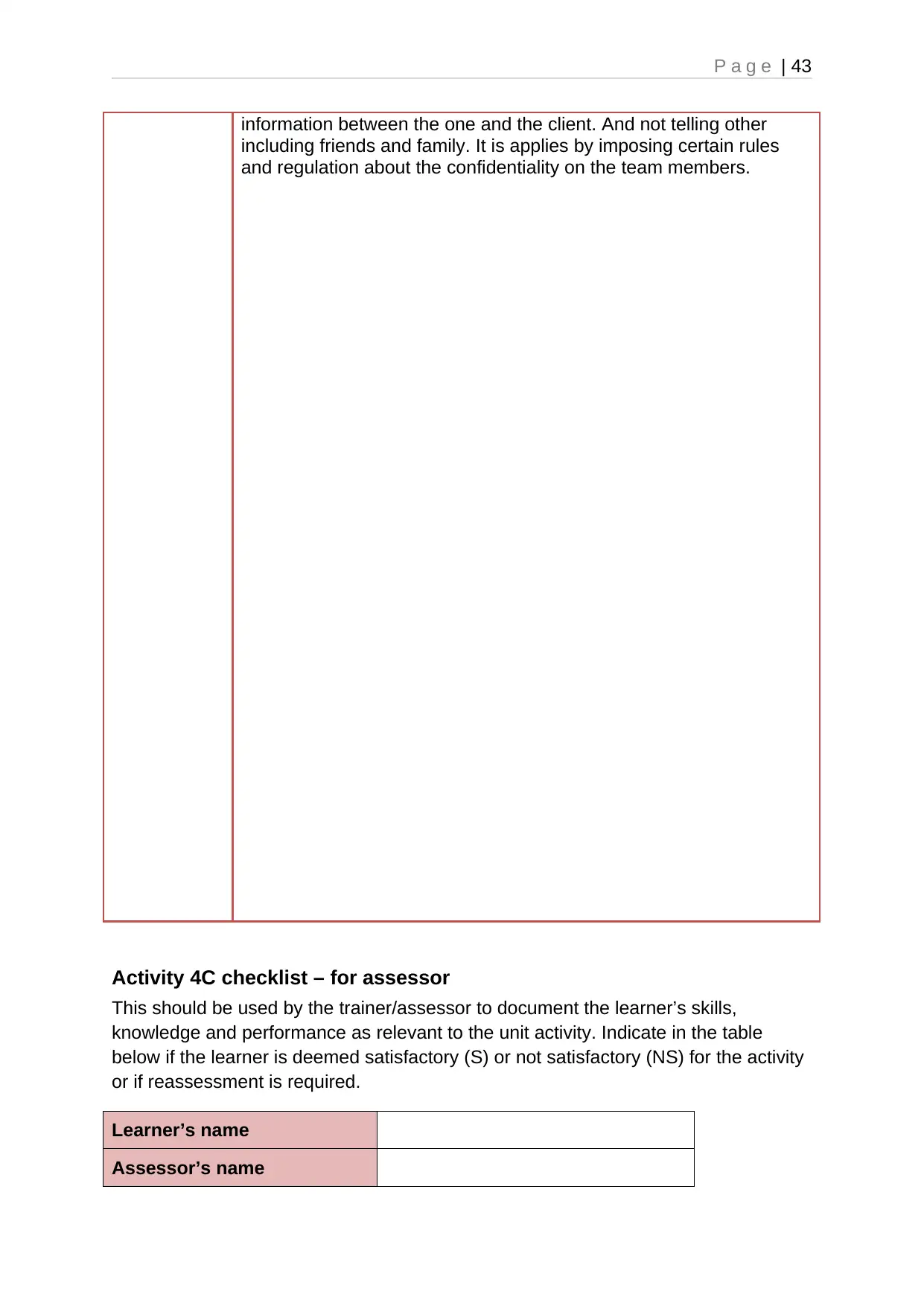
P a g e | 43
information between the one and the client. And not telling other
including friends and family. It is applies by imposing certain rules
and regulation about the confidentiality on the team members.
Activity 4C checklist – for assessor
This should be used by the trainer/assessor to document the learner’s skills,
knowledge and performance as relevant to the unit activity. Indicate in the table
below if the learner is deemed satisfactory (S) or not satisfactory (NS) for the activity
or if reassessment is required.
Learner’s name
Assessor’s name
information between the one and the client. And not telling other
including friends and family. It is applies by imposing certain rules
and regulation about the confidentiality on the team members.
Activity 4C checklist – for assessor
This should be used by the trainer/assessor to document the learner’s skills,
knowledge and performance as relevant to the unit activity. Indicate in the table
below if the learner is deemed satisfactory (S) or not satisfactory (NS) for the activity
or if reassessment is required.
Learner’s name
Assessor’s name
Paraphrase This Document
Need a fresh take? Get an instant paraphrase of this document with our AI Paraphraser
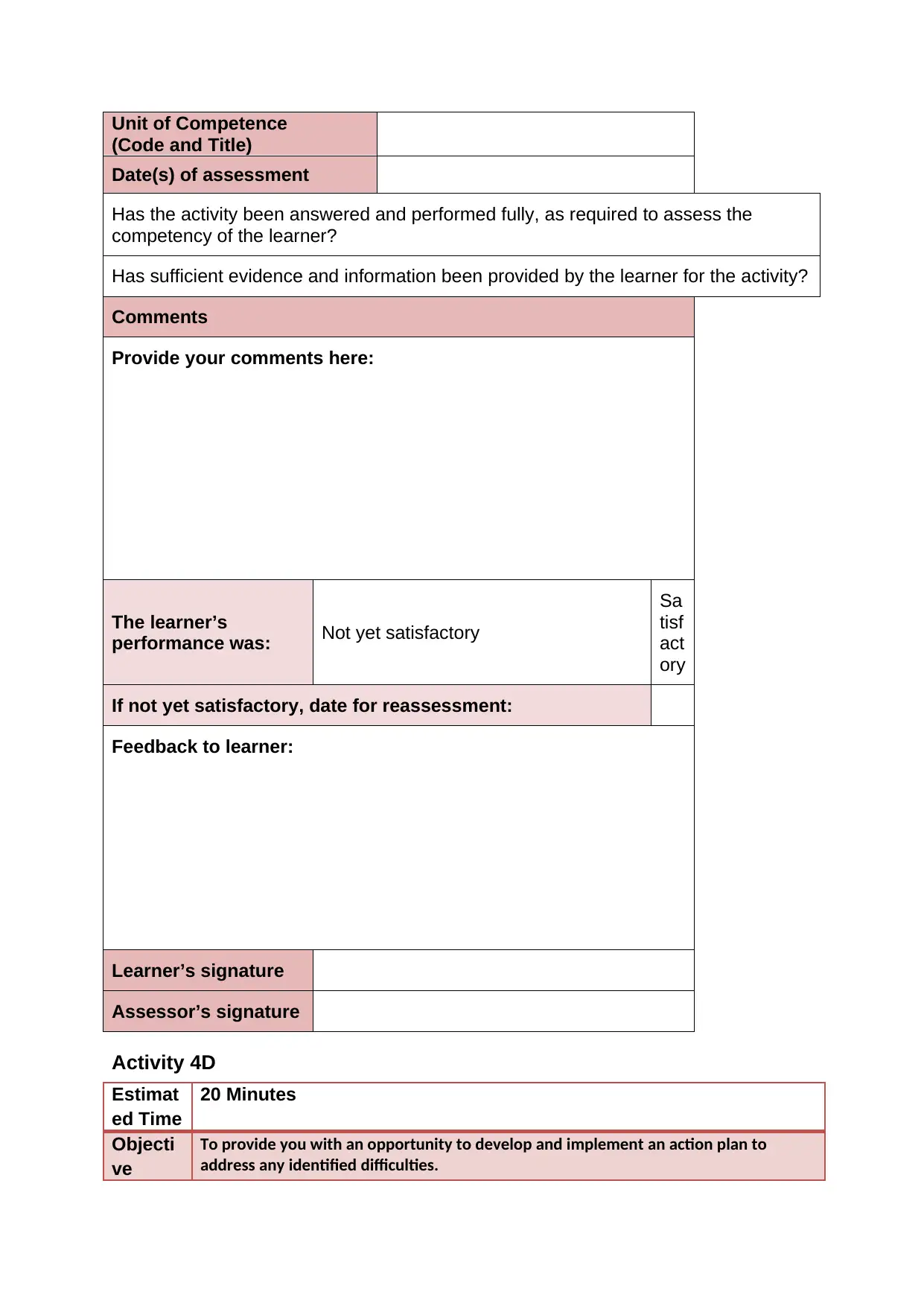
Unit of Competence
(Code and Title)
Date(s) of assessment
Has the activity been answered and performed fully, as required to assess the
competency of the learner?
Has sufficient evidence and information been provided by the learner for the activity?
Comments
Provide your comments here:
The learner’s
performance was: Not yet satisfactory
Sa
tisf
act
ory
If not yet satisfactory, date for reassessment:
Feedback to learner:
Learner’s signature
Assessor’s signature
Activity 4D
Estimat
ed Time
20 Minutes
Objecti
ve
To provide you with an opportunity to develop and implement an action plan to
address any identified difficulties.
(Code and Title)
Date(s) of assessment
Has the activity been answered and performed fully, as required to assess the
competency of the learner?
Has sufficient evidence and information been provided by the learner for the activity?
Comments
Provide your comments here:
The learner’s
performance was: Not yet satisfactory
Sa
tisf
act
ory
If not yet satisfactory, date for reassessment:
Feedback to learner:
Learner’s signature
Assessor’s signature
Activity 4D
Estimat
ed Time
20 Minutes
Objecti
ve
To provide you with an opportunity to develop and implement an action plan to
address any identified difficulties.
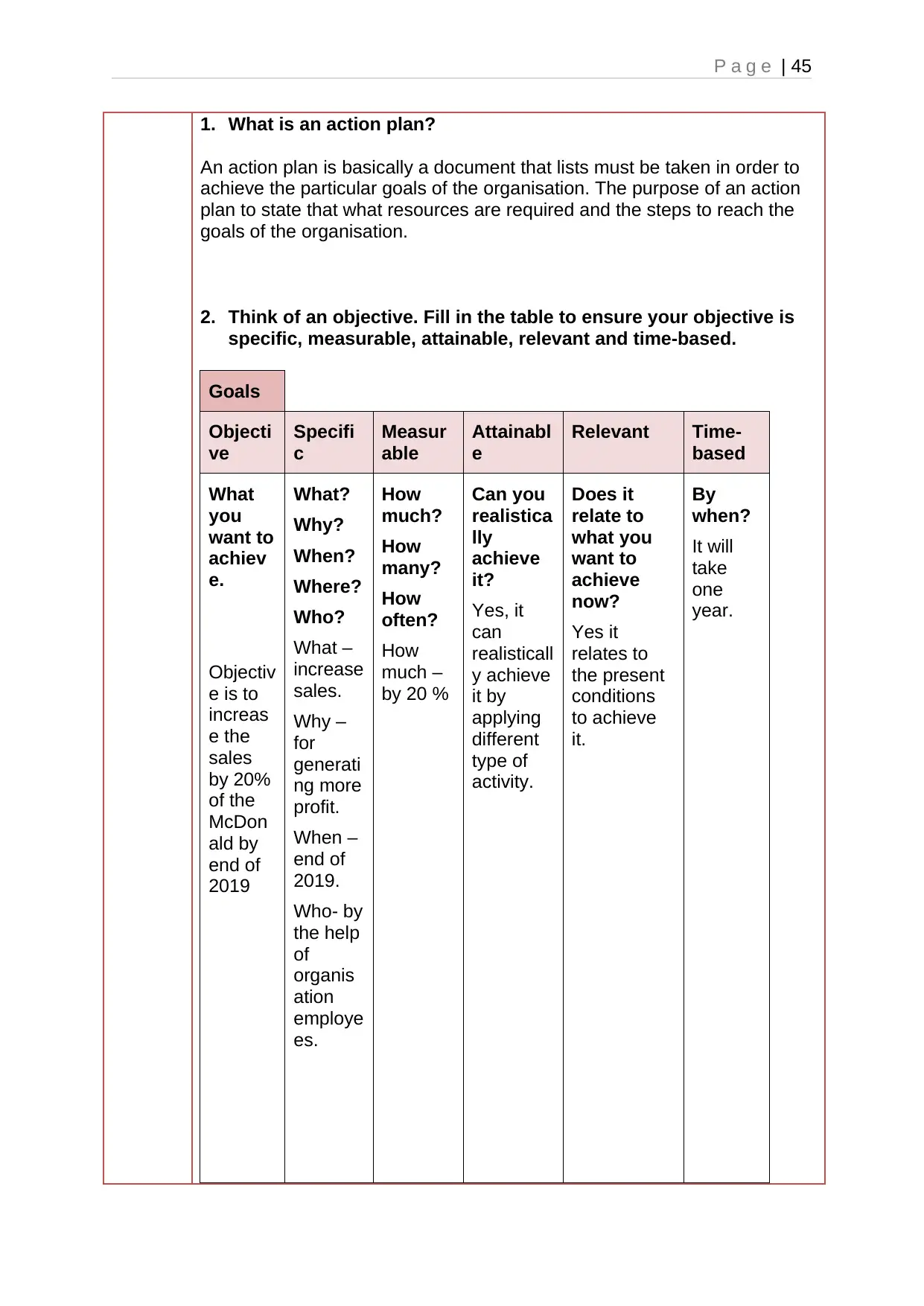
P a g e | 45
1. What is an action plan?
An action plan is basically a document that lists must be taken in order to
achieve the particular goals of the organisation. The purpose of an action
plan to state that what resources are required and the steps to reach the
goals of the organisation.
2. Think of an objective. Fill in the table to ensure your objective is
specific, measurable, attainable, relevant and time-based.
Goals
Objecti
ve
Specifi
c
Measur
able
Attainabl
e
Relevant Time-
based
What
you
want to
achiev
e.
Objectiv
e is to
increas
e the
sales
by 20%
of the
McDon
ald by
end of
2019
What?
Why?
When?
Where?
Who?
What –
increase
sales.
Why –
for
generati
ng more
profit.
When –
end of
2019.
Who- by
the help
of
organis
ation
employe
es.
How
much?
How
many?
How
often?
How
much –
by 20 %
Can you
realistica
lly
achieve
it?
Yes, it
can
realisticall
y achieve
it by
applying
different
type of
activity.
Does it
relate to
what you
want to
achieve
now?
Yes it
relates to
the present
conditions
to achieve
it.
By
when?
It will
take
one
year.
1. What is an action plan?
An action plan is basically a document that lists must be taken in order to
achieve the particular goals of the organisation. The purpose of an action
plan to state that what resources are required and the steps to reach the
goals of the organisation.
2. Think of an objective. Fill in the table to ensure your objective is
specific, measurable, attainable, relevant and time-based.
Goals
Objecti
ve
Specifi
c
Measur
able
Attainabl
e
Relevant Time-
based
What
you
want to
achiev
e.
Objectiv
e is to
increas
e the
sales
by 20%
of the
McDon
ald by
end of
2019
What?
Why?
When?
Where?
Who?
What –
increase
sales.
Why –
for
generati
ng more
profit.
When –
end of
2019.
Who- by
the help
of
organis
ation
employe
es.
How
much?
How
many?
How
often?
How
much –
by 20 %
Can you
realistica
lly
achieve
it?
Yes, it
can
realisticall
y achieve
it by
applying
different
type of
activity.
Does it
relate to
what you
want to
achieve
now?
Yes it
relates to
the present
conditions
to achieve
it.
By
when?
It will
take
one
year.
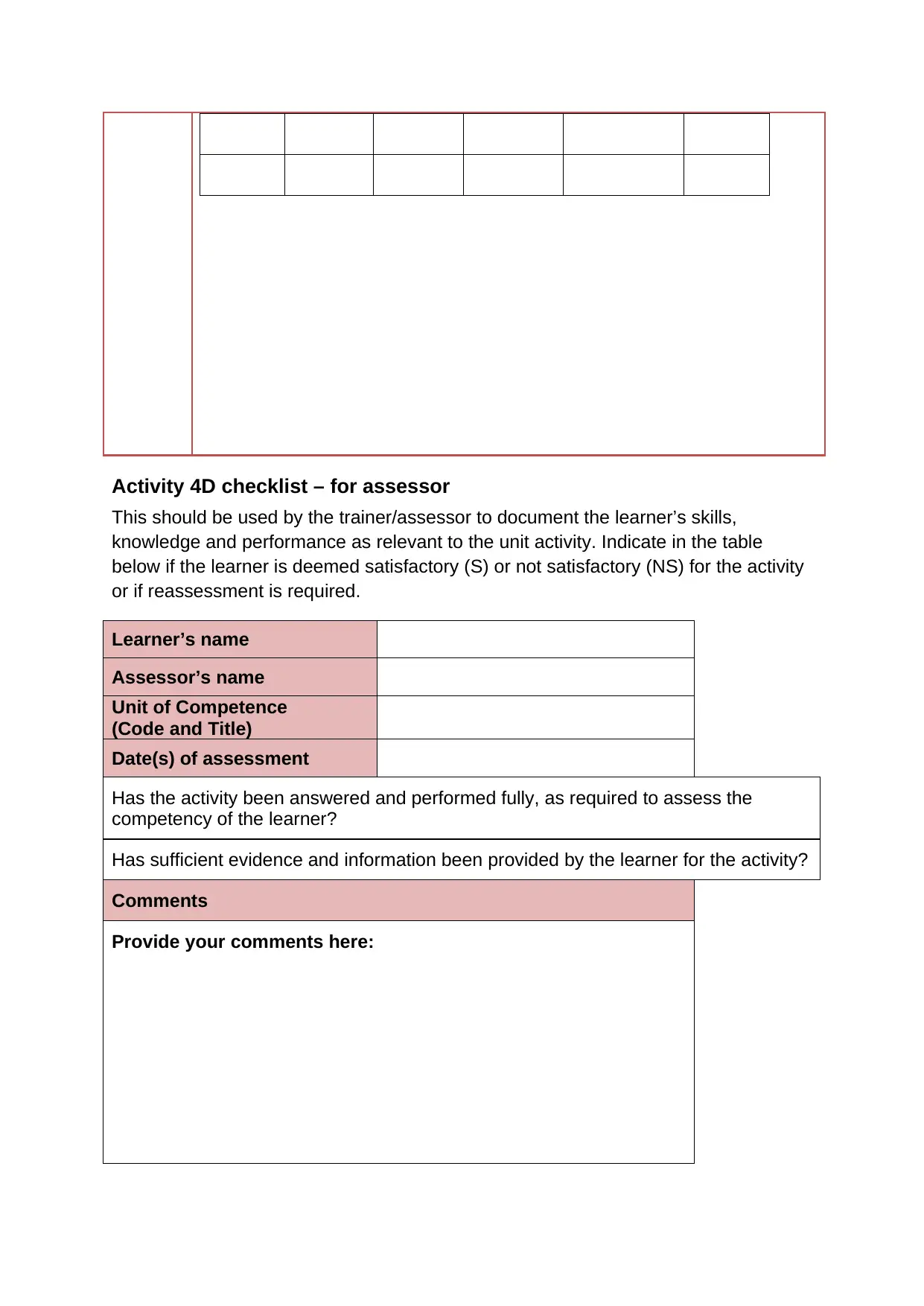
Activity 4D checklist – for assessor
This should be used by the trainer/assessor to document the learner’s skills,
knowledge and performance as relevant to the unit activity. Indicate in the table
below if the learner is deemed satisfactory (S) or not satisfactory (NS) for the activity
or if reassessment is required.
Learner’s name
Assessor’s name
Unit of Competence
(Code and Title)
Date(s) of assessment
Has the activity been answered and performed fully, as required to assess the
competency of the learner?
Has sufficient evidence and information been provided by the learner for the activity?
Comments
Provide your comments here:
This should be used by the trainer/assessor to document the learner’s skills,
knowledge and performance as relevant to the unit activity. Indicate in the table
below if the learner is deemed satisfactory (S) or not satisfactory (NS) for the activity
or if reassessment is required.
Learner’s name
Assessor’s name
Unit of Competence
(Code and Title)
Date(s) of assessment
Has the activity been answered and performed fully, as required to assess the
competency of the learner?
Has sufficient evidence and information been provided by the learner for the activity?
Comments
Provide your comments here:
Secure Best Marks with AI Grader
Need help grading? Try our AI Grader for instant feedback on your assignments.
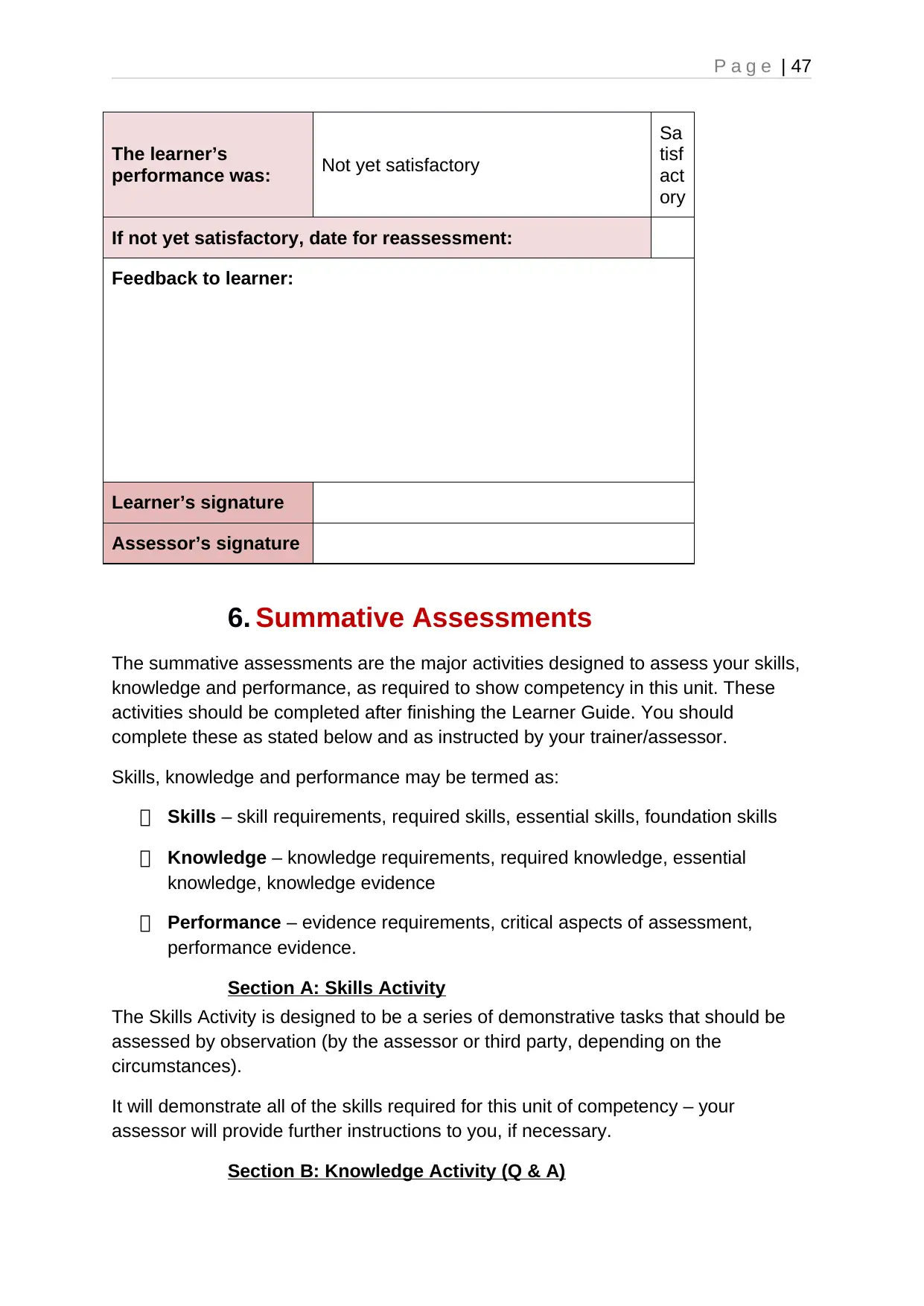
P a g e | 47
The learner’s
performance was: Not yet satisfactory
Sa
tisf
act
ory
If not yet satisfactory, date for reassessment:
Feedback to learner:
Learner’s signature
Assessor’s signature
6. Summative Assessments
The summative assessments are the major activities designed to assess your skills,
knowledge and performance, as required to show competency in this unit. These
activities should be completed after finishing the Learner Guide. You should
complete these as stated below and as instructed by your trainer/assessor.
Skills, knowledge and performance may be termed as:
Skills – skill requirements, required skills, essential skills, foundation skills
Knowledge – knowledge requirements, required knowledge, essential
knowledge, knowledge evidence
Performance – evidence requirements, critical aspects of assessment,
performance evidence.
Section A: Skills Activity
The Skills Activity is designed to be a series of demonstrative tasks that should be
assessed by observation (by the assessor or third party, depending on the
circumstances).
It will demonstrate all of the skills required for this unit of competency – your
assessor will provide further instructions to you, if necessary.
Section B: Knowledge Activity (Q & A)
The learner’s
performance was: Not yet satisfactory
Sa
tisf
act
ory
If not yet satisfactory, date for reassessment:
Feedback to learner:
Learner’s signature
Assessor’s signature
6. Summative Assessments
The summative assessments are the major activities designed to assess your skills,
knowledge and performance, as required to show competency in this unit. These
activities should be completed after finishing the Learner Guide. You should
complete these as stated below and as instructed by your trainer/assessor.
Skills, knowledge and performance may be termed as:
Skills – skill requirements, required skills, essential skills, foundation skills
Knowledge – knowledge requirements, required knowledge, essential
knowledge, knowledge evidence
Performance – evidence requirements, critical aspects of assessment,
performance evidence.
Section A: Skills Activity
The Skills Activity is designed to be a series of demonstrative tasks that should be
assessed by observation (by the assessor or third party, depending on the
circumstances).
It will demonstrate all of the skills required for this unit of competency – your
assessor will provide further instructions to you, if necessary.
Section B: Knowledge Activity (Q & A)
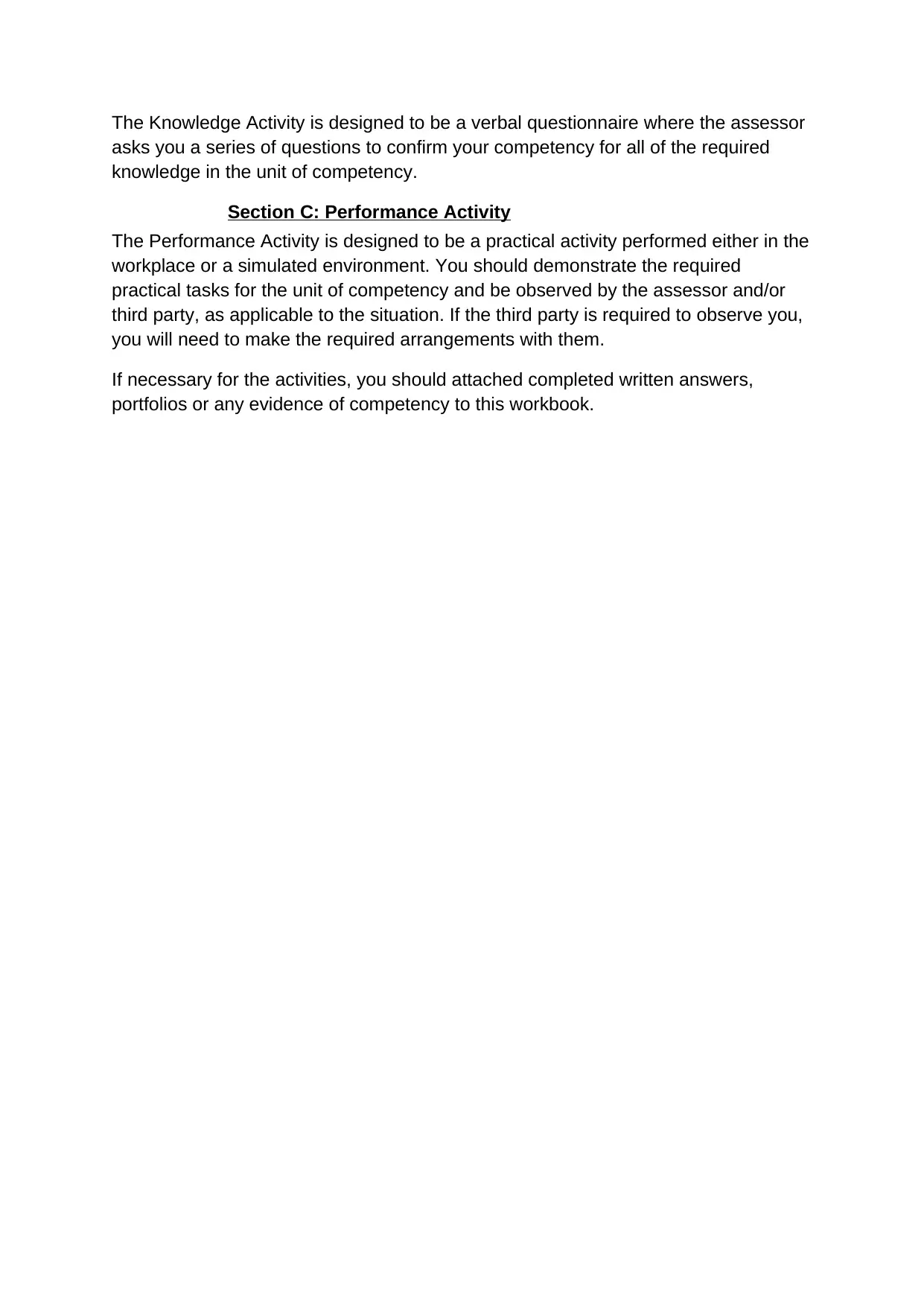
The Knowledge Activity is designed to be a verbal questionnaire where the assessor
asks you a series of questions to confirm your competency for all of the required
knowledge in the unit of competency.
Section C: Performance Activity
The Performance Activity is designed to be a practical activity performed either in the
workplace or a simulated environment. You should demonstrate the required
practical tasks for the unit of competency and be observed by the assessor and/or
third party, as applicable to the situation. If the third party is required to observe you,
you will need to make the required arrangements with them.
If necessary for the activities, you should attached completed written answers,
portfolios or any evidence of competency to this workbook.
asks you a series of questions to confirm your competency for all of the required
knowledge in the unit of competency.
Section C: Performance Activity
The Performance Activity is designed to be a practical activity performed either in the
workplace or a simulated environment. You should demonstrate the required
practical tasks for the unit of competency and be observed by the assessor and/or
third party, as applicable to the situation. If the third party is required to observe you,
you will need to make the required arrangements with them.
If necessary for the activities, you should attached completed written answers,
portfolios or any evidence of competency to this workbook.
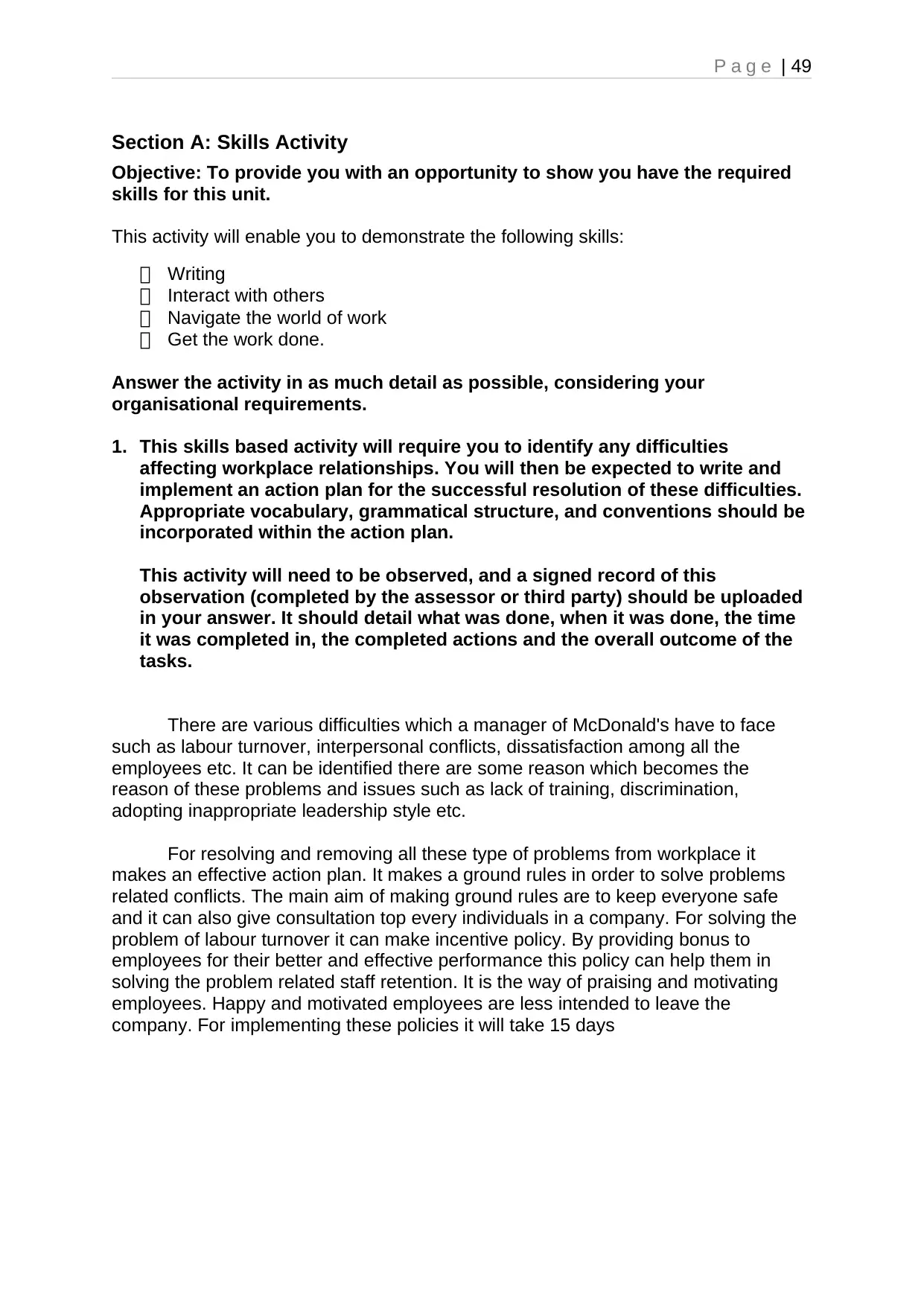
P a g e | 49
Section A: Skills Activity
Objective: To provide you with an opportunity to show you have the required
skills for this unit.
This activity will enable you to demonstrate the following skills:
Writing
Interact with others
Navigate the world of work
Get the work done.
Answer the activity in as much detail as possible, considering your
organisational requirements.
1. This skills based activity will require you to identify any difficulties
affecting workplace relationships. You will then be expected to write and
implement an action plan for the successful resolution of these difficulties.
Appropriate vocabulary, grammatical structure, and conventions should be
incorporated within the action plan.
This activity will need to be observed, and a signed record of this
observation (completed by the assessor or third party) should be uploaded
in your answer. It should detail what was done, when it was done, the time
it was completed in, the completed actions and the overall outcome of the
tasks.
There are various difficulties which a manager of McDonald's have to face
such as labour turnover, interpersonal conflicts, dissatisfaction among all the
employees etc. It can be identified there are some reason which becomes the
reason of these problems and issues such as lack of training, discrimination,
adopting inappropriate leadership style etc.
For resolving and removing all these type of problems from workplace it
makes an effective action plan. It makes a ground rules in order to solve problems
related conflicts. The main aim of making ground rules are to keep everyone safe
and it can also give consultation top every individuals in a company. For solving the
problem of labour turnover it can make incentive policy. By providing bonus to
employees for their better and effective performance this policy can help them in
solving the problem related staff retention. It is the way of praising and motivating
employees. Happy and motivated employees are less intended to leave the
company. For implementing these policies it will take 15 days
Section A: Skills Activity
Objective: To provide you with an opportunity to show you have the required
skills for this unit.
This activity will enable you to demonstrate the following skills:
Writing
Interact with others
Navigate the world of work
Get the work done.
Answer the activity in as much detail as possible, considering your
organisational requirements.
1. This skills based activity will require you to identify any difficulties
affecting workplace relationships. You will then be expected to write and
implement an action plan for the successful resolution of these difficulties.
Appropriate vocabulary, grammatical structure, and conventions should be
incorporated within the action plan.
This activity will need to be observed, and a signed record of this
observation (completed by the assessor or third party) should be uploaded
in your answer. It should detail what was done, when it was done, the time
it was completed in, the completed actions and the overall outcome of the
tasks.
There are various difficulties which a manager of McDonald's have to face
such as labour turnover, interpersonal conflicts, dissatisfaction among all the
employees etc. It can be identified there are some reason which becomes the
reason of these problems and issues such as lack of training, discrimination,
adopting inappropriate leadership style etc.
For resolving and removing all these type of problems from workplace it
makes an effective action plan. It makes a ground rules in order to solve problems
related conflicts. The main aim of making ground rules are to keep everyone safe
and it can also give consultation top every individuals in a company. For solving the
problem of labour turnover it can make incentive policy. By providing bonus to
employees for their better and effective performance this policy can help them in
solving the problem related staff retention. It is the way of praising and motivating
employees. Happy and motivated employees are less intended to leave the
company. For implementing these policies it will take 15 days
Paraphrase This Document
Need a fresh take? Get an instant paraphrase of this document with our AI Paraphraser
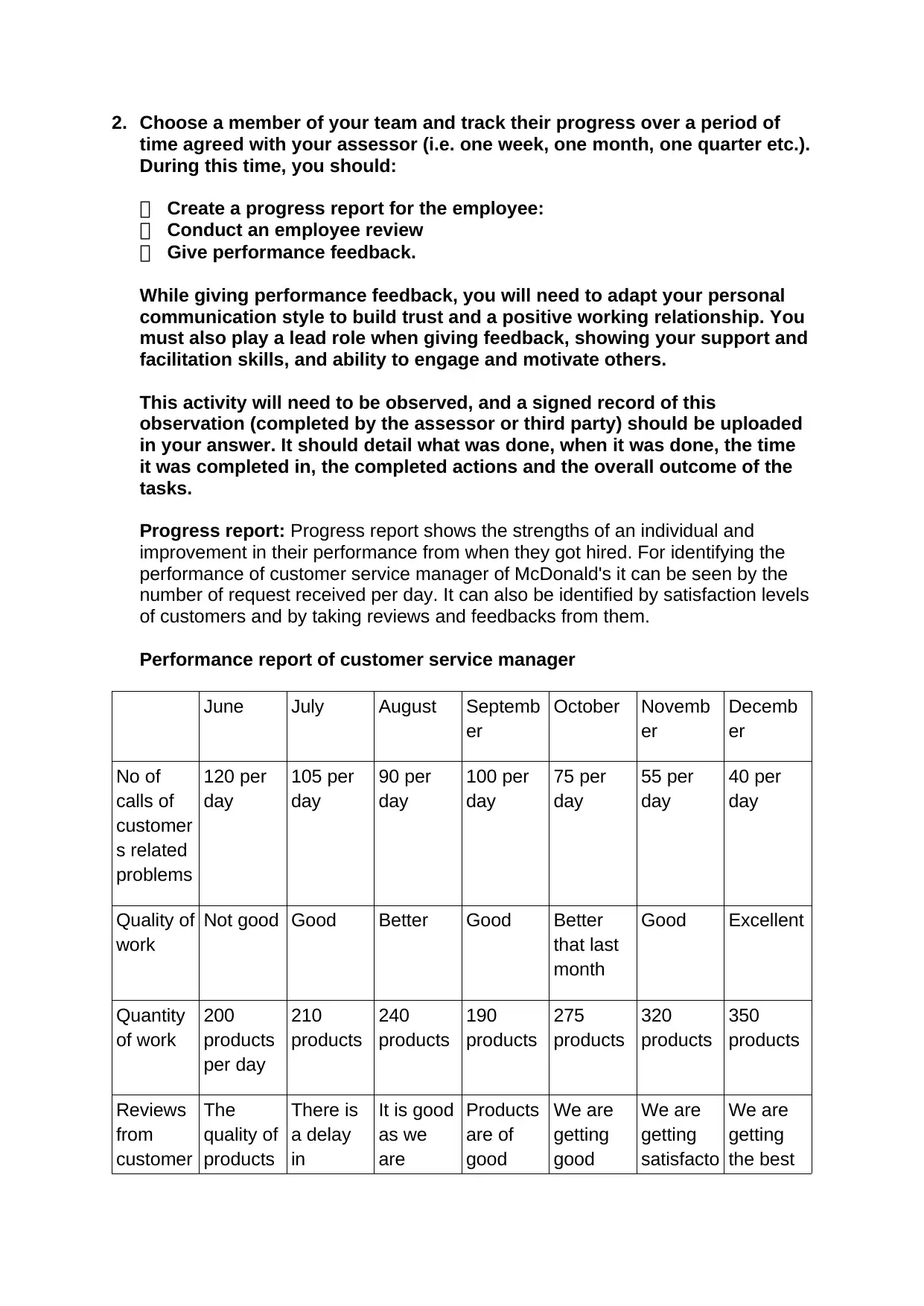
2. Choose a member of your team and track their progress over a period of
time agreed with your assessor (i.e. one week, one month, one quarter etc.).
During this time, you should:
Create a progress report for the employee:
Conduct an employee review
Give performance feedback.
While giving performance feedback, you will need to adapt your personal
communication style to build trust and a positive working relationship. You
must also play a lead role when giving feedback, showing your support and
facilitation skills, and ability to engage and motivate others.
This activity will need to be observed, and a signed record of this
observation (completed by the assessor or third party) should be uploaded
in your answer. It should detail what was done, when it was done, the time
it was completed in, the completed actions and the overall outcome of the
tasks.
Progress report: Progress report shows the strengths of an individual and
improvement in their performance from when they got hired. For identifying the
performance of customer service manager of McDonald's it can be seen by the
number of request received per day. It can also be identified by satisfaction levels
of customers and by taking reviews and feedbacks from them.
Performance report of customer service manager
June July August Septemb
er
October Novemb
er
Decemb
er
No of
calls of
customer
s related
problems
120 per
day
105 per
day
90 per
day
100 per
day
75 per
day
55 per
day
40 per
day
Quality of
work
Not good Good Better Good Better
that last
month
Good Excellent
Quantity
of work
200
products
per day
210
products
240
products
190
products
275
products
320
products
350
products
Reviews
from
customer
The
quality of
products
There is
a delay
in
It is good
as we
are
Products
are of
good
We are
getting
good
We are
getting
satisfacto
We are
getting
the best
time agreed with your assessor (i.e. one week, one month, one quarter etc.).
During this time, you should:
Create a progress report for the employee:
Conduct an employee review
Give performance feedback.
While giving performance feedback, you will need to adapt your personal
communication style to build trust and a positive working relationship. You
must also play a lead role when giving feedback, showing your support and
facilitation skills, and ability to engage and motivate others.
This activity will need to be observed, and a signed record of this
observation (completed by the assessor or third party) should be uploaded
in your answer. It should detail what was done, when it was done, the time
it was completed in, the completed actions and the overall outcome of the
tasks.
Progress report: Progress report shows the strengths of an individual and
improvement in their performance from when they got hired. For identifying the
performance of customer service manager of McDonald's it can be seen by the
number of request received per day. It can also be identified by satisfaction levels
of customers and by taking reviews and feedbacks from them.
Performance report of customer service manager
June July August Septemb
er
October Novemb
er
Decemb
er
No of
calls of
customer
s related
problems
120 per
day
105 per
day
90 per
day
100 per
day
75 per
day
55 per
day
40 per
day
Quality of
work
Not good Good Better Good Better
that last
month
Good Excellent
Quantity
of work
200
products
per day
210
products
240
products
190
products
275
products
320
products
350
products
Reviews
from
customer
The
quality of
products
There is
a delay
in
It is good
as we
are
Products
are of
good
We are
getting
good
We are
getting
satisfacto
We are
getting
the best
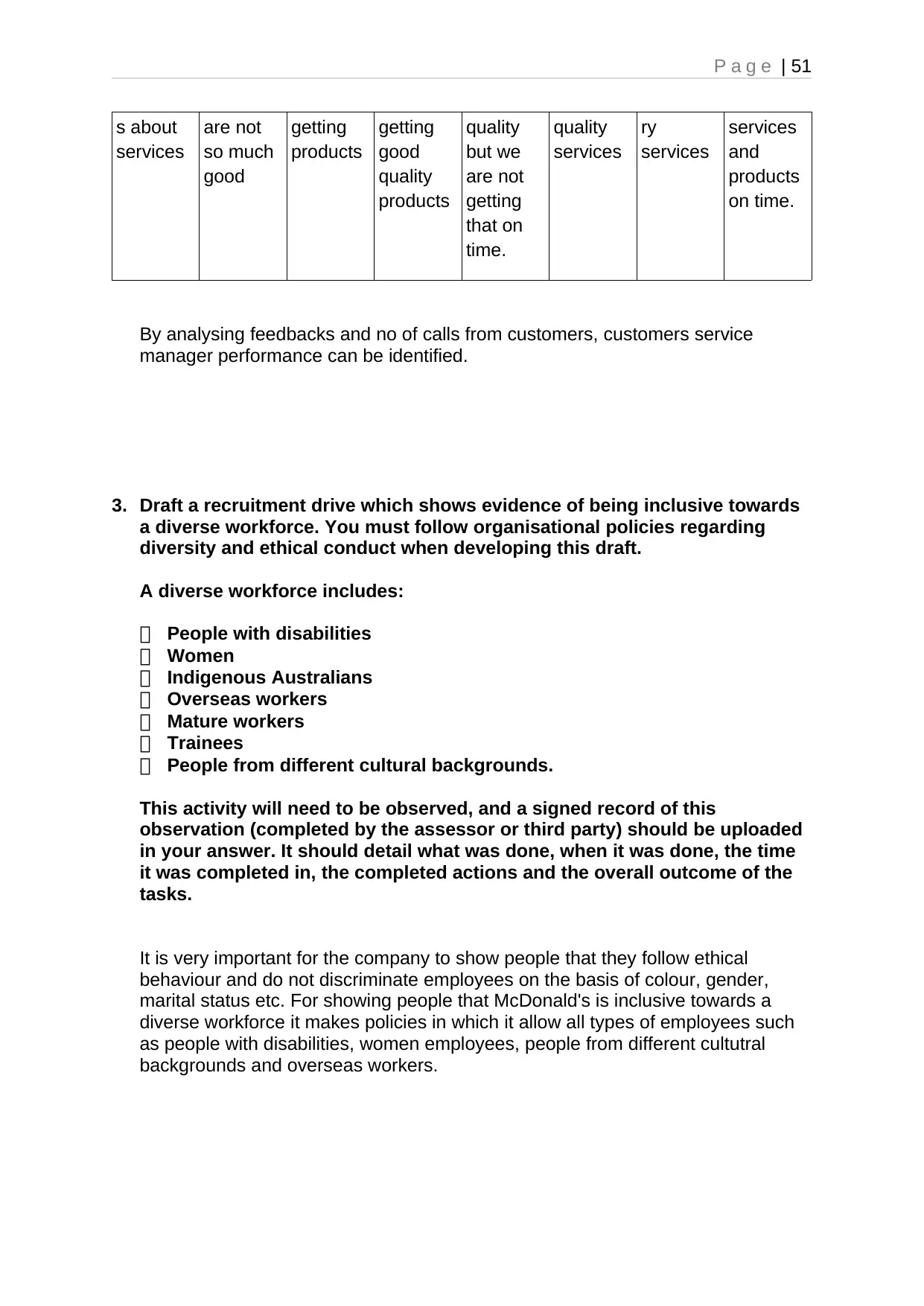
P a g e | 51
s about
services
are not
so much
good
getting
products
getting
good
quality
products
quality
but we
are not
getting
that on
time.
quality
services
ry
services
services
and
products
on time.
By analysing feedbacks and no of calls from customers, customers service
manager performance can be identified.
3. Draft a recruitment drive which shows evidence of being inclusive towards
a diverse workforce. You must follow organisational policies regarding
diversity and ethical conduct when developing this draft.
A diverse workforce includes:
People with disabilities
Women
Indigenous Australians
Overseas workers
Mature workers
Trainees
People from different cultural backgrounds.
This activity will need to be observed, and a signed record of this
observation (completed by the assessor or third party) should be uploaded
in your answer. It should detail what was done, when it was done, the time
it was completed in, the completed actions and the overall outcome of the
tasks.
It is very important for the company to show people that they follow ethical
behaviour and do not discriminate employees on the basis of colour, gender,
marital status etc. For showing people that McDonald's is inclusive towards a
diverse workforce it makes policies in which it allow all types of employees such
as people with disabilities, women employees, people from different cultutral
backgrounds and overseas workers.
s about
services
are not
so much
good
getting
products
getting
good
quality
products
quality
but we
are not
getting
that on
time.
quality
services
ry
services
services
and
products
on time.
By analysing feedbacks and no of calls from customers, customers service
manager performance can be identified.
3. Draft a recruitment drive which shows evidence of being inclusive towards
a diverse workforce. You must follow organisational policies regarding
diversity and ethical conduct when developing this draft.
A diverse workforce includes:
People with disabilities
Women
Indigenous Australians
Overseas workers
Mature workers
Trainees
People from different cultural backgrounds.
This activity will need to be observed, and a signed record of this
observation (completed by the assessor or third party) should be uploaded
in your answer. It should detail what was done, when it was done, the time
it was completed in, the completed actions and the overall outcome of the
tasks.
It is very important for the company to show people that they follow ethical
behaviour and do not discriminate employees on the basis of colour, gender,
marital status etc. For showing people that McDonald's is inclusive towards a
diverse workforce it makes policies in which it allow all types of employees such
as people with disabilities, women employees, people from different cultutral
backgrounds and overseas workers.
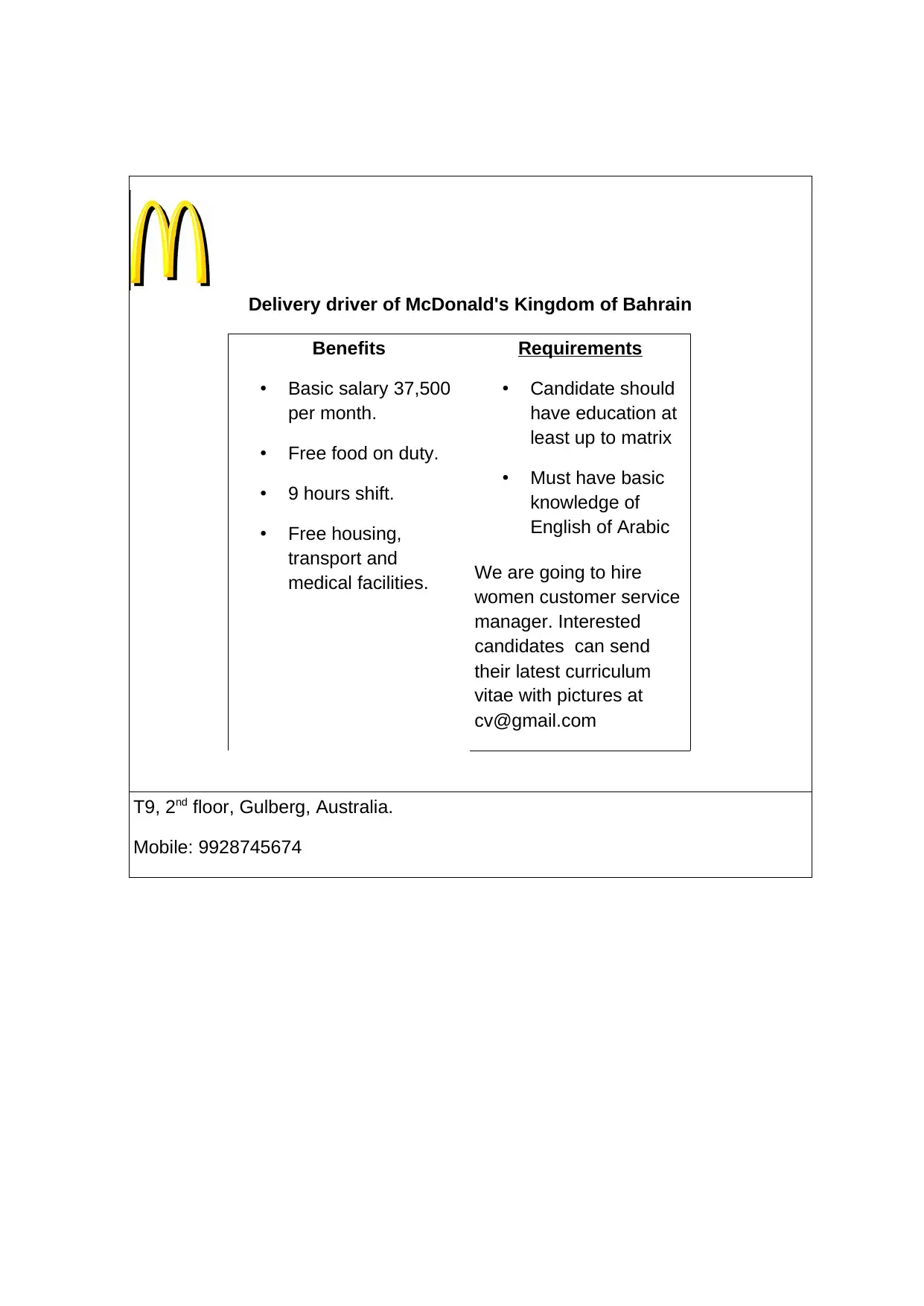
Delivery driver of McDonald's Kingdom of Bahrain
Benefits
• Basic salary 37,500
per month.
• Free food on duty.
• 9 hours shift.
• Free housing,
transport and
medical facilities.
Requirements
• Candidate should
have education at
least up to matrix
• Must have basic
knowledge of
English of Arabic
We are going to hire
women customer service
manager. Interested
candidates can send
their latest curriculum
vitae with pictures at
cv@gmail.com
T9, 2nd floor, Gulberg, Australia.
Mobile: 9928745674
Benefits
• Basic salary 37,500
per month.
• Free food on duty.
• 9 hours shift.
• Free housing,
transport and
medical facilities.
Requirements
• Candidate should
have education at
least up to matrix
• Must have basic
knowledge of
English of Arabic
We are going to hire
women customer service
manager. Interested
candidates can send
their latest curriculum
vitae with pictures at
cv@gmail.com
T9, 2nd floor, Gulberg, Australia.
Mobile: 9928745674
Secure Best Marks with AI Grader
Need help grading? Try our AI Grader for instant feedback on your assignments.
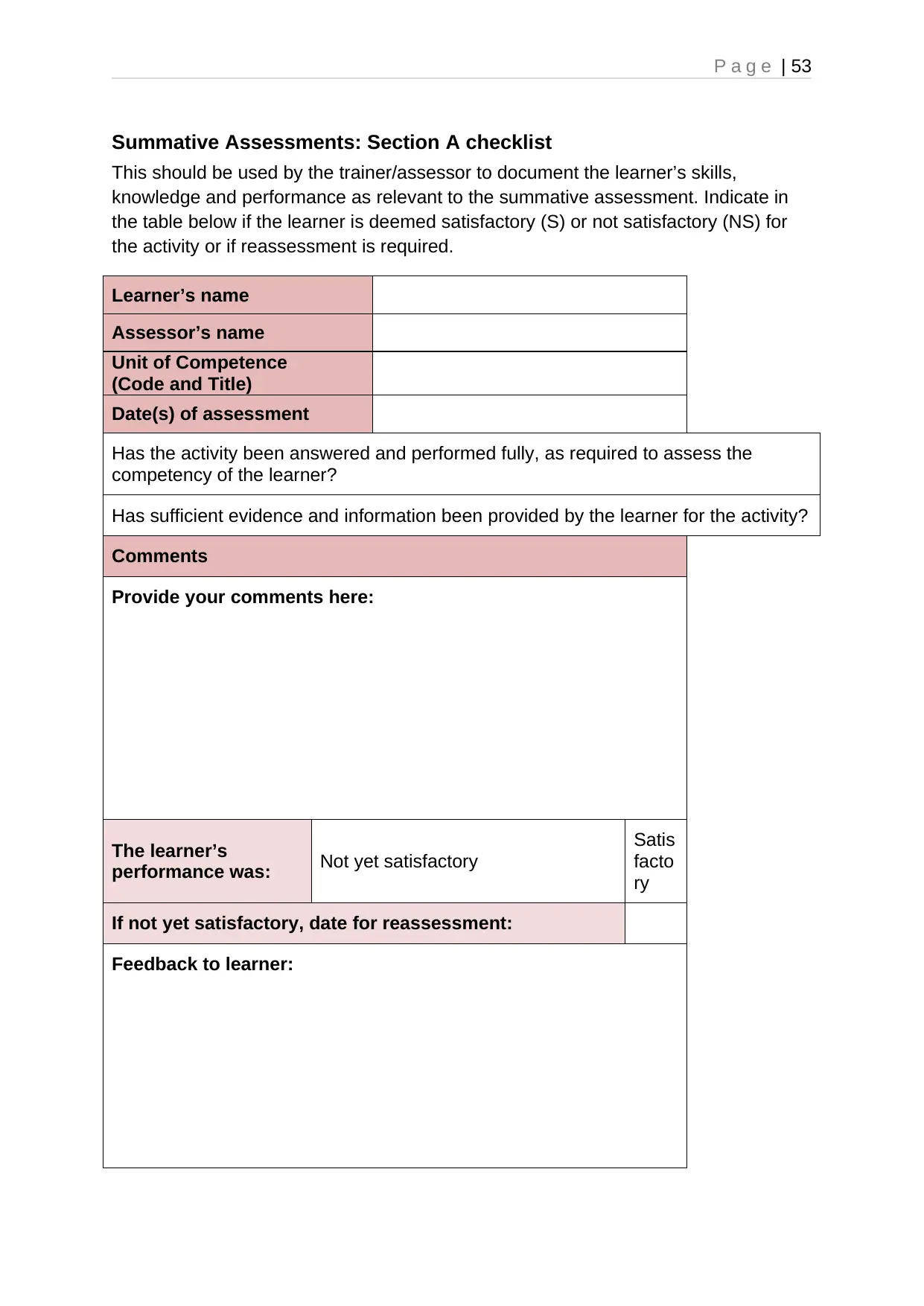
P a g e | 53
Summative Assessments: Section A checklist
This should be used by the trainer/assessor to document the learner’s skills,
knowledge and performance as relevant to the summative assessment. Indicate in
the table below if the learner is deemed satisfactory (S) or not satisfactory (NS) for
the activity or if reassessment is required.
Learner’s name
Assessor’s name
Unit of Competence
(Code and Title)
Date(s) of assessment
Has the activity been answered and performed fully, as required to assess the
competency of the learner?
Has sufficient evidence and information been provided by the learner for the activity?
Comments
Provide your comments here:
The learner’s
performance was: Not yet satisfactory
Satis
facto
ry
If not yet satisfactory, date for reassessment:
Feedback to learner:
Summative Assessments: Section A checklist
This should be used by the trainer/assessor to document the learner’s skills,
knowledge and performance as relevant to the summative assessment. Indicate in
the table below if the learner is deemed satisfactory (S) or not satisfactory (NS) for
the activity or if reassessment is required.
Learner’s name
Assessor’s name
Unit of Competence
(Code and Title)
Date(s) of assessment
Has the activity been answered and performed fully, as required to assess the
competency of the learner?
Has sufficient evidence and information been provided by the learner for the activity?
Comments
Provide your comments here:
The learner’s
performance was: Not yet satisfactory
Satis
facto
ry
If not yet satisfactory, date for reassessment:
Feedback to learner:
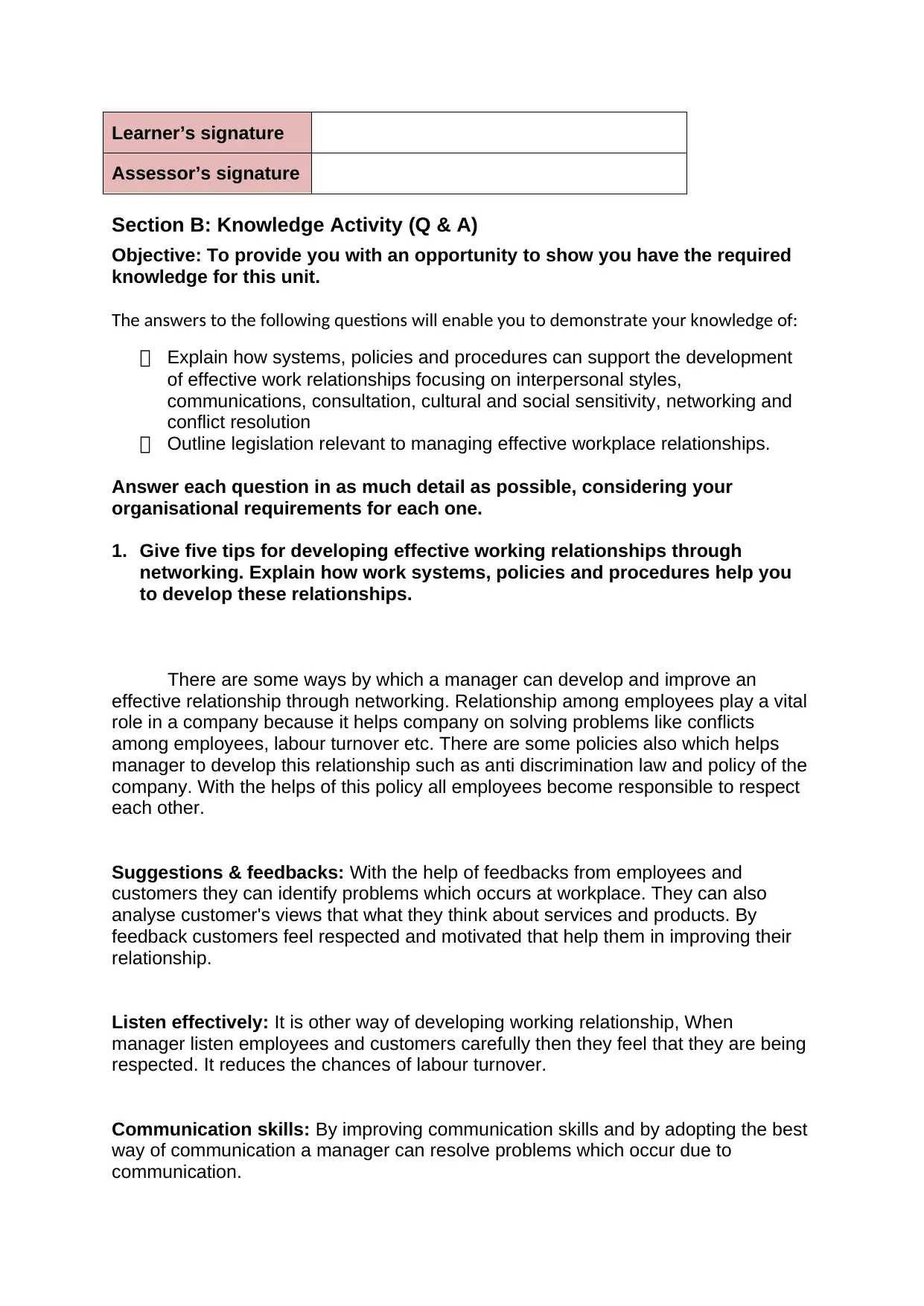
Learner’s signature
Assessor’s signature
Section B: Knowledge Activity (Q & A)
Objective: To provide you with an opportunity to show you have the required
knowledge for this unit.
The answers to the following questions will enable you to demonstrate your knowledge of:
Explain how systems, policies and procedures can support the development
of effective work relationships focusing on interpersonal styles,
communications, consultation, cultural and social sensitivity, networking and
conflict resolution
Outline legislation relevant to managing effective workplace relationships.
Answer each question in as much detail as possible, considering your
organisational requirements for each one.
1. Give five tips for developing effective working relationships through
networking. Explain how work systems, policies and procedures help you
to develop these relationships.
There are some ways by which a manager can develop and improve an
effective relationship through networking. Relationship among employees play a vital
role in a company because it helps company on solving problems like conflicts
among employees, labour turnover etc. There are some policies also which helps
manager to develop this relationship such as anti discrimination law and policy of the
company. With the helps of this policy all employees become responsible to respect
each other.
Suggestions & feedbacks: With the help of feedbacks from employees and
customers they can identify problems which occurs at workplace. They can also
analyse customer's views that what they think about services and products. By
feedback customers feel respected and motivated that help them in improving their
relationship.
Listen effectively: It is other way of developing working relationship, When
manager listen employees and customers carefully then they feel that they are being
respected. It reduces the chances of labour turnover.
Communication skills: By improving communication skills and by adopting the best
way of communication a manager can resolve problems which occur due to
communication.
Assessor’s signature
Section B: Knowledge Activity (Q & A)
Objective: To provide you with an opportunity to show you have the required
knowledge for this unit.
The answers to the following questions will enable you to demonstrate your knowledge of:
Explain how systems, policies and procedures can support the development
of effective work relationships focusing on interpersonal styles,
communications, consultation, cultural and social sensitivity, networking and
conflict resolution
Outline legislation relevant to managing effective workplace relationships.
Answer each question in as much detail as possible, considering your
organisational requirements for each one.
1. Give five tips for developing effective working relationships through
networking. Explain how work systems, policies and procedures help you
to develop these relationships.
There are some ways by which a manager can develop and improve an
effective relationship through networking. Relationship among employees play a vital
role in a company because it helps company on solving problems like conflicts
among employees, labour turnover etc. There are some policies also which helps
manager to develop this relationship such as anti discrimination law and policy of the
company. With the helps of this policy all employees become responsible to respect
each other.
Suggestions & feedbacks: With the help of feedbacks from employees and
customers they can identify problems which occurs at workplace. They can also
analyse customer's views that what they think about services and products. By
feedback customers feel respected and motivated that help them in improving their
relationship.
Listen effectively: It is other way of developing working relationship, When
manager listen employees and customers carefully then they feel that they are being
respected. It reduces the chances of labour turnover.
Communication skills: By improving communication skills and by adopting the best
way of communication a manager can resolve problems which occur due to
communication.
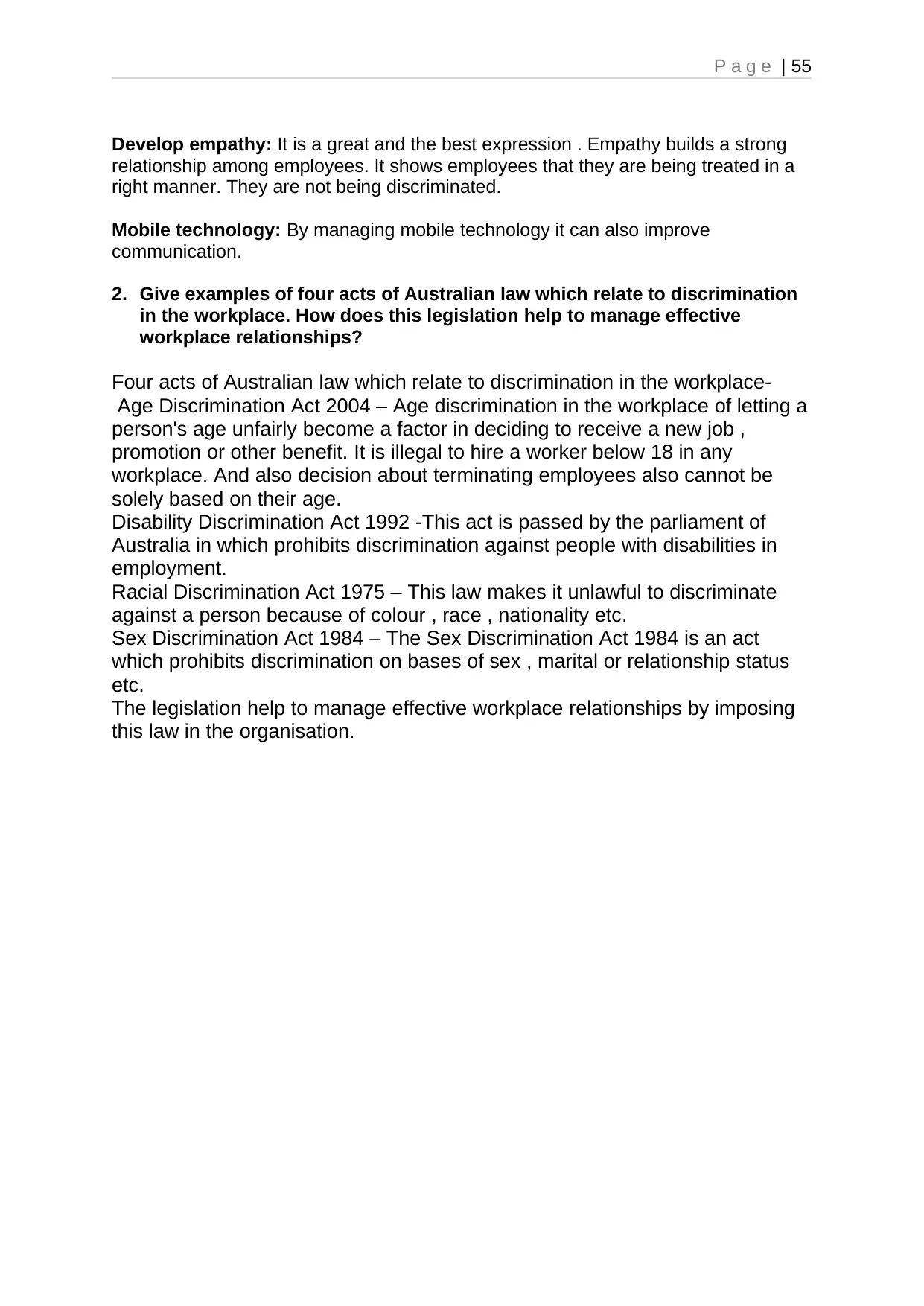
P a g e | 55
Develop empathy: It is a great and the best expression . Empathy builds a strong
relationship among employees. It shows employees that they are being treated in a
right manner. They are not being discriminated.
Mobile technology: By managing mobile technology it can also improve
communication.
2. Give examples of four acts of Australian law which relate to discrimination
in the workplace. How does this legislation help to manage effective
workplace relationships?
Four acts of Australian law which relate to discrimination in the workplace-
Age Discrimination Act 2004 – Age discrimination in the workplace of letting a
person's age unfairly become a factor in deciding to receive a new job ,
promotion or other benefit. It is illegal to hire a worker below 18 in any
workplace. And also decision about terminating employees also cannot be
solely based on their age.
Disability Discrimination Act 1992 -This act is passed by the parliament of
Australia in which prohibits discrimination against people with disabilities in
employment.
Racial Discrimination Act 1975 – This law makes it unlawful to discriminate
against a person because of colour , race , nationality etc.
Sex Discrimination Act 1984 – The Sex Discrimination Act 1984 is an act
which prohibits discrimination on bases of sex , marital or relationship status
etc.
The legislation help to manage effective workplace relationships by imposing
this law in the organisation.
Develop empathy: It is a great and the best expression . Empathy builds a strong
relationship among employees. It shows employees that they are being treated in a
right manner. They are not being discriminated.
Mobile technology: By managing mobile technology it can also improve
communication.
2. Give examples of four acts of Australian law which relate to discrimination
in the workplace. How does this legislation help to manage effective
workplace relationships?
Four acts of Australian law which relate to discrimination in the workplace-
Age Discrimination Act 2004 – Age discrimination in the workplace of letting a
person's age unfairly become a factor in deciding to receive a new job ,
promotion or other benefit. It is illegal to hire a worker below 18 in any
workplace. And also decision about terminating employees also cannot be
solely based on their age.
Disability Discrimination Act 1992 -This act is passed by the parliament of
Australia in which prohibits discrimination against people with disabilities in
employment.
Racial Discrimination Act 1975 – This law makes it unlawful to discriminate
against a person because of colour , race , nationality etc.
Sex Discrimination Act 1984 – The Sex Discrimination Act 1984 is an act
which prohibits discrimination on bases of sex , marital or relationship status
etc.
The legislation help to manage effective workplace relationships by imposing
this law in the organisation.
Paraphrase This Document
Need a fresh take? Get an instant paraphrase of this document with our AI Paraphraser
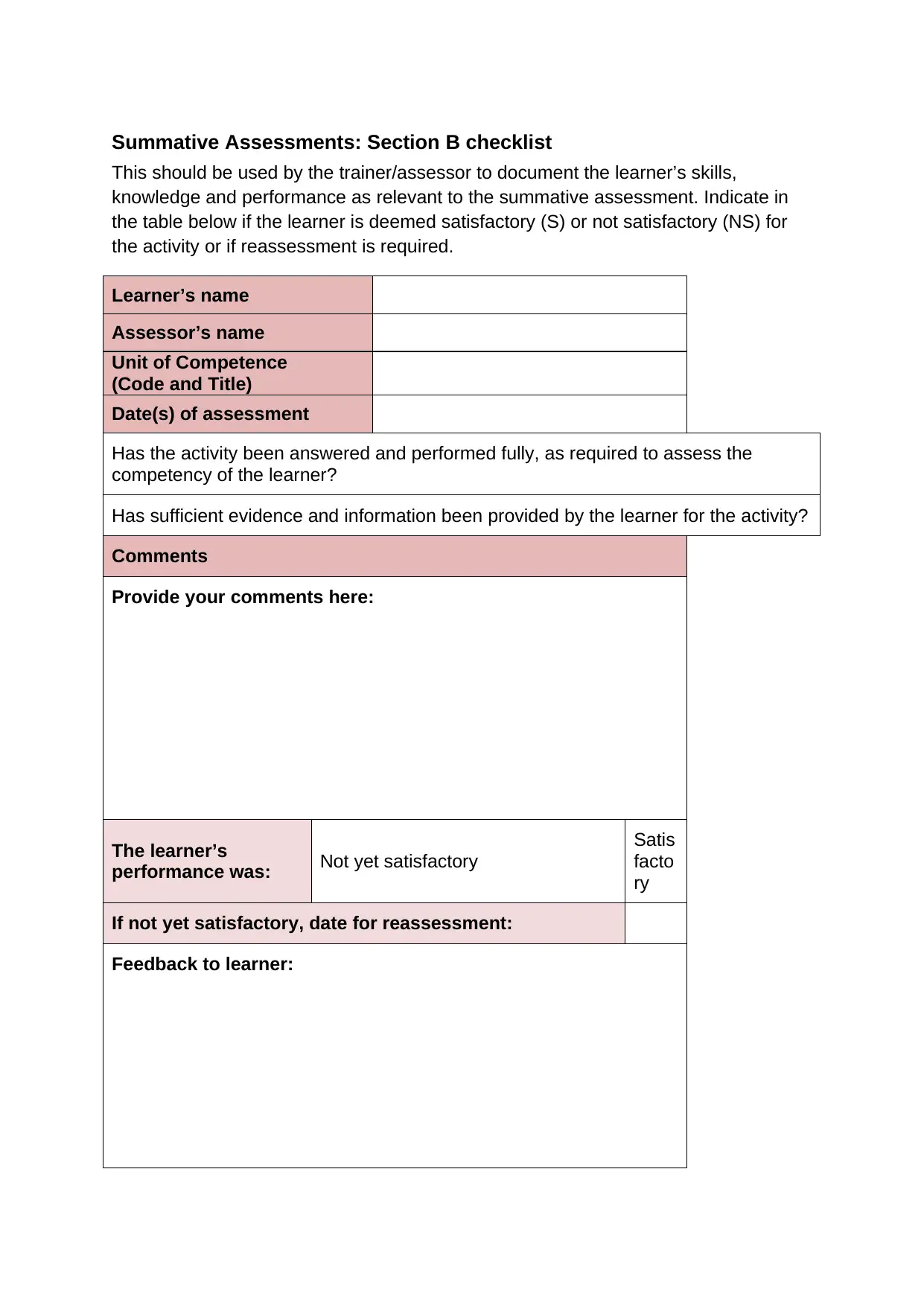
Summative Assessments: Section B checklist
This should be used by the trainer/assessor to document the learner’s skills,
knowledge and performance as relevant to the summative assessment. Indicate in
the table below if the learner is deemed satisfactory (S) or not satisfactory (NS) for
the activity or if reassessment is required.
Learner’s name
Assessor’s name
Unit of Competence
(Code and Title)
Date(s) of assessment
Has the activity been answered and performed fully, as required to assess the
competency of the learner?
Has sufficient evidence and information been provided by the learner for the activity?
Comments
Provide your comments here:
The learner’s
performance was: Not yet satisfactory
Satis
facto
ry
If not yet satisfactory, date for reassessment:
Feedback to learner:
This should be used by the trainer/assessor to document the learner’s skills,
knowledge and performance as relevant to the summative assessment. Indicate in
the table below if the learner is deemed satisfactory (S) or not satisfactory (NS) for
the activity or if reassessment is required.
Learner’s name
Assessor’s name
Unit of Competence
(Code and Title)
Date(s) of assessment
Has the activity been answered and performed fully, as required to assess the
competency of the learner?
Has sufficient evidence and information been provided by the learner for the activity?
Comments
Provide your comments here:
The learner’s
performance was: Not yet satisfactory
Satis
facto
ry
If not yet satisfactory, date for reassessment:
Feedback to learner:
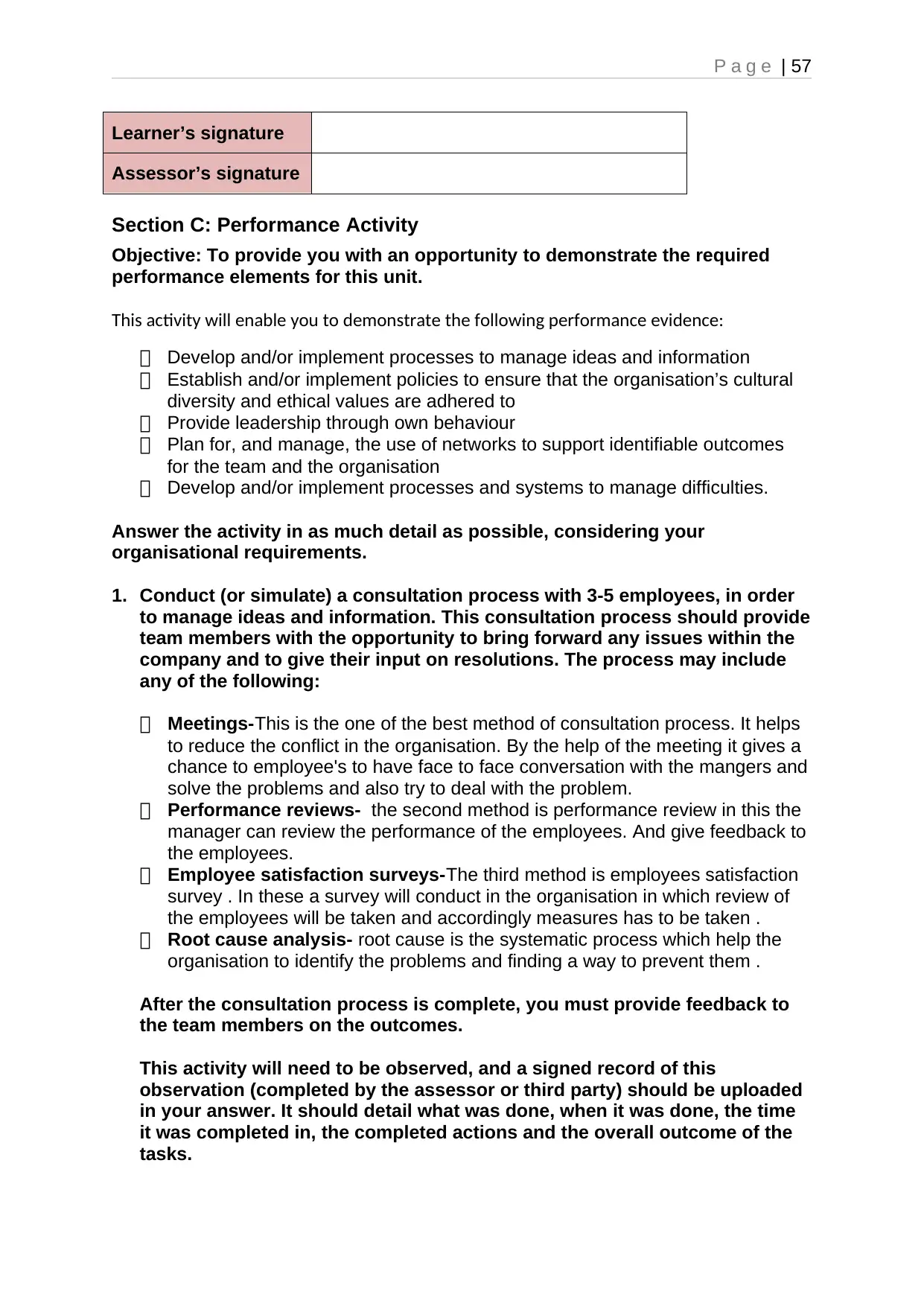
P a g e | 57
Learner’s signature
Assessor’s signature
Section C: Performance Activity
Objective: To provide you with an opportunity to demonstrate the required
performance elements for this unit.
This activity will enable you to demonstrate the following performance evidence:
Develop and/or implement processes to manage ideas and information
Establish and/or implement policies to ensure that the organisation’s cultural
diversity and ethical values are adhered to
Provide leadership through own behaviour
Plan for, and manage, the use of networks to support identifiable outcomes
for the team and the organisation
Develop and/or implement processes and systems to manage difficulties.
Answer the activity in as much detail as possible, considering your
organisational requirements.
1. Conduct (or simulate) a consultation process with 3-5 employees, in order
to manage ideas and information. This consultation process should provide
team members with the opportunity to bring forward any issues within the
company and to give their input on resolutions. The process may include
any of the following:
Meetings-This is the one of the best method of consultation process. It helps
to reduce the conflict in the organisation. By the help of the meeting it gives a
chance to employee's to have face to face conversation with the mangers and
solve the problems and also try to deal with the problem.
Performance reviews- the second method is performance review in this the
manager can review the performance of the employees. And give feedback to
the employees.
Employee satisfaction surveys-The third method is employees satisfaction
survey . In these a survey will conduct in the organisation in which review of
the employees will be taken and accordingly measures has to be taken .
Root cause analysis- root cause is the systematic process which help the
organisation to identify the problems and finding a way to prevent them .
After the consultation process is complete, you must provide feedback to
the team members on the outcomes.
This activity will need to be observed, and a signed record of this
observation (completed by the assessor or third party) should be uploaded
in your answer. It should detail what was done, when it was done, the time
it was completed in, the completed actions and the overall outcome of the
tasks.
Learner’s signature
Assessor’s signature
Section C: Performance Activity
Objective: To provide you with an opportunity to demonstrate the required
performance elements for this unit.
This activity will enable you to demonstrate the following performance evidence:
Develop and/or implement processes to manage ideas and information
Establish and/or implement policies to ensure that the organisation’s cultural
diversity and ethical values are adhered to
Provide leadership through own behaviour
Plan for, and manage, the use of networks to support identifiable outcomes
for the team and the organisation
Develop and/or implement processes and systems to manage difficulties.
Answer the activity in as much detail as possible, considering your
organisational requirements.
1. Conduct (or simulate) a consultation process with 3-5 employees, in order
to manage ideas and information. This consultation process should provide
team members with the opportunity to bring forward any issues within the
company and to give their input on resolutions. The process may include
any of the following:
Meetings-This is the one of the best method of consultation process. It helps
to reduce the conflict in the organisation. By the help of the meeting it gives a
chance to employee's to have face to face conversation with the mangers and
solve the problems and also try to deal with the problem.
Performance reviews- the second method is performance review in this the
manager can review the performance of the employees. And give feedback to
the employees.
Employee satisfaction surveys-The third method is employees satisfaction
survey . In these a survey will conduct in the organisation in which review of
the employees will be taken and accordingly measures has to be taken .
Root cause analysis- root cause is the systematic process which help the
organisation to identify the problems and finding a way to prevent them .
After the consultation process is complete, you must provide feedback to
the team members on the outcomes.
This activity will need to be observed, and a signed record of this
observation (completed by the assessor or third party) should be uploaded
in your answer. It should detail what was done, when it was done, the time
it was completed in, the completed actions and the overall outcome of the
tasks.
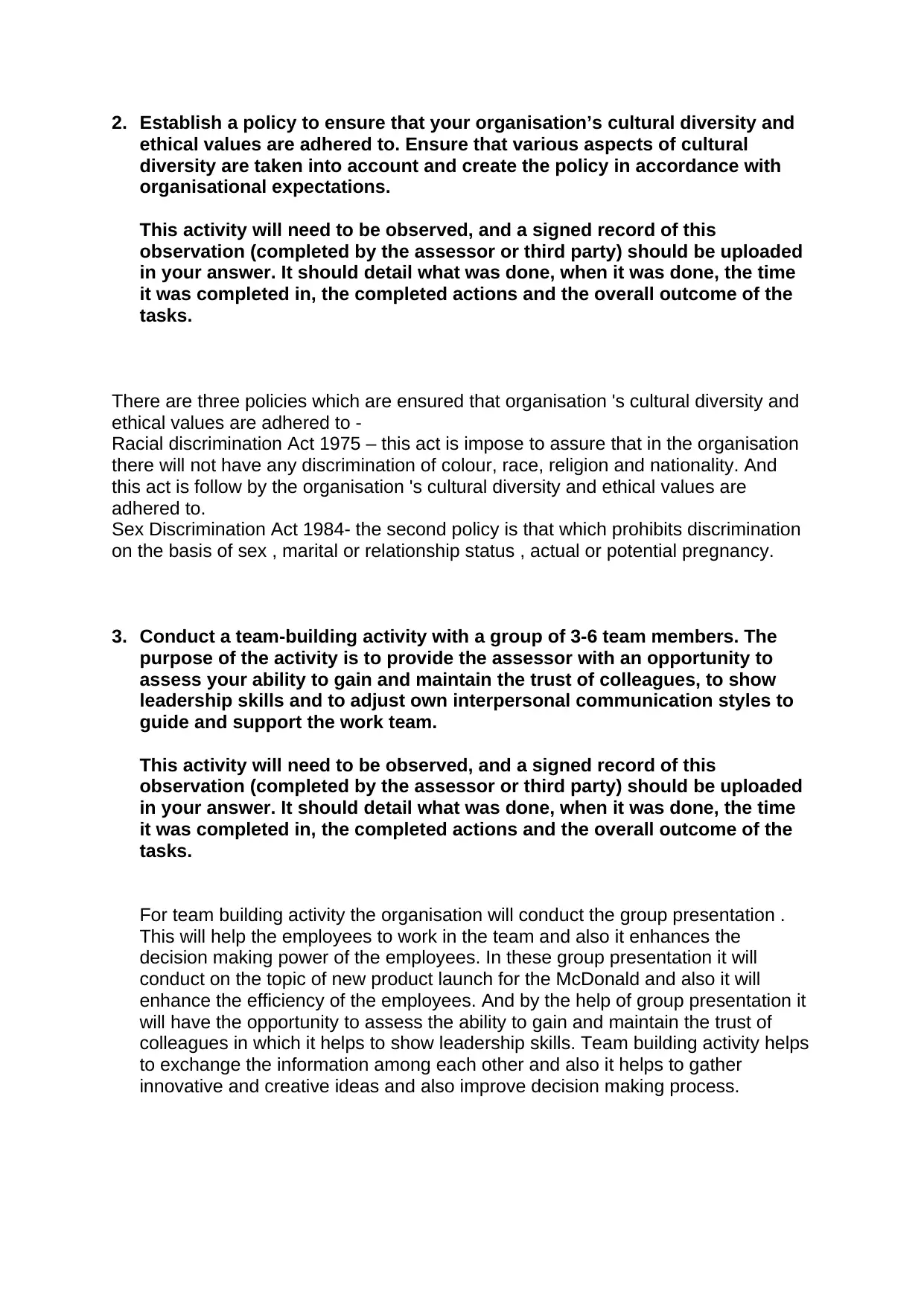
2. Establish a policy to ensure that your organisation’s cultural diversity and
ethical values are adhered to. Ensure that various aspects of cultural
diversity are taken into account and create the policy in accordance with
organisational expectations.
This activity will need to be observed, and a signed record of this
observation (completed by the assessor or third party) should be uploaded
in your answer. It should detail what was done, when it was done, the time
it was completed in, the completed actions and the overall outcome of the
tasks.
There are three policies which are ensured that organisation 's cultural diversity and
ethical values are adhered to -
Racial discrimination Act 1975 – this act is impose to assure that in the organisation
there will not have any discrimination of colour, race, religion and nationality. And
this act is follow by the organisation 's cultural diversity and ethical values are
adhered to.
Sex Discrimination Act 1984- the second policy is that which prohibits discrimination
on the basis of sex , marital or relationship status , actual or potential pregnancy.
3. Conduct a team-building activity with a group of 3-6 team members. The
purpose of the activity is to provide the assessor with an opportunity to
assess your ability to gain and maintain the trust of colleagues, to show
leadership skills and to adjust own interpersonal communication styles to
guide and support the work team.
This activity will need to be observed, and a signed record of this
observation (completed by the assessor or third party) should be uploaded
in your answer. It should detail what was done, when it was done, the time
it was completed in, the completed actions and the overall outcome of the
tasks.
For team building activity the organisation will conduct the group presentation .
This will help the employees to work in the team and also it enhances the
decision making power of the employees. In these group presentation it will
conduct on the topic of new product launch for the McDonald and also it will
enhance the efficiency of the employees. And by the help of group presentation it
will have the opportunity to assess the ability to gain and maintain the trust of
colleagues in which it helps to show leadership skills. Team building activity helps
to exchange the information among each other and also it helps to gather
innovative and creative ideas and also improve decision making process.
ethical values are adhered to. Ensure that various aspects of cultural
diversity are taken into account and create the policy in accordance with
organisational expectations.
This activity will need to be observed, and a signed record of this
observation (completed by the assessor or third party) should be uploaded
in your answer. It should detail what was done, when it was done, the time
it was completed in, the completed actions and the overall outcome of the
tasks.
There are three policies which are ensured that organisation 's cultural diversity and
ethical values are adhered to -
Racial discrimination Act 1975 – this act is impose to assure that in the organisation
there will not have any discrimination of colour, race, religion and nationality. And
this act is follow by the organisation 's cultural diversity and ethical values are
adhered to.
Sex Discrimination Act 1984- the second policy is that which prohibits discrimination
on the basis of sex , marital or relationship status , actual or potential pregnancy.
3. Conduct a team-building activity with a group of 3-6 team members. The
purpose of the activity is to provide the assessor with an opportunity to
assess your ability to gain and maintain the trust of colleagues, to show
leadership skills and to adjust own interpersonal communication styles to
guide and support the work team.
This activity will need to be observed, and a signed record of this
observation (completed by the assessor or third party) should be uploaded
in your answer. It should detail what was done, when it was done, the time
it was completed in, the completed actions and the overall outcome of the
tasks.
For team building activity the organisation will conduct the group presentation .
This will help the employees to work in the team and also it enhances the
decision making power of the employees. In these group presentation it will
conduct on the topic of new product launch for the McDonald and also it will
enhance the efficiency of the employees. And by the help of group presentation it
will have the opportunity to assess the ability to gain and maintain the trust of
colleagues in which it helps to show leadership skills. Team building activity helps
to exchange the information among each other and also it helps to gather
innovative and creative ideas and also improve decision making process.
Secure Best Marks with AI Grader
Need help grading? Try our AI Grader for instant feedback on your assignments.
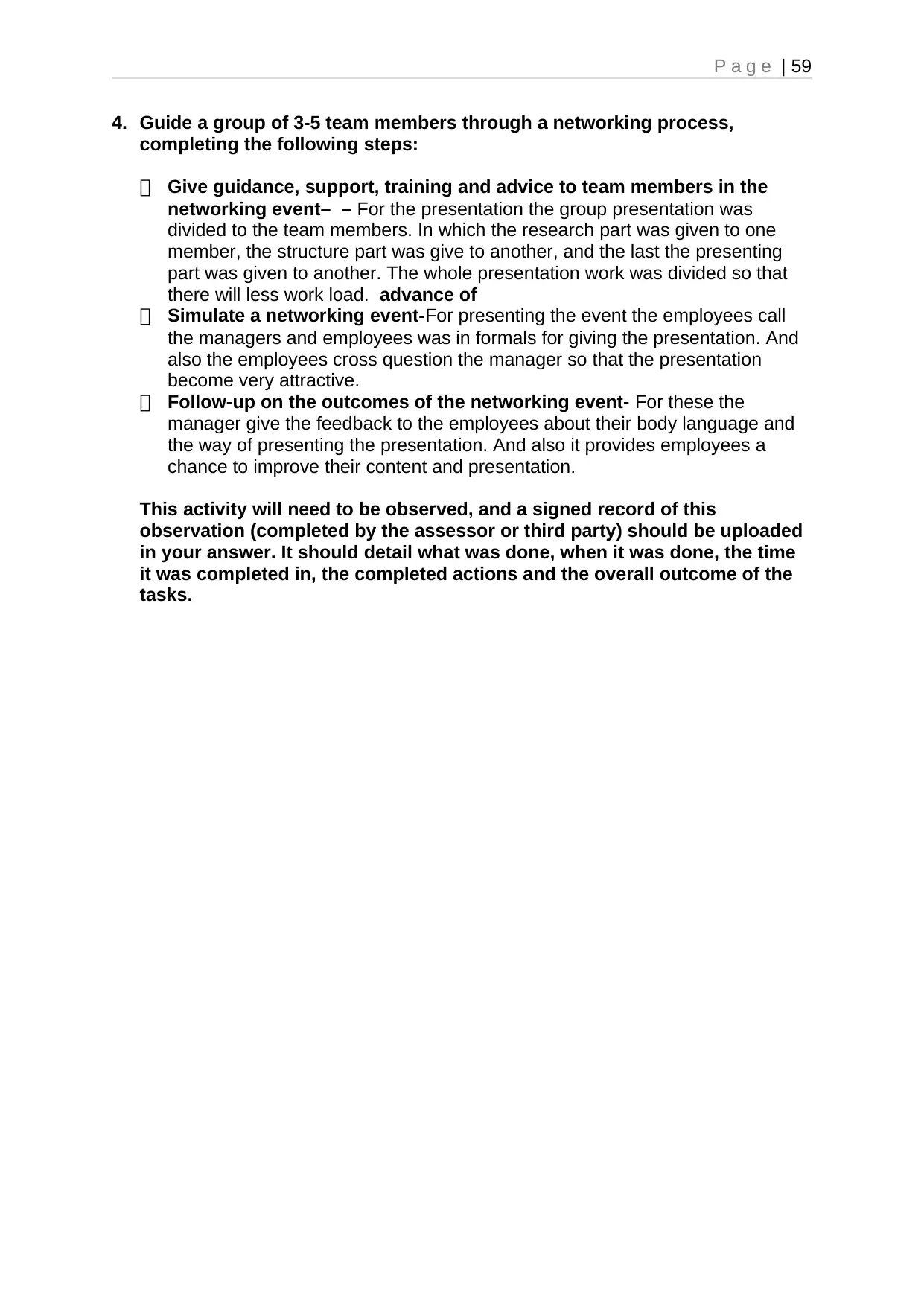
P a g e | 59
4. Guide a group of 3-5 team members through a networking process,
completing the following steps:
Give guidance, support, training and advice to team members in the
networking event– – For the presentation the group presentation was
divided to the team members. In which the research part was given to one
member, the structure part was give to another, and the last the presenting
part was given to another. The whole presentation work was divided so that
there will less work load. advance of
Simulate a networking event-For presenting the event the employees call
the managers and employees was in formals for giving the presentation. And
also the employees cross question the manager so that the presentation
become very attractive.
Follow-up on the outcomes of the networking event- For these the
manager give the feedback to the employees about their body language and
the way of presenting the presentation. And also it provides employees a
chance to improve their content and presentation.
This activity will need to be observed, and a signed record of this
observation (completed by the assessor or third party) should be uploaded
in your answer. It should detail what was done, when it was done, the time
it was completed in, the completed actions and the overall outcome of the
tasks.
4. Guide a group of 3-5 team members through a networking process,
completing the following steps:
Give guidance, support, training and advice to team members in the
networking event– – For the presentation the group presentation was
divided to the team members. In which the research part was given to one
member, the structure part was give to another, and the last the presenting
part was given to another. The whole presentation work was divided so that
there will less work load. advance of
Simulate a networking event-For presenting the event the employees call
the managers and employees was in formals for giving the presentation. And
also the employees cross question the manager so that the presentation
become very attractive.
Follow-up on the outcomes of the networking event- For these the
manager give the feedback to the employees about their body language and
the way of presenting the presentation. And also it provides employees a
chance to improve their content and presentation.
This activity will need to be observed, and a signed record of this
observation (completed by the assessor or third party) should be uploaded
in your answer. It should detail what was done, when it was done, the time
it was completed in, the completed actions and the overall outcome of the
tasks.
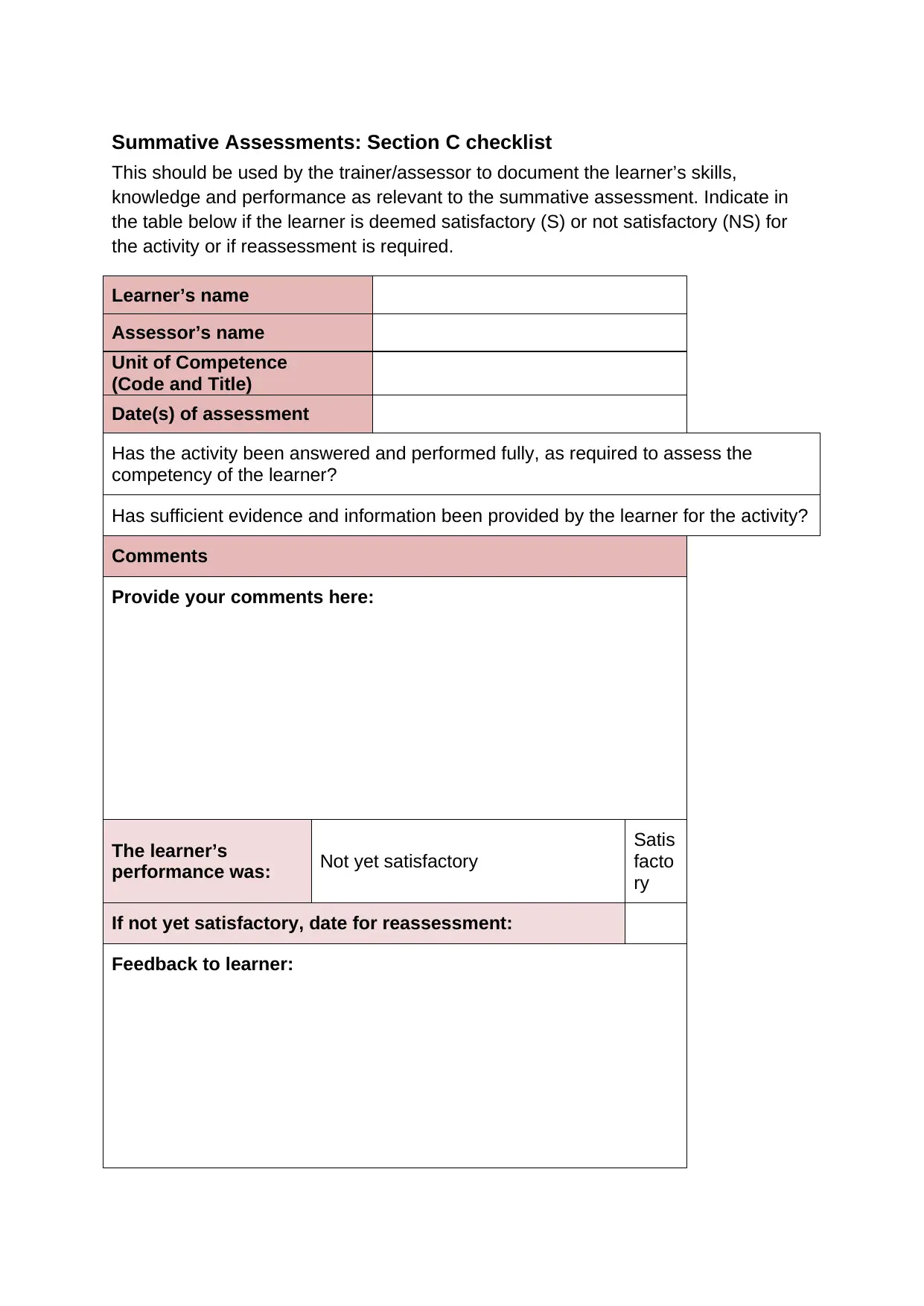
Summative Assessments: Section C checklist
This should be used by the trainer/assessor to document the learner’s skills,
knowledge and performance as relevant to the summative assessment. Indicate in
the table below if the learner is deemed satisfactory (S) or not satisfactory (NS) for
the activity or if reassessment is required.
Learner’s name
Assessor’s name
Unit of Competence
(Code and Title)
Date(s) of assessment
Has the activity been answered and performed fully, as required to assess the
competency of the learner?
Has sufficient evidence and information been provided by the learner for the activity?
Comments
Provide your comments here:
The learner’s
performance was: Not yet satisfactory
Satis
facto
ry
If not yet satisfactory, date for reassessment:
Feedback to learner:
This should be used by the trainer/assessor to document the learner’s skills,
knowledge and performance as relevant to the summative assessment. Indicate in
the table below if the learner is deemed satisfactory (S) or not satisfactory (NS) for
the activity or if reassessment is required.
Learner’s name
Assessor’s name
Unit of Competence
(Code and Title)
Date(s) of assessment
Has the activity been answered and performed fully, as required to assess the
competency of the learner?
Has sufficient evidence and information been provided by the learner for the activity?
Comments
Provide your comments here:
The learner’s
performance was: Not yet satisfactory
Satis
facto
ry
If not yet satisfactory, date for reassessment:
Feedback to learner:
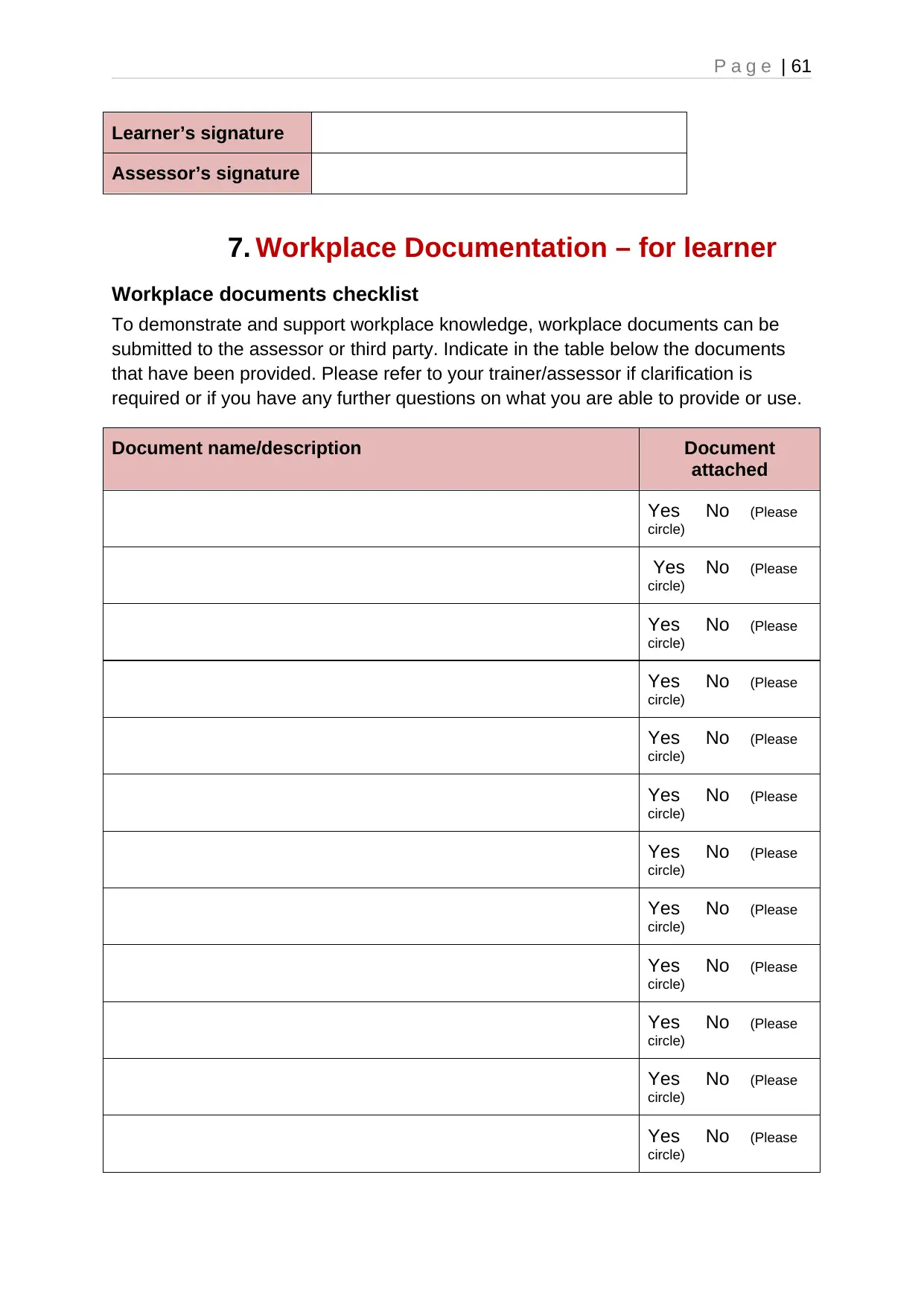
P a g e | 61
Learner’s signature
Assessor’s signature
7. Workplace Documentation – for learner
Workplace documents checklist
To demonstrate and support workplace knowledge, workplace documents can be
submitted to the assessor or third party. Indicate in the table below the documents
that have been provided. Please refer to your trainer/assessor if clarification is
required or if you have any further questions on what you are able to provide or use.
Document name/description Document
attached
Yes No (Please
circle)
Yes No (Please
circle)
Yes No (Please
circle)
Yes No (Please
circle)
Yes No (Please
circle)
Yes No (Please
circle)
Yes No (Please
circle)
Yes No (Please
circle)
Yes No (Please
circle)
Yes No (Please
circle)
Yes No (Please
circle)
Yes No (Please
circle)
Learner’s signature
Assessor’s signature
7. Workplace Documentation – for learner
Workplace documents checklist
To demonstrate and support workplace knowledge, workplace documents can be
submitted to the assessor or third party. Indicate in the table below the documents
that have been provided. Please refer to your trainer/assessor if clarification is
required or if you have any further questions on what you are able to provide or use.
Document name/description Document
attached
Yes No (Please
circle)
Yes No (Please
circle)
Yes No (Please
circle)
Yes No (Please
circle)
Yes No (Please
circle)
Yes No (Please
circle)
Yes No (Please
circle)
Yes No (Please
circle)
Yes No (Please
circle)
Yes No (Please
circle)
Yes No (Please
circle)
Yes No (Please
circle)
Paraphrase This Document
Need a fresh take? Get an instant paraphrase of this document with our AI Paraphraser
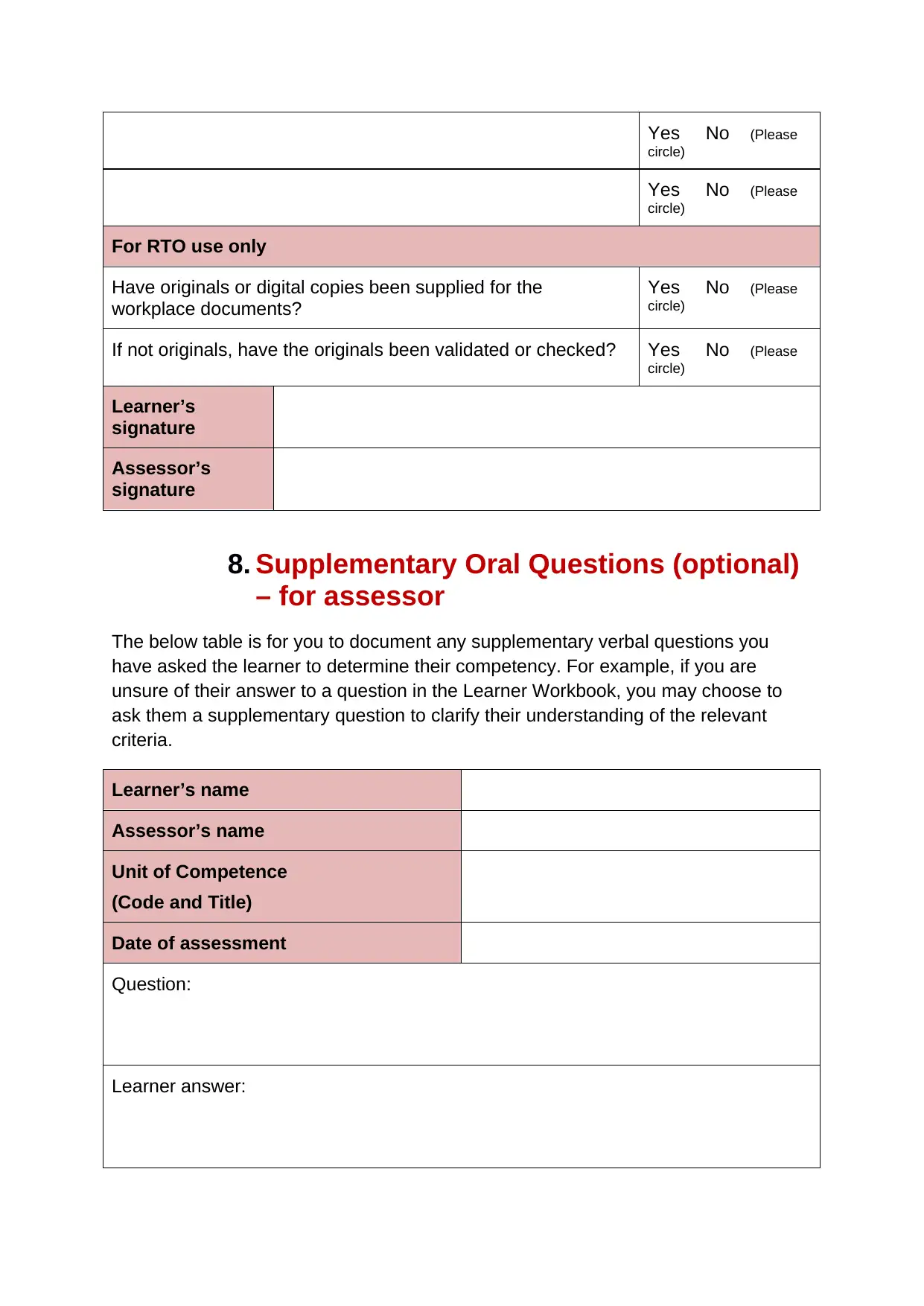
Yes No (Please
circle)
Yes No (Please
circle)
For RTO use only
Have originals or digital copies been supplied for the
workplace documents?
Yes No (Please
circle)
If not originals, have the originals been validated or checked? Yes No (Please
circle)
Learner’s
signature
Assessor’s
signature
8. Supplementary Oral Questions (optional)
– for assessor
The below table is for you to document any supplementary verbal questions you
have asked the learner to determine their competency. For example, if you are
unsure of their answer to a question in the Learner Workbook, you may choose to
ask them a supplementary question to clarify their understanding of the relevant
criteria.
Learner’s name
Assessor’s name
Unit of Competence
(Code and Title)
Date of assessment
Question:
Learner answer:
circle)
Yes No (Please
circle)
For RTO use only
Have originals or digital copies been supplied for the
workplace documents?
Yes No (Please
circle)
If not originals, have the originals been validated or checked? Yes No (Please
circle)
Learner’s
signature
Assessor’s
signature
8. Supplementary Oral Questions (optional)
– for assessor
The below table is for you to document any supplementary verbal questions you
have asked the learner to determine their competency. For example, if you are
unsure of their answer to a question in the Learner Workbook, you may choose to
ask them a supplementary question to clarify their understanding of the relevant
criteria.
Learner’s name
Assessor’s name
Unit of Competence
(Code and Title)
Date of assessment
Question:
Learner answer:
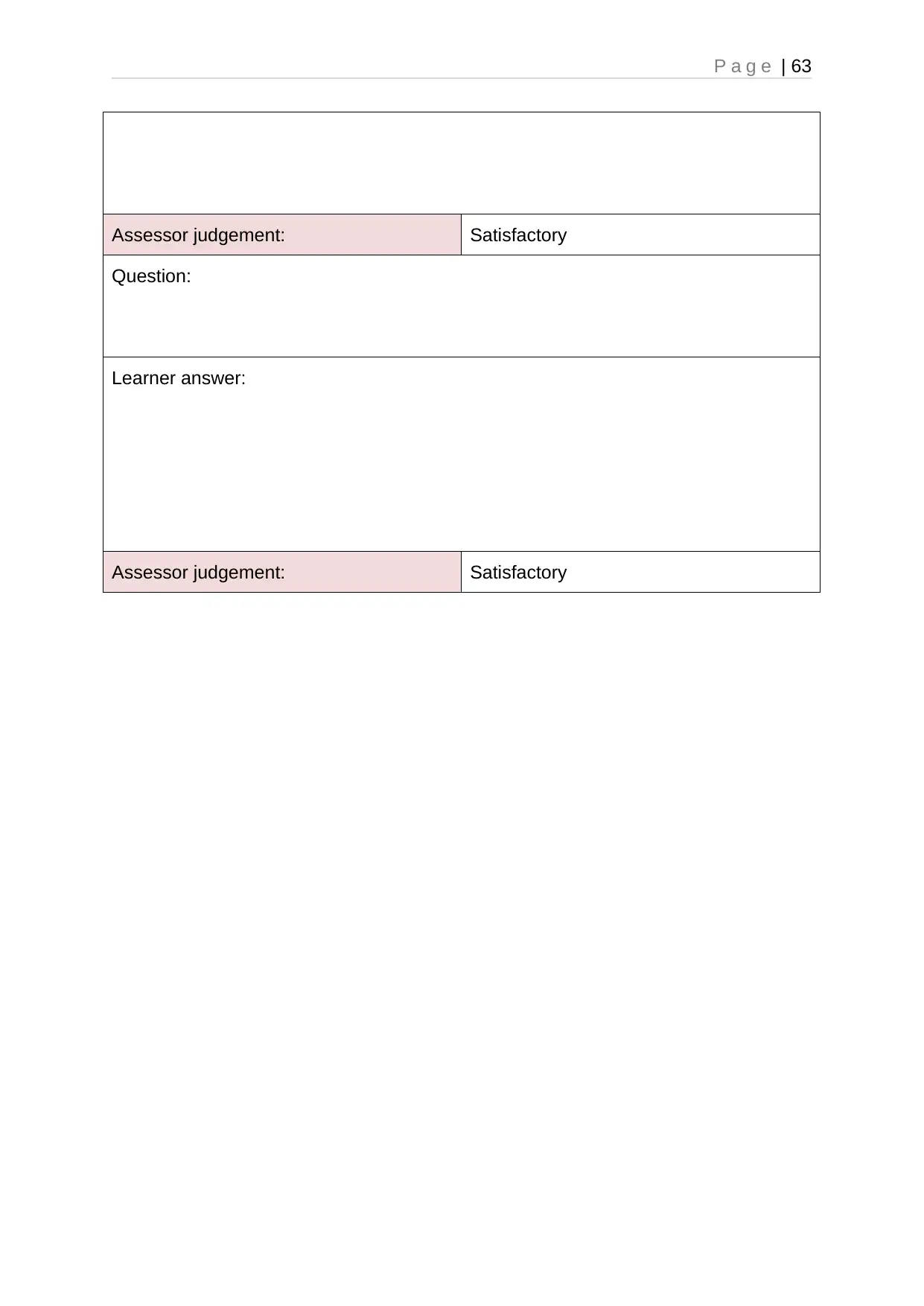
P a g e | 63
Assessor judgement: Satisfactory
Question:
Learner answer:
Assessor judgement: Satisfactory
Assessor judgement: Satisfactory
Question:
Learner answer:
Assessor judgement: Satisfactory
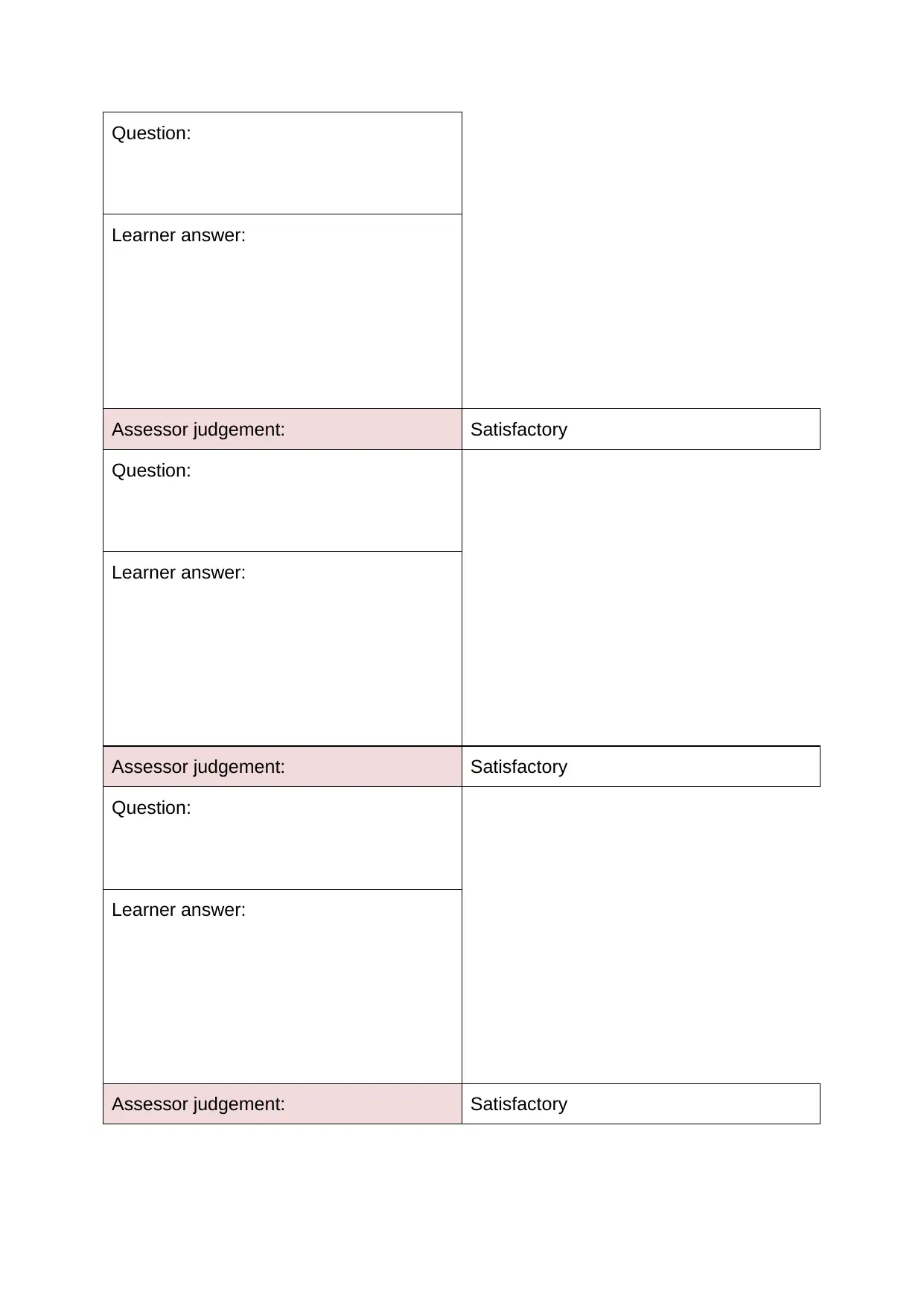
Question:
Learner answer:
Assessor judgement: Satisfactory
Question:
Learner answer:
Assessor judgement: Satisfactory
Question:
Learner answer:
Assessor judgement: Satisfactory
Learner answer:
Assessor judgement: Satisfactory
Question:
Learner answer:
Assessor judgement: Satisfactory
Question:
Learner answer:
Assessor judgement: Satisfactory
Secure Best Marks with AI Grader
Need help grading? Try our AI Grader for instant feedback on your assignments.
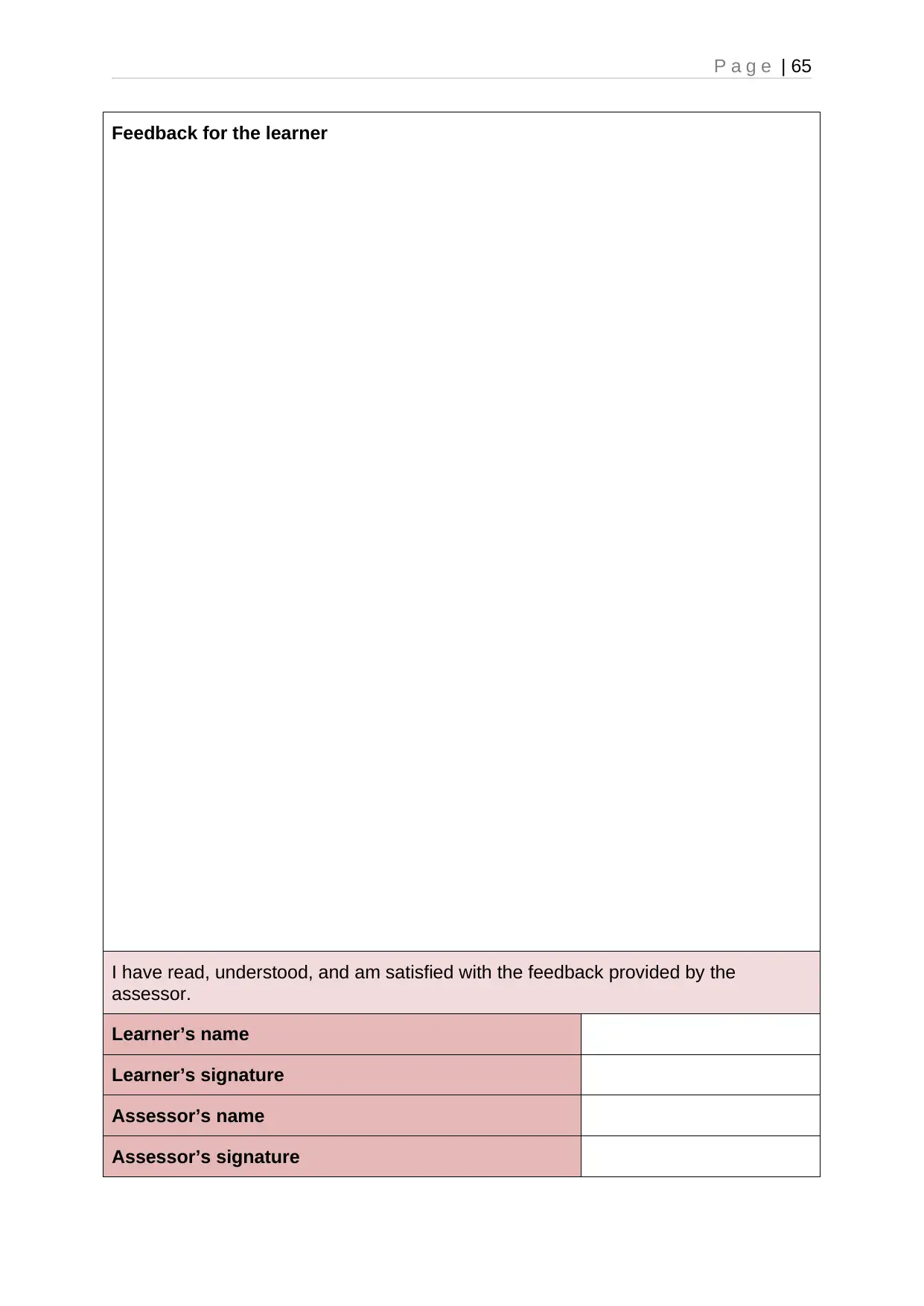
P a g e | 65
Feedback for the learner
I have read, understood, and am satisfied with the feedback provided by the
assessor.
Learner’s name
Learner’s signature
Assessor’s name
Assessor’s signature
Feedback for the learner
I have read, understood, and am satisfied with the feedback provided by the
assessor.
Learner’s name
Learner’s signature
Assessor’s name
Assessor’s signature

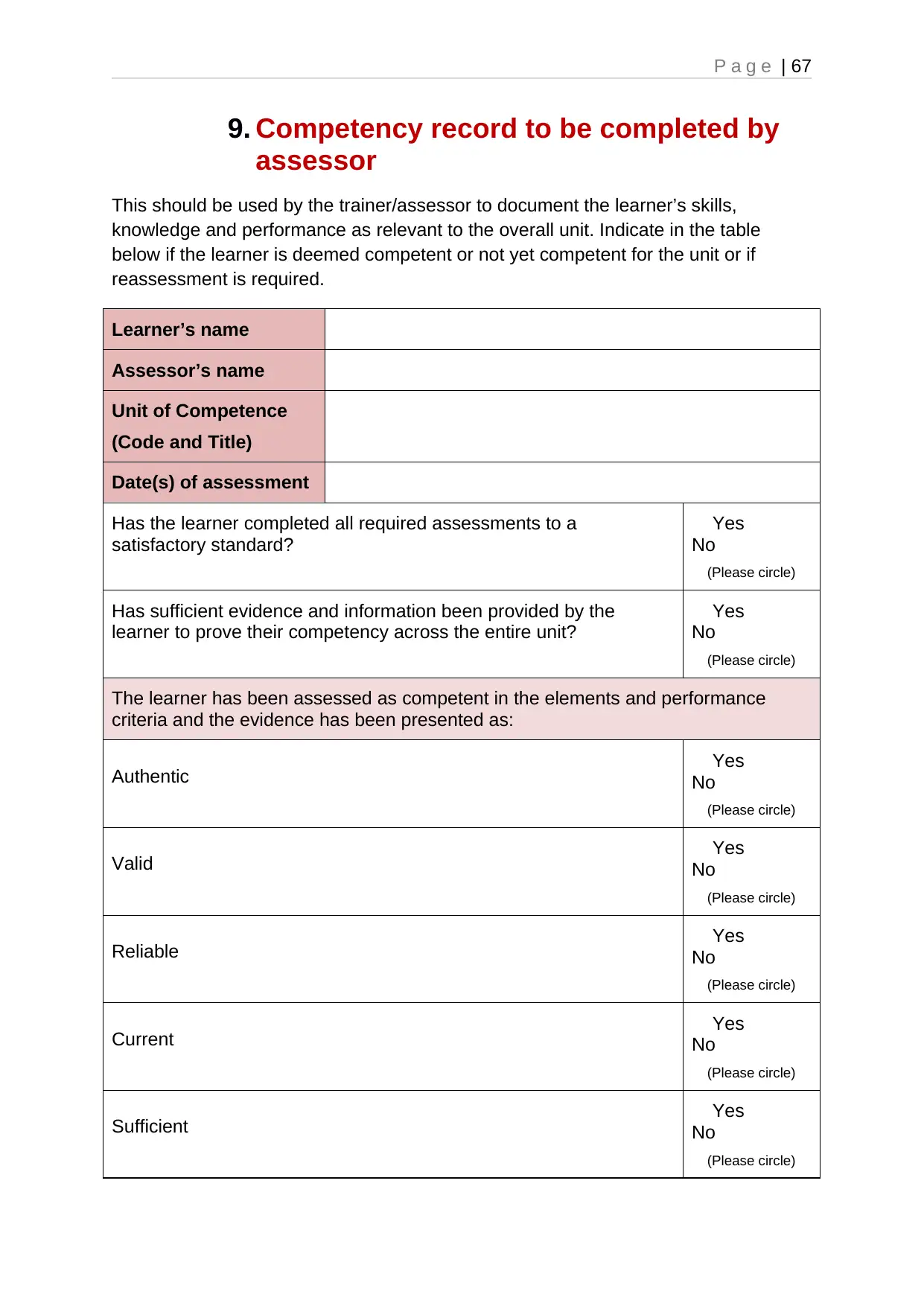
P a g e | 67
9. Competency record to be completed by
assessor
This should be used by the trainer/assessor to document the learner’s skills,
knowledge and performance as relevant to the overall unit. Indicate in the table
below if the learner is deemed competent or not yet competent for the unit or if
reassessment is required.
Learner’s name
Assessor’s name
Unit of Competence
(Code and Title)
Date(s) of assessment
Has the learner completed all required assessments to a
satisfactory standard?
Yes
No
(Please circle)
Has sufficient evidence and information been provided by the
learner to prove their competency across the entire unit?
Yes
No
(Please circle)
The learner has been assessed as competent in the elements and performance
criteria and the evidence has been presented as:
Authentic Yes
No
(Please circle)
Valid Yes
No
(Please circle)
Reliable Yes
No
(Please circle)
Current Yes
No
(Please circle)
Sufficient Yes
No
(Please circle)
9. Competency record to be completed by
assessor
This should be used by the trainer/assessor to document the learner’s skills,
knowledge and performance as relevant to the overall unit. Indicate in the table
below if the learner is deemed competent or not yet competent for the unit or if
reassessment is required.
Learner’s name
Assessor’s name
Unit of Competence
(Code and Title)
Date(s) of assessment
Has the learner completed all required assessments to a
satisfactory standard?
Yes
No
(Please circle)
Has sufficient evidence and information been provided by the
learner to prove their competency across the entire unit?
Yes
No
(Please circle)
The learner has been assessed as competent in the elements and performance
criteria and the evidence has been presented as:
Authentic Yes
No
(Please circle)
Valid Yes
No
(Please circle)
Reliable Yes
No
(Please circle)
Current Yes
No
(Please circle)
Sufficient Yes
No
(Please circle)
Paraphrase This Document
Need a fresh take? Get an instant paraphrase of this document with our AI Paraphraser

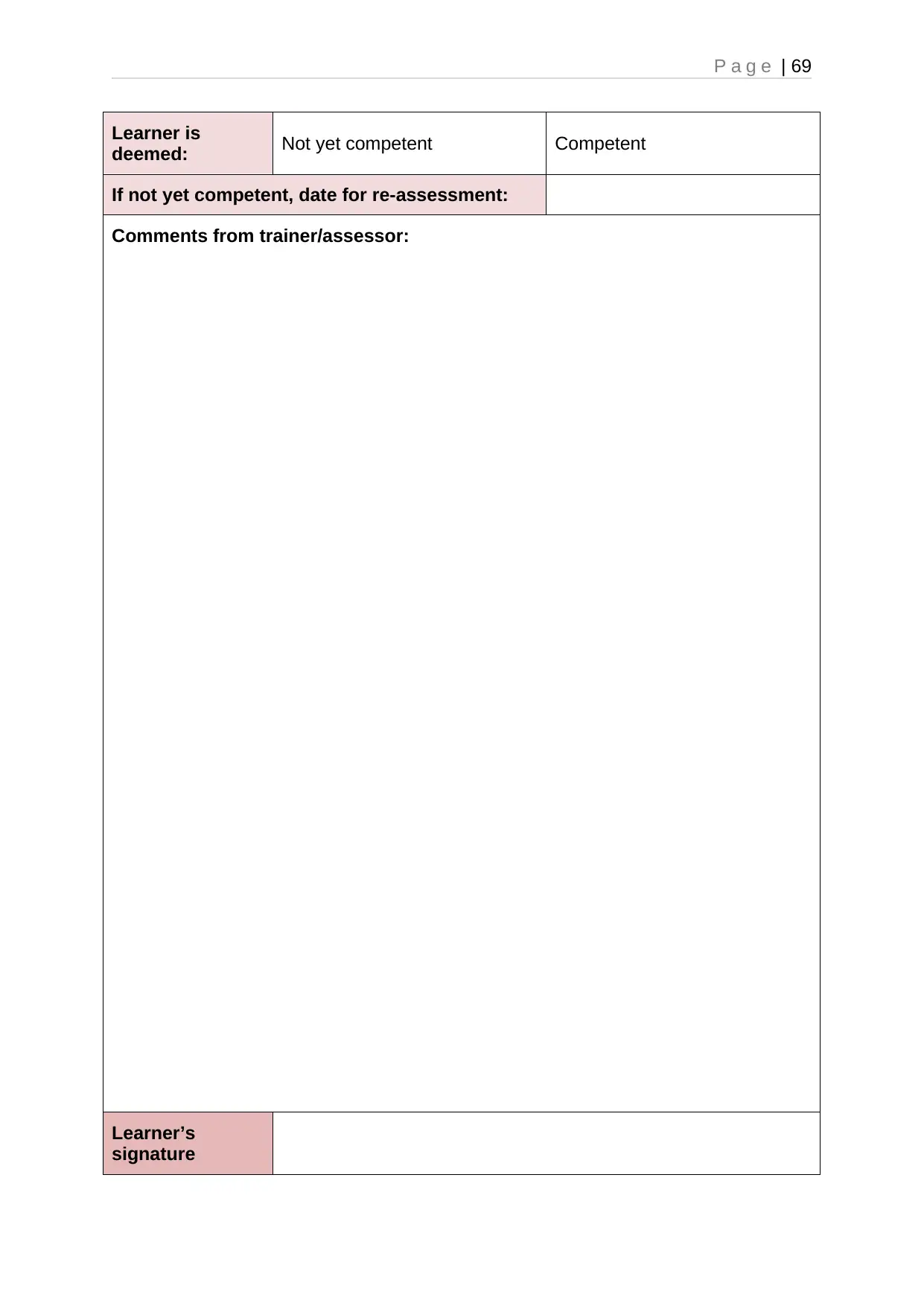
P a g e | 69
Learner is
deemed: Not yet competent Competent
If not yet competent, date for re-assessment:
Comments from trainer/assessor:
Learner’s
signature
Learner is
deemed: Not yet competent Competent
If not yet competent, date for re-assessment:
Comments from trainer/assessor:
Learner’s
signature

Assessor’s
signature
signature
1 out of 70
Related Documents
Your All-in-One AI-Powered Toolkit for Academic Success.
+13062052269
info@desklib.com
Available 24*7 on WhatsApp / Email
![[object Object]](/_next/static/media/star-bottom.7253800d.svg)
Unlock your academic potential
© 2024 | Zucol Services PVT LTD | All rights reserved.





